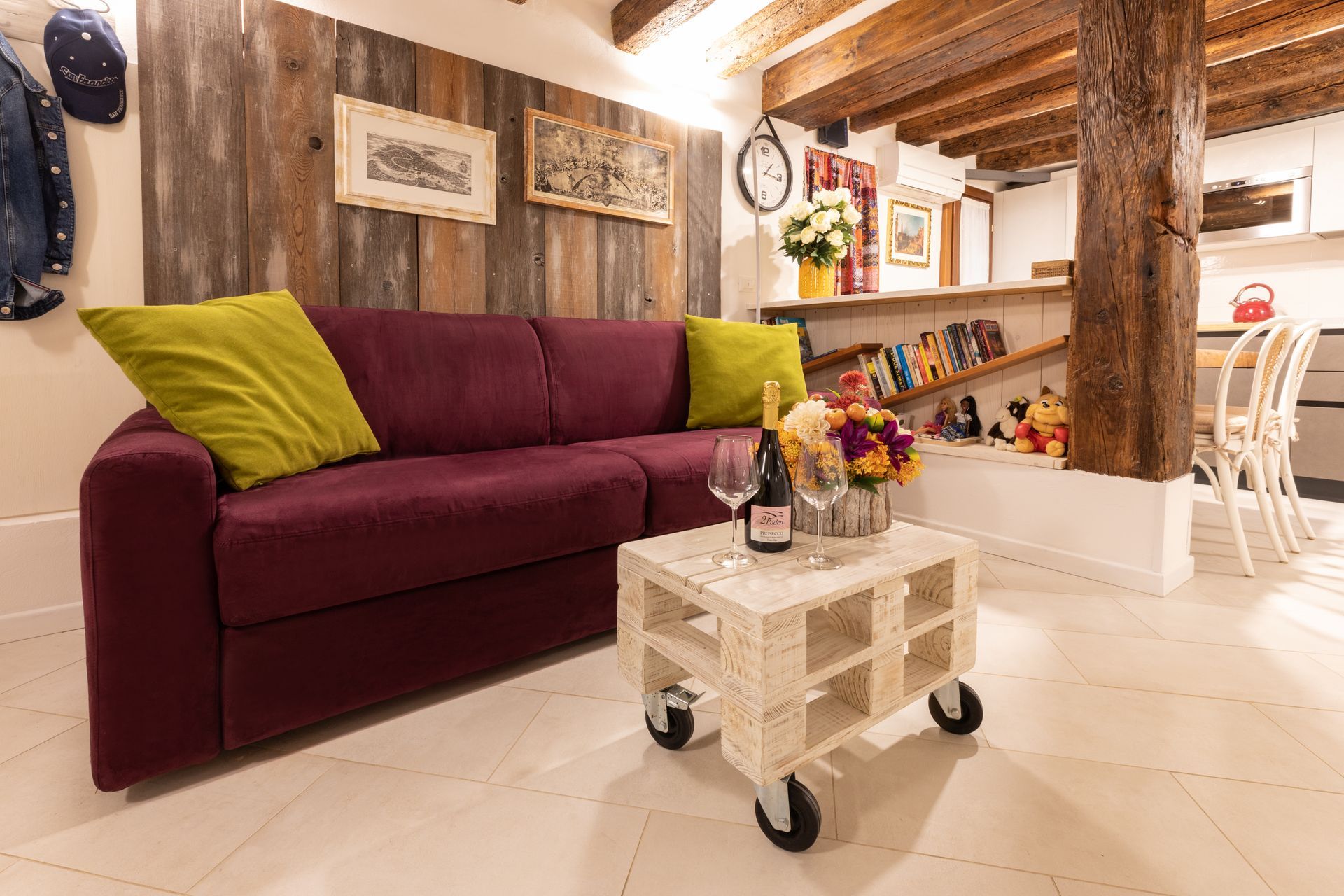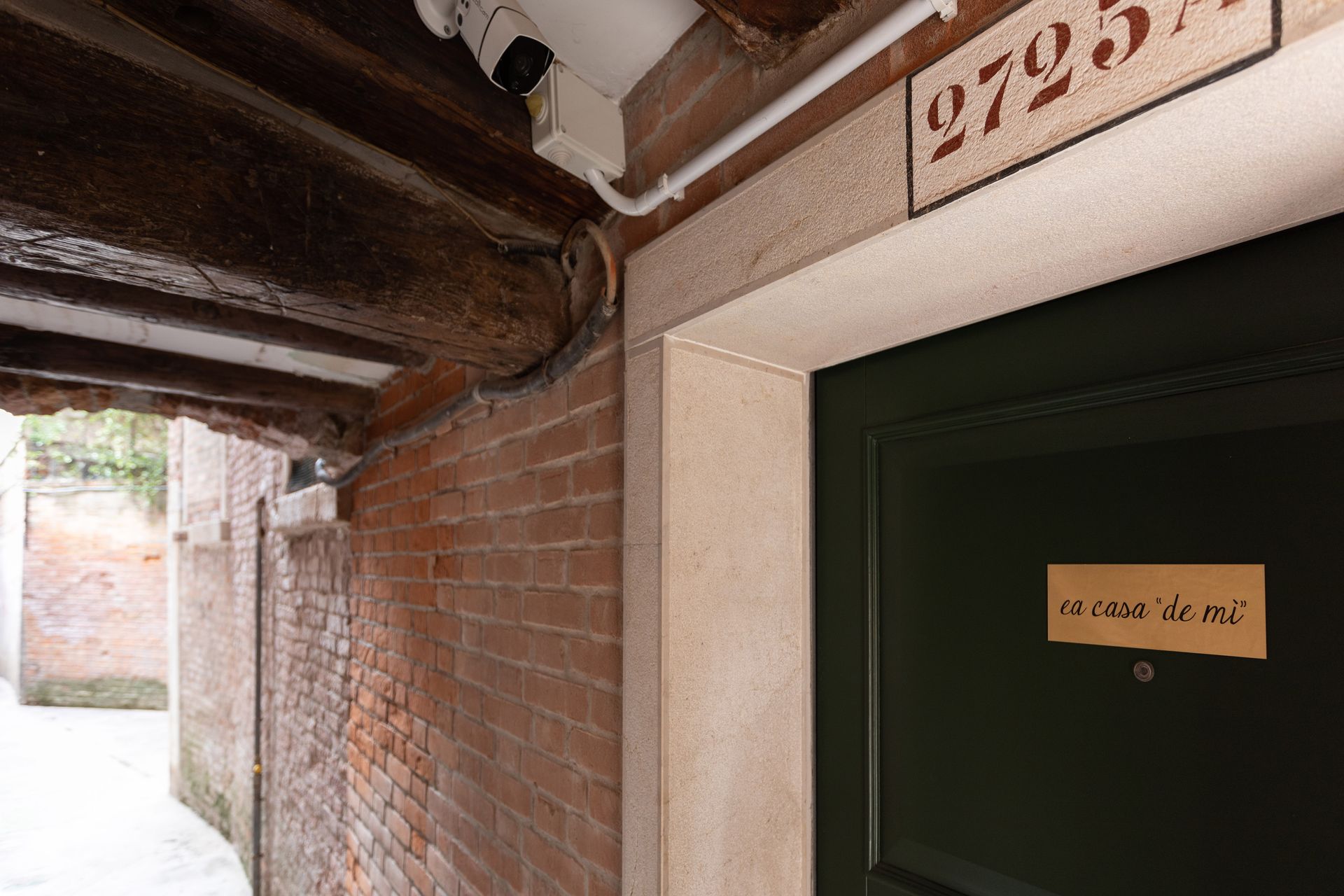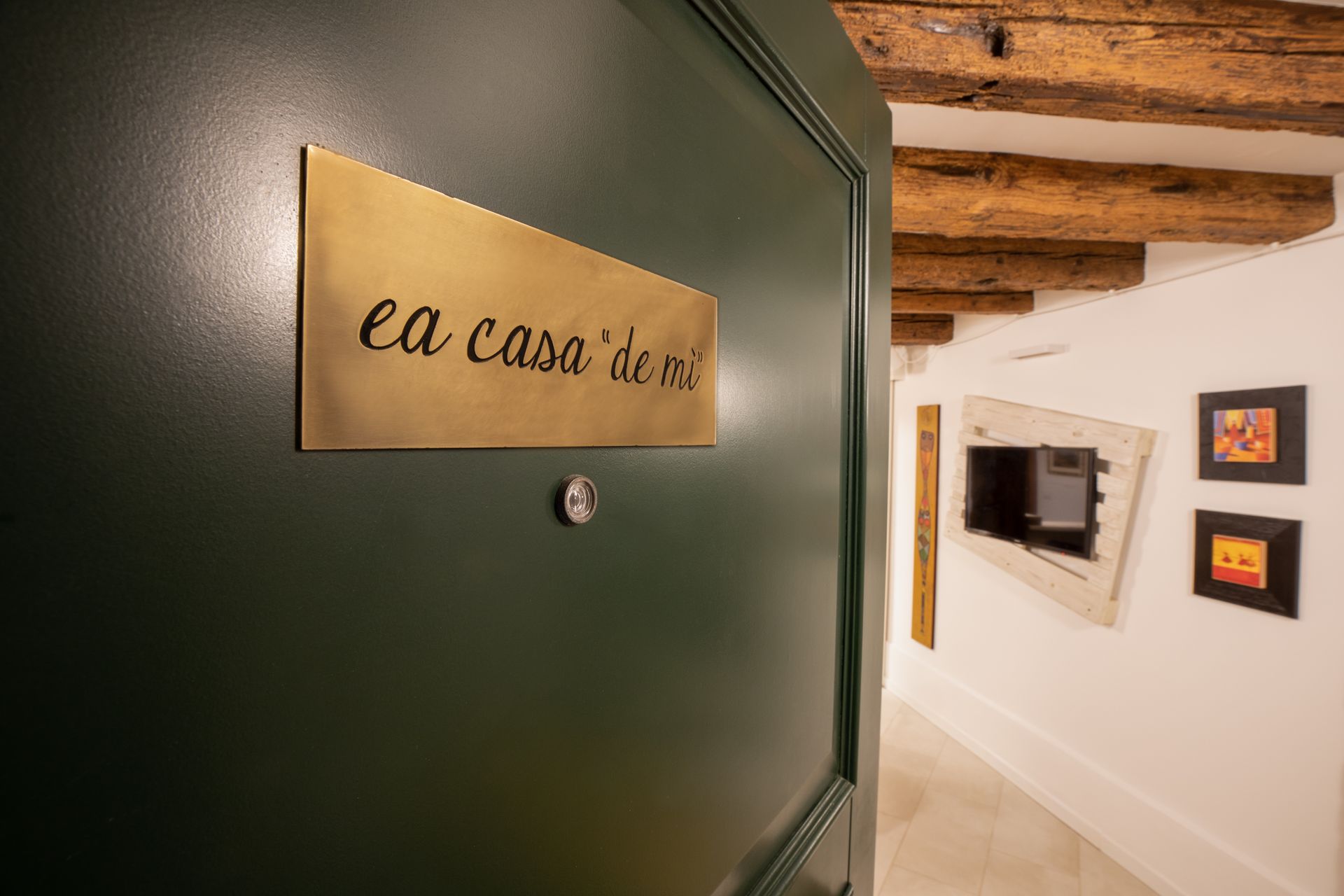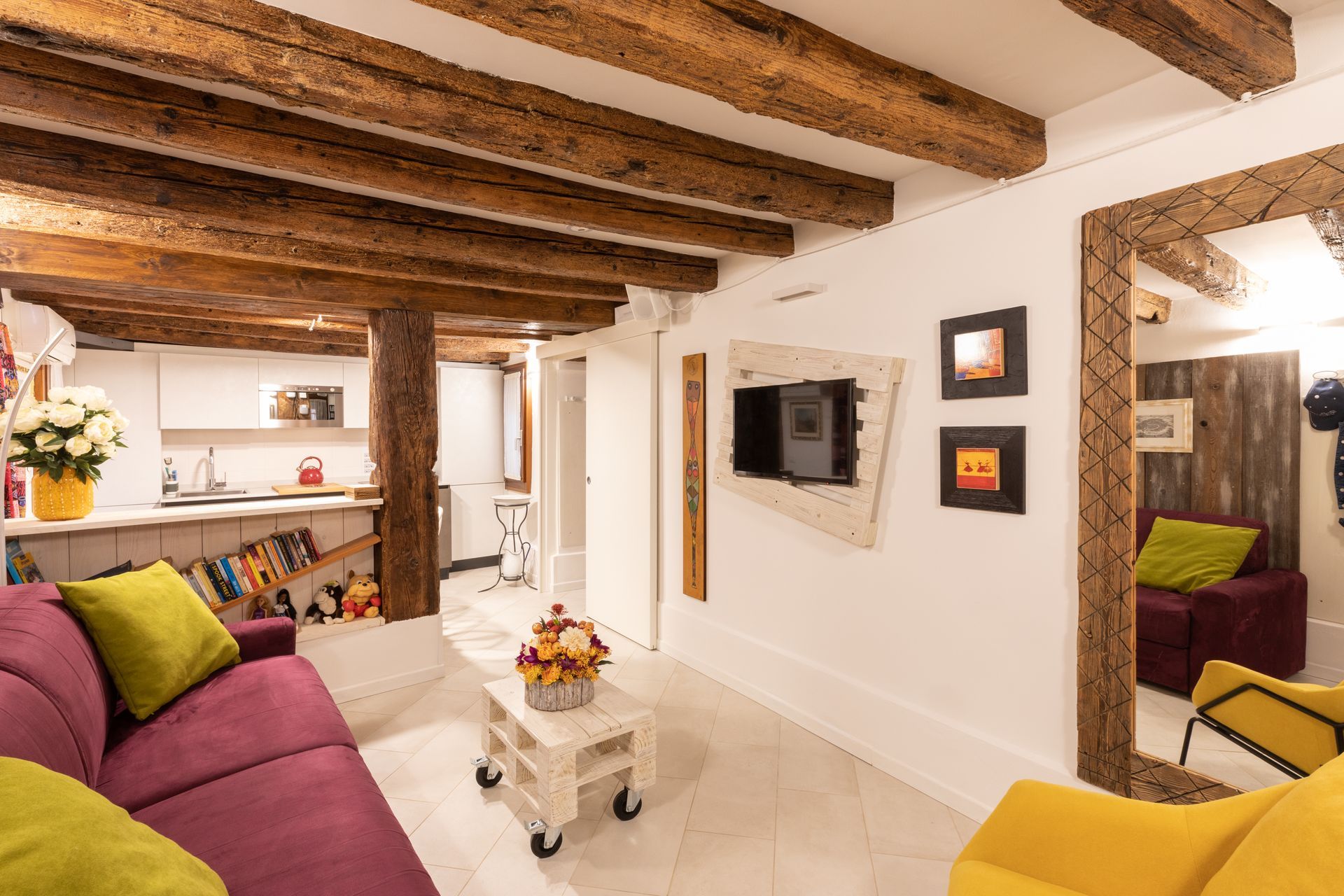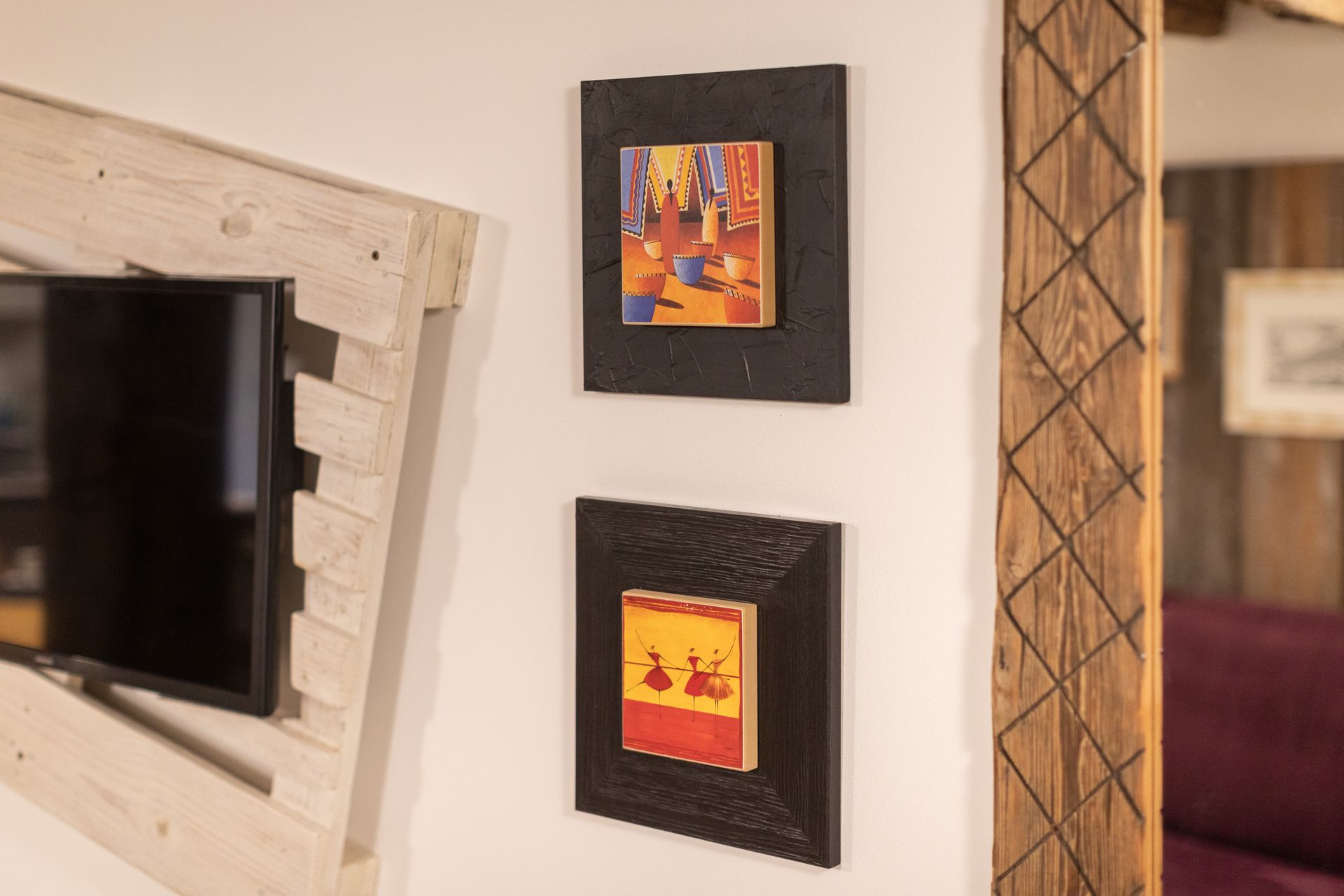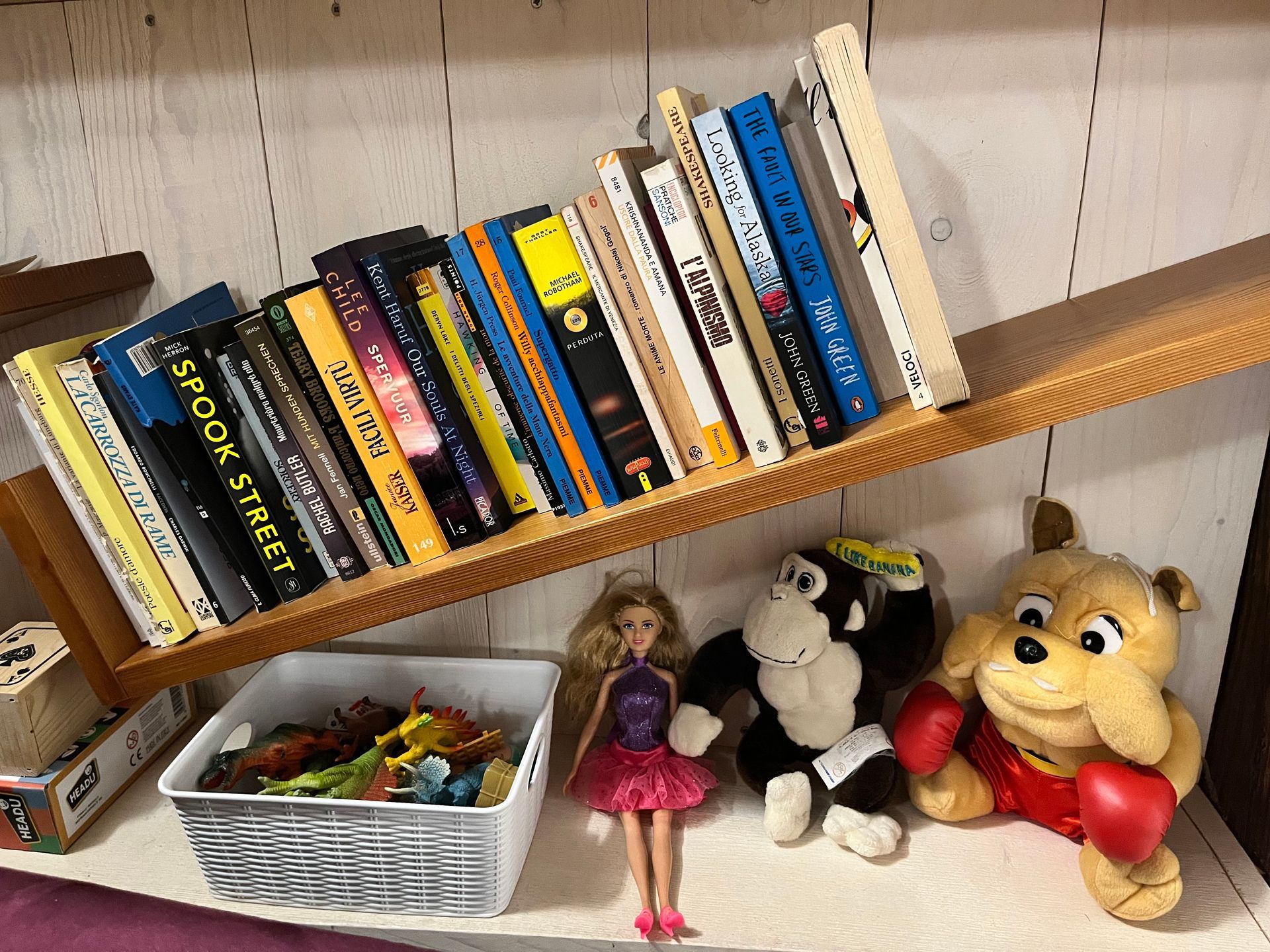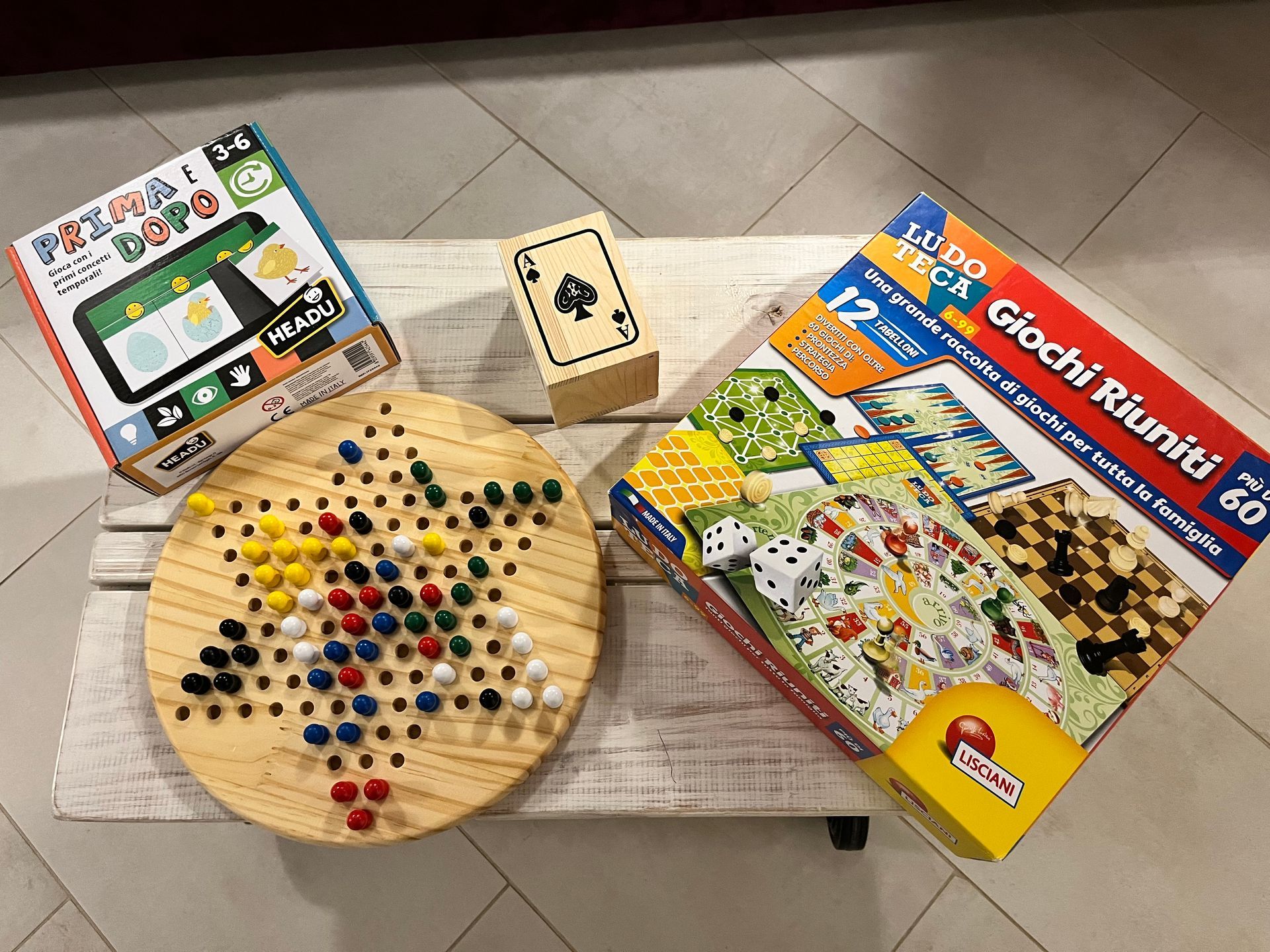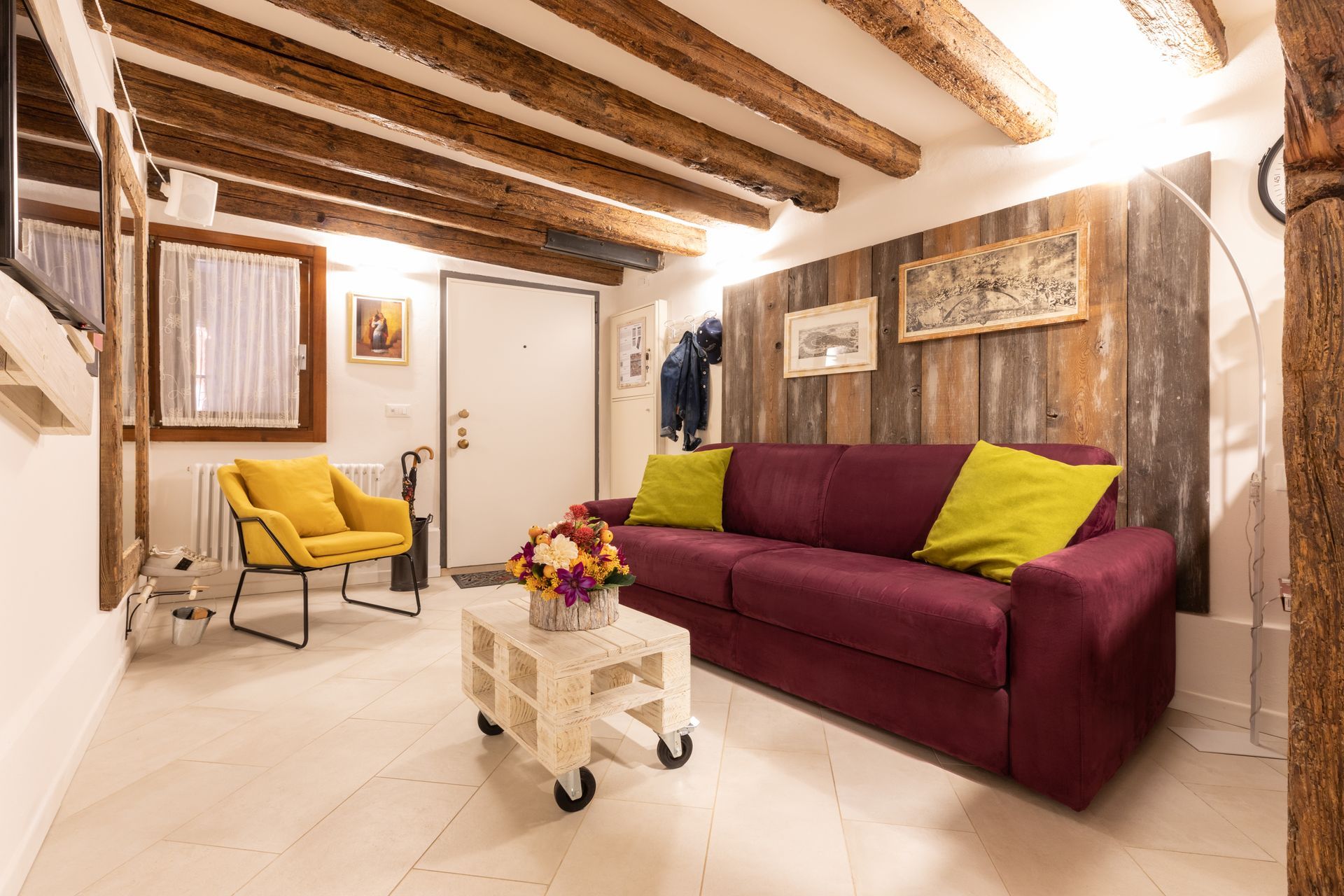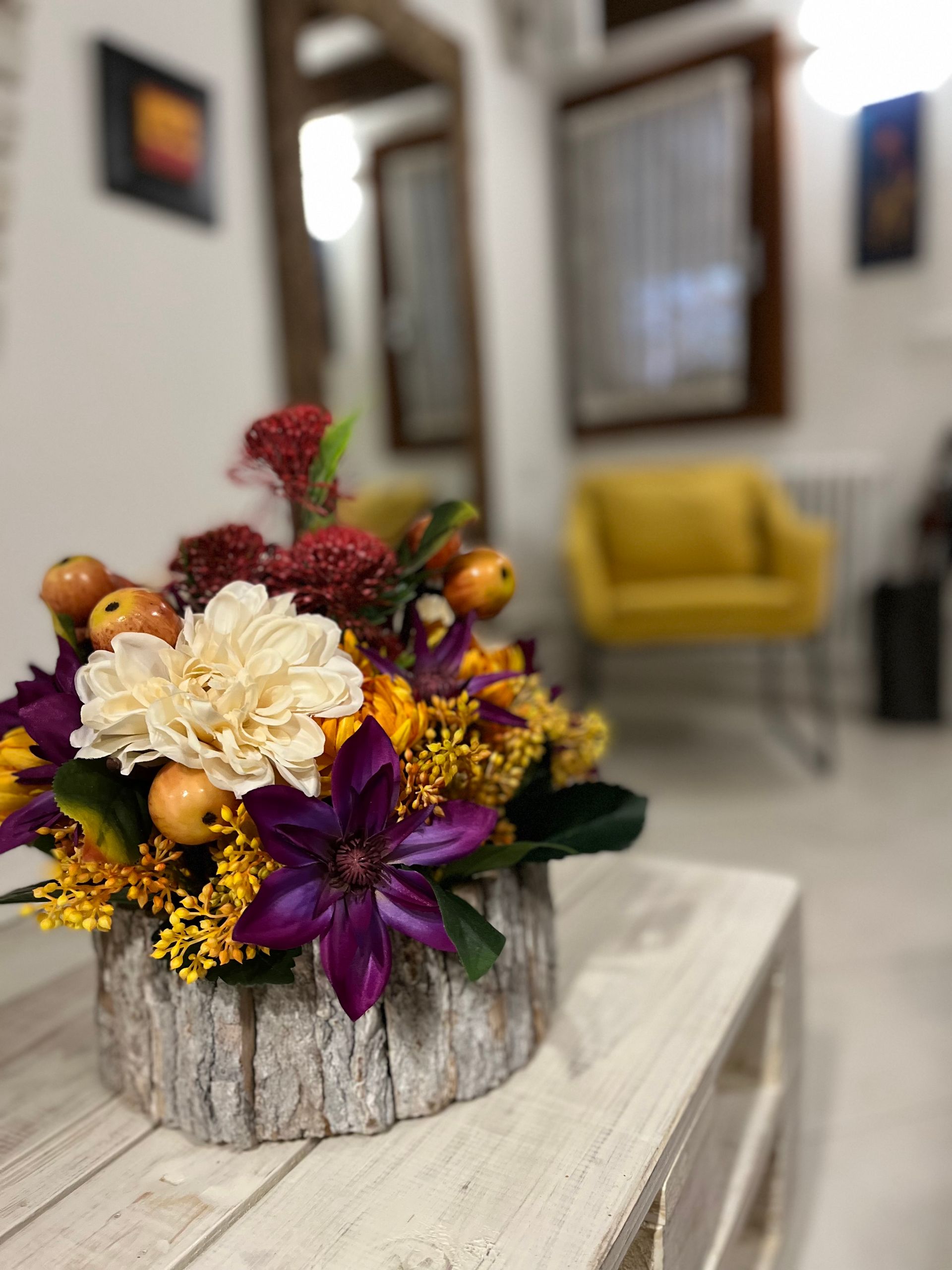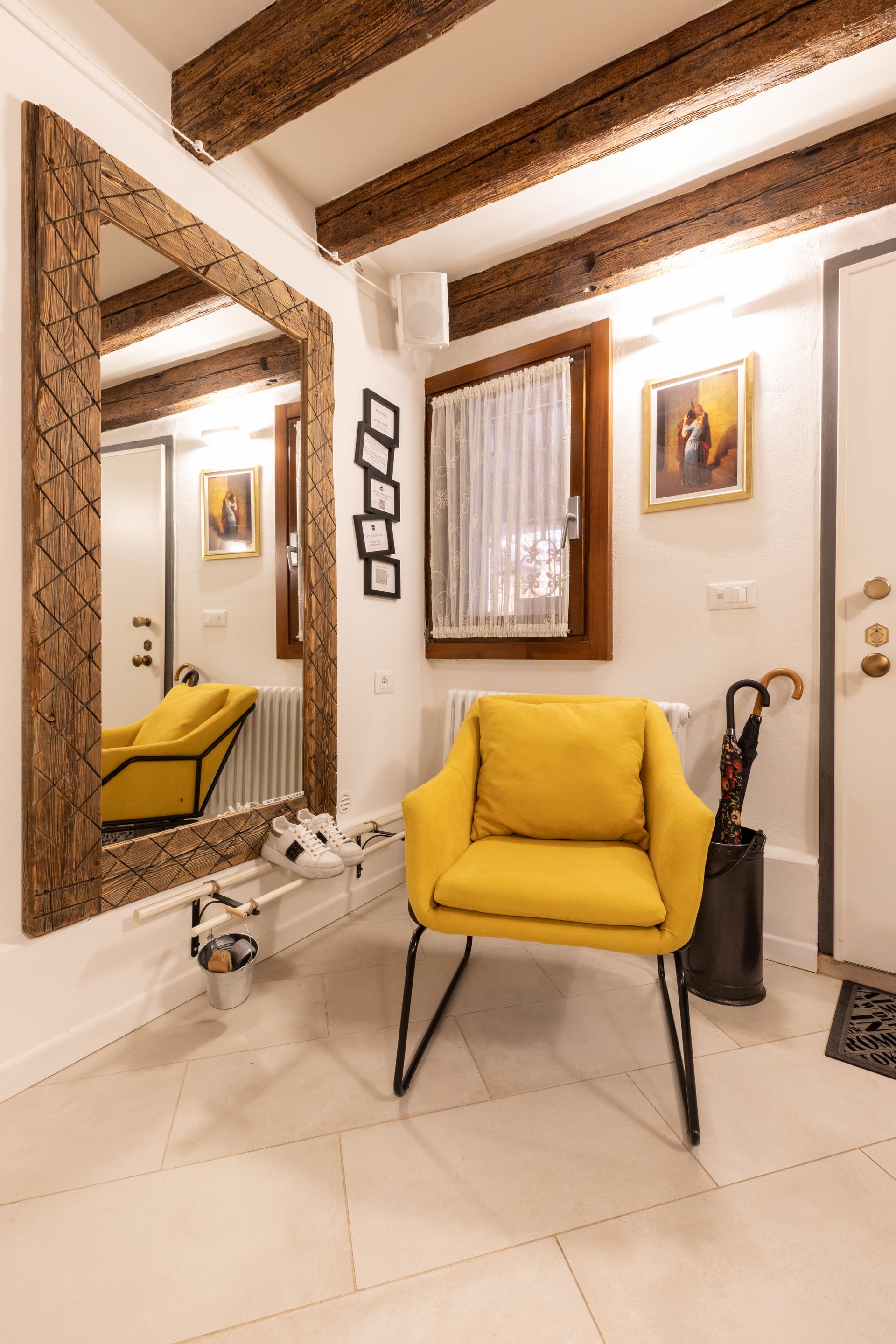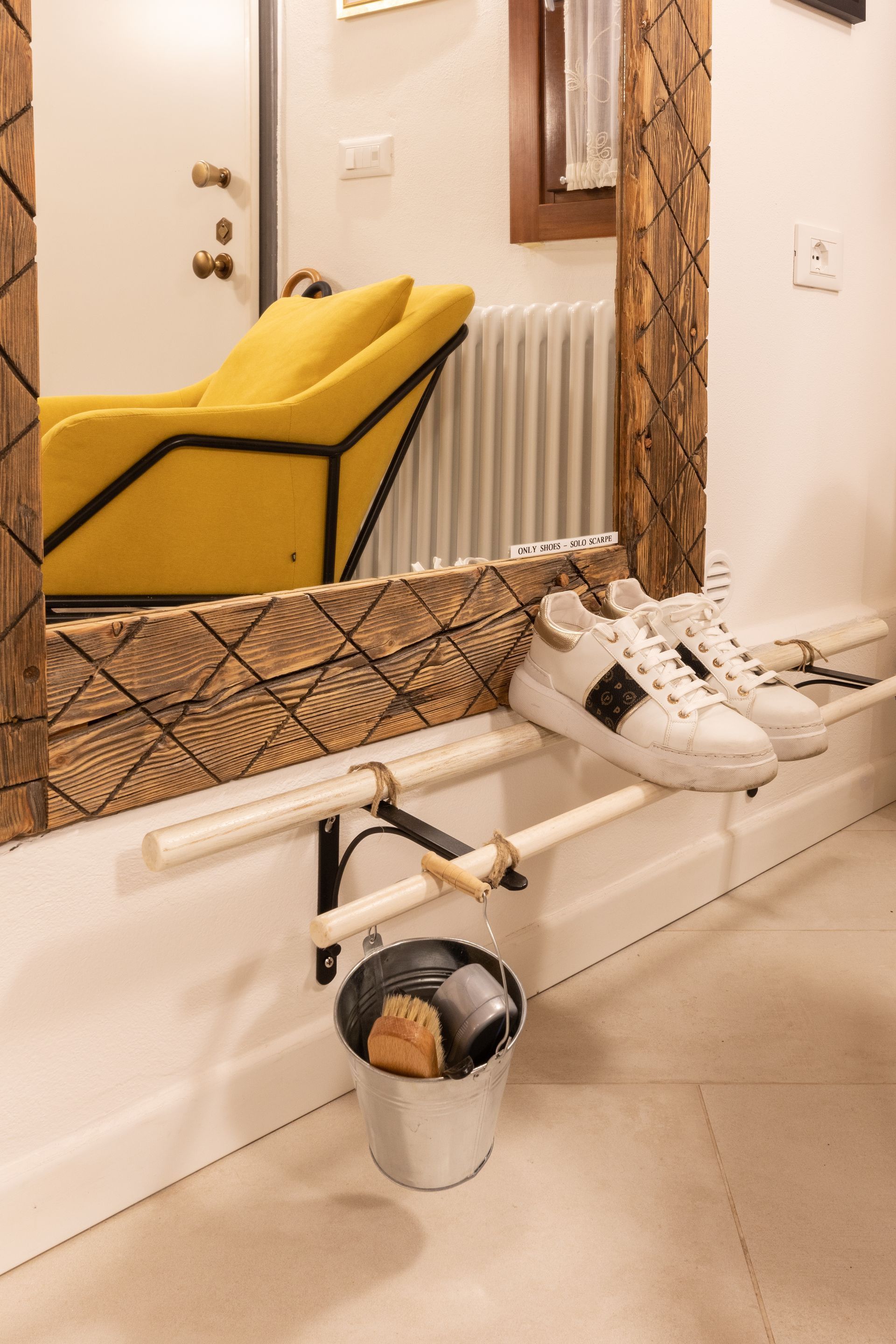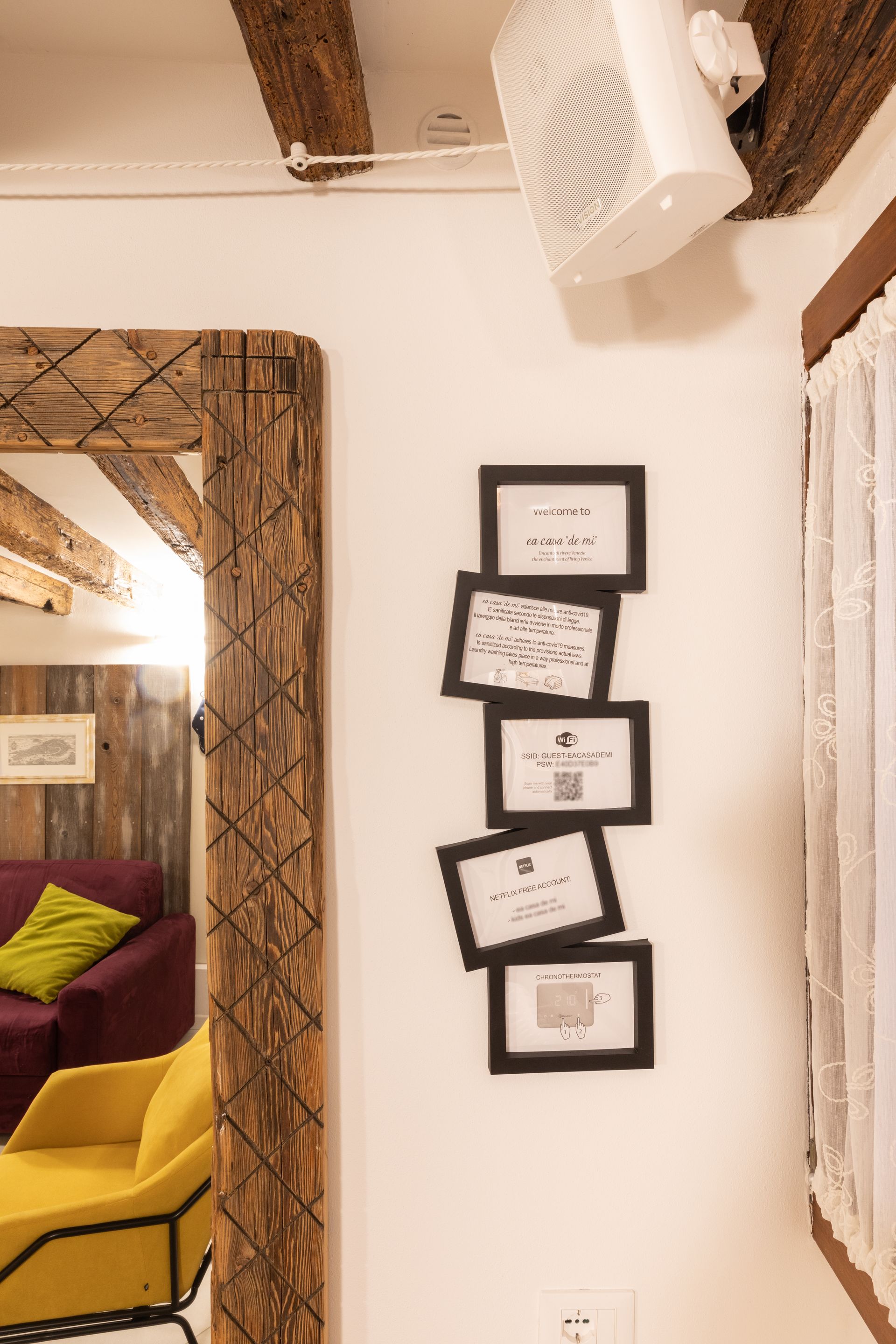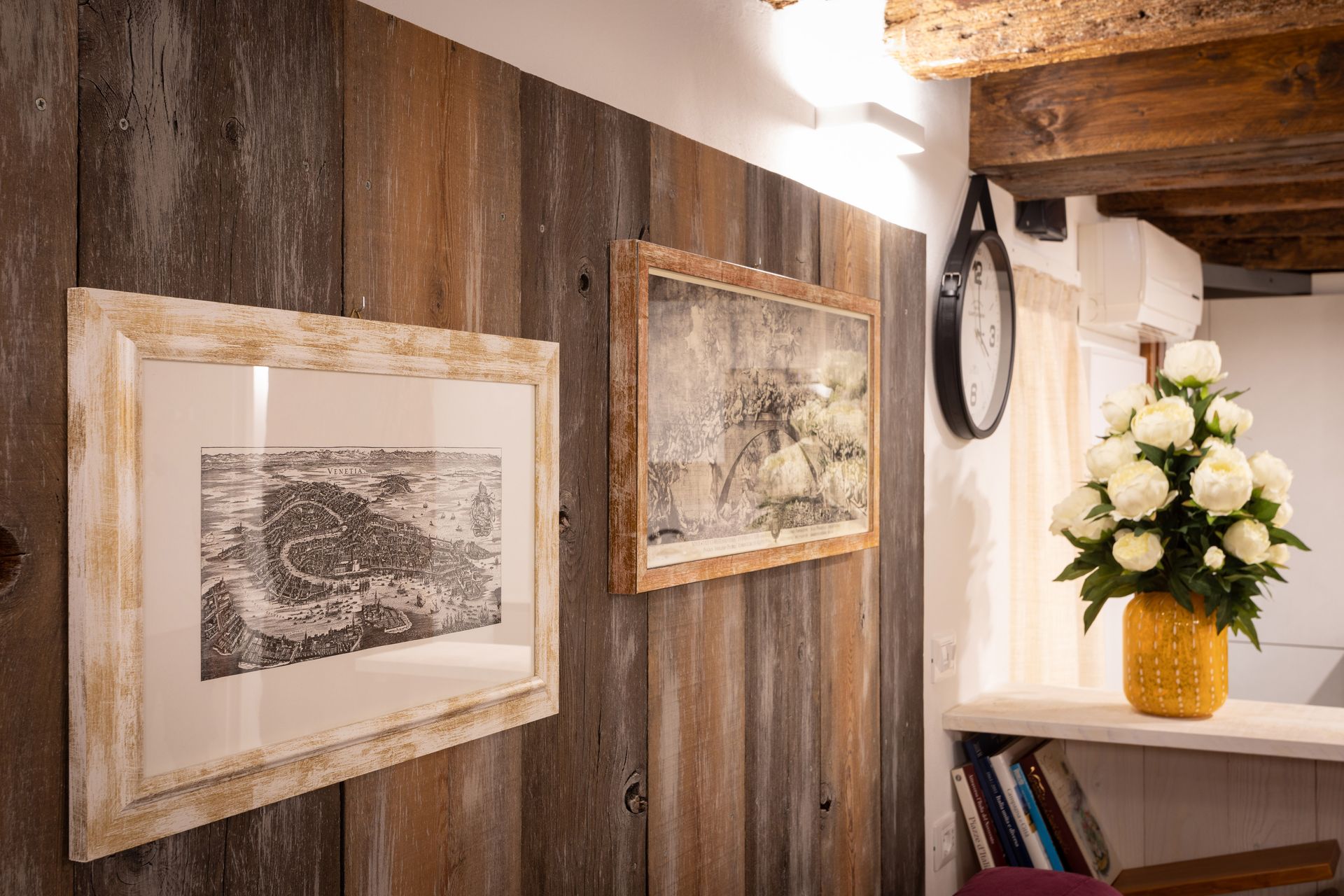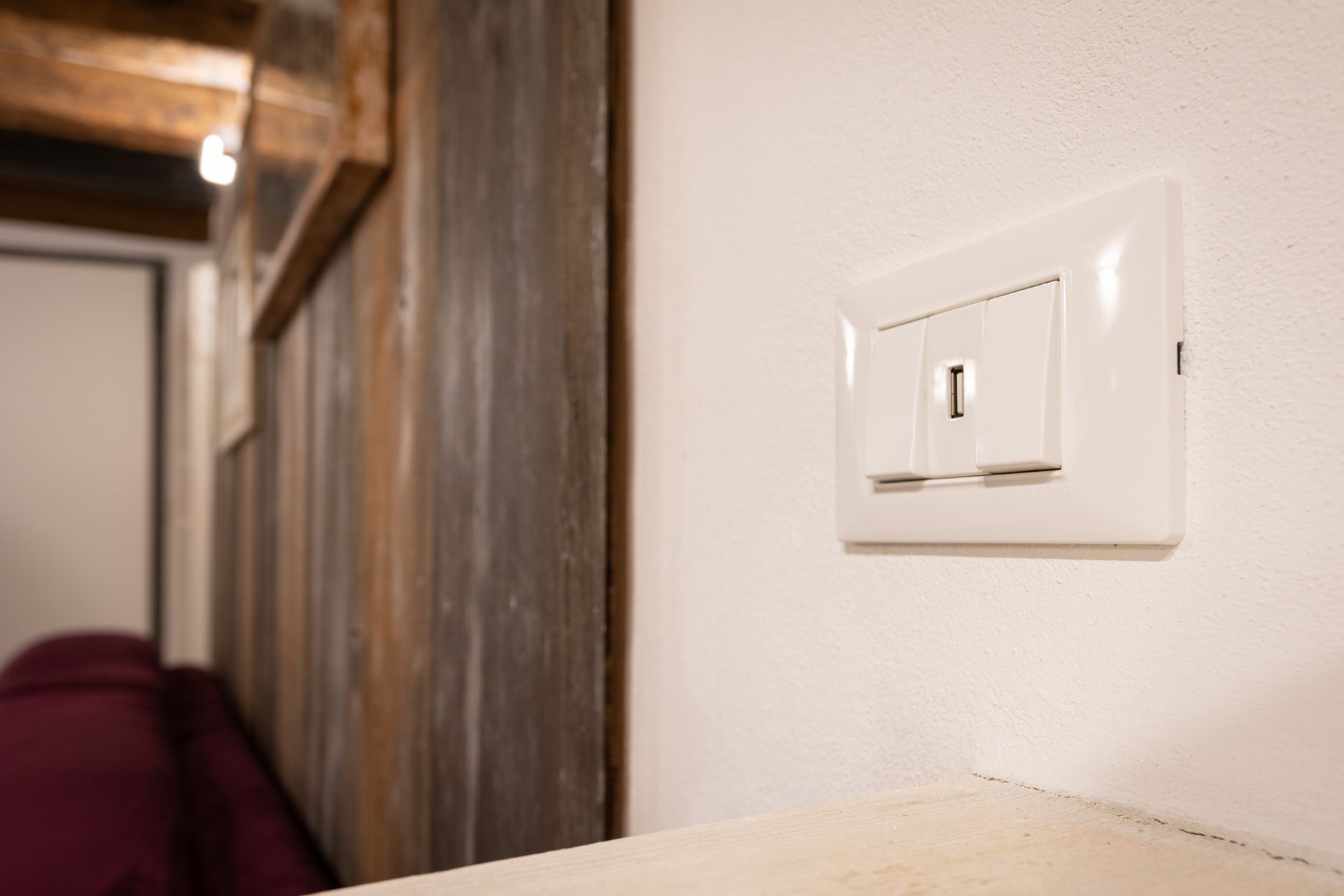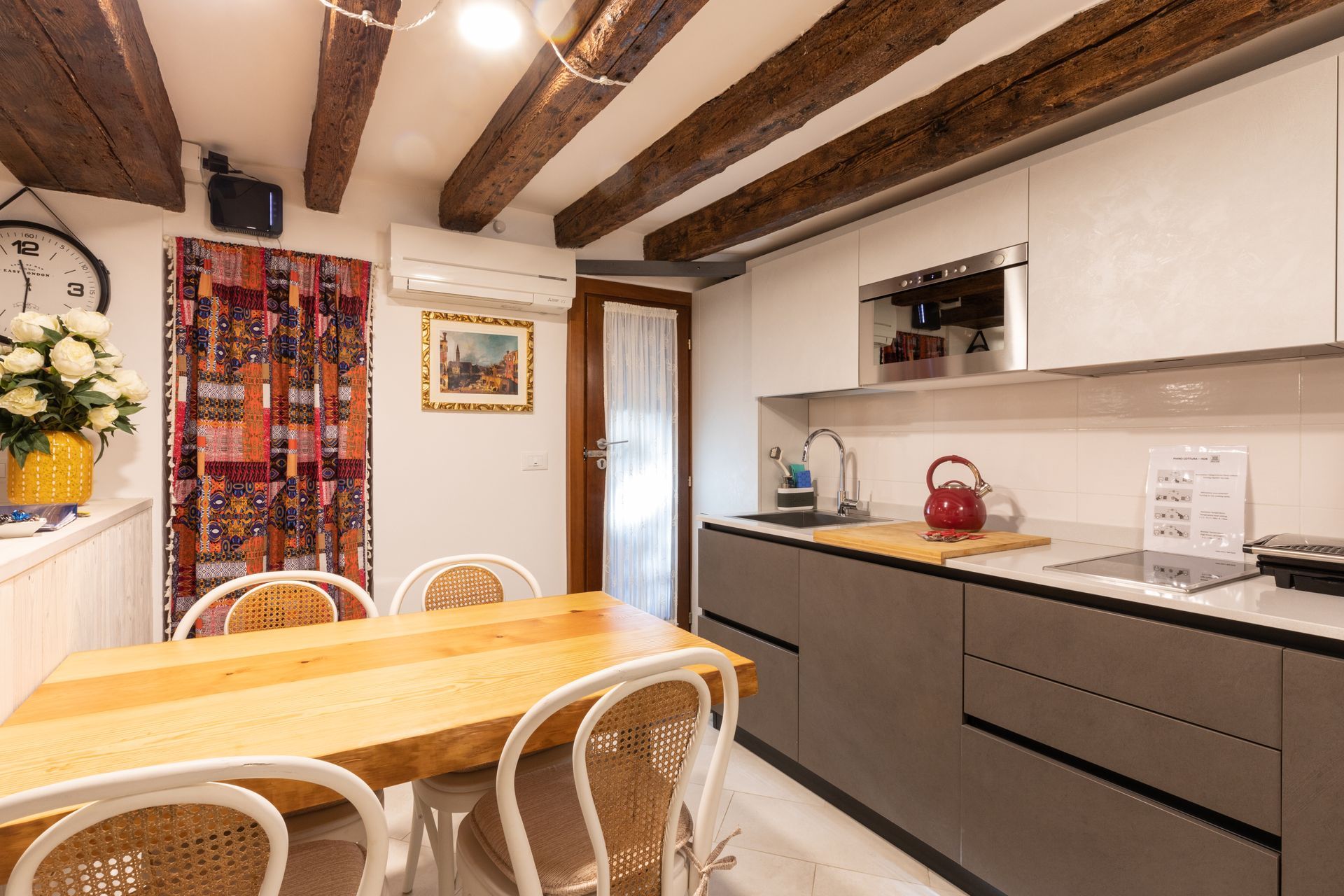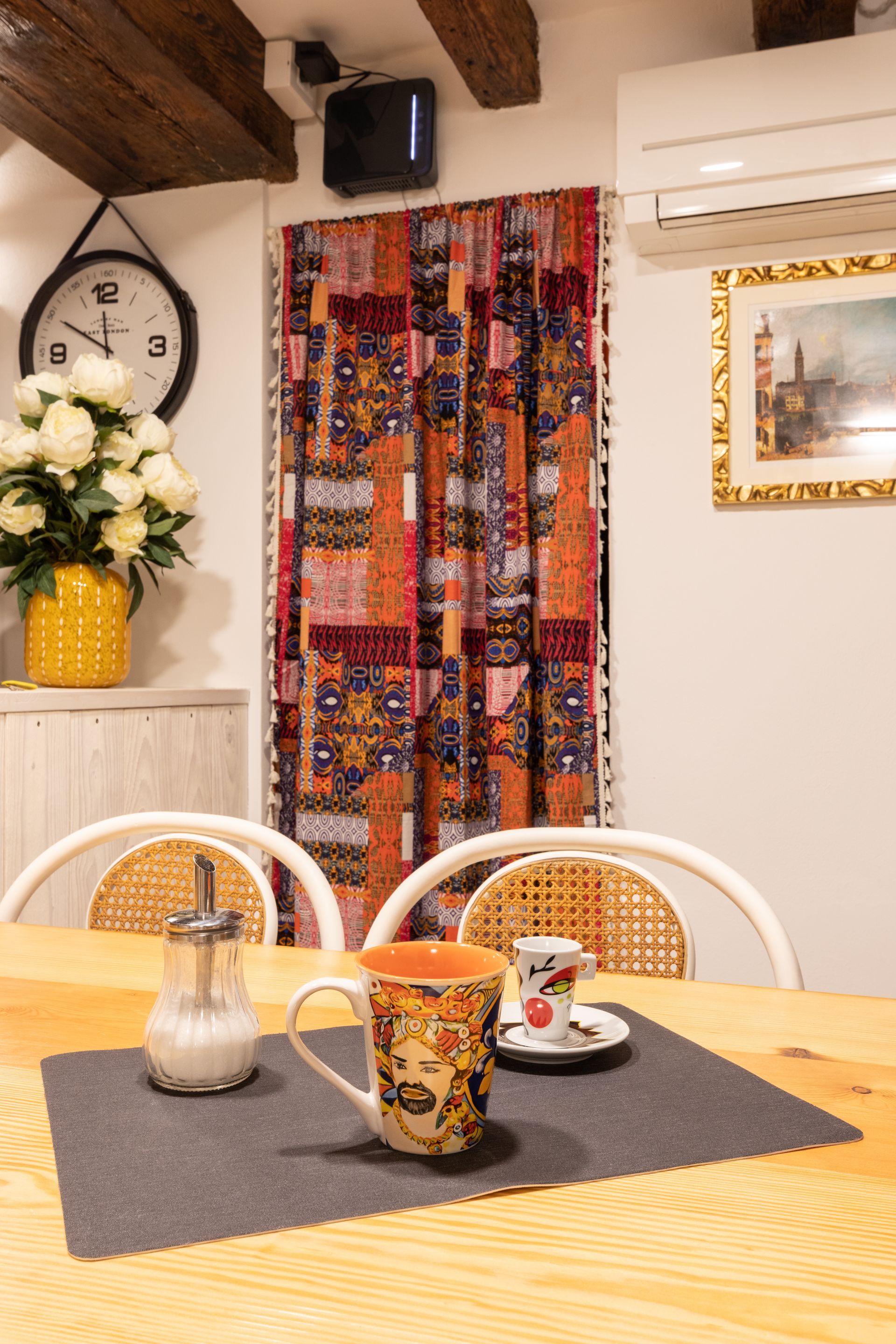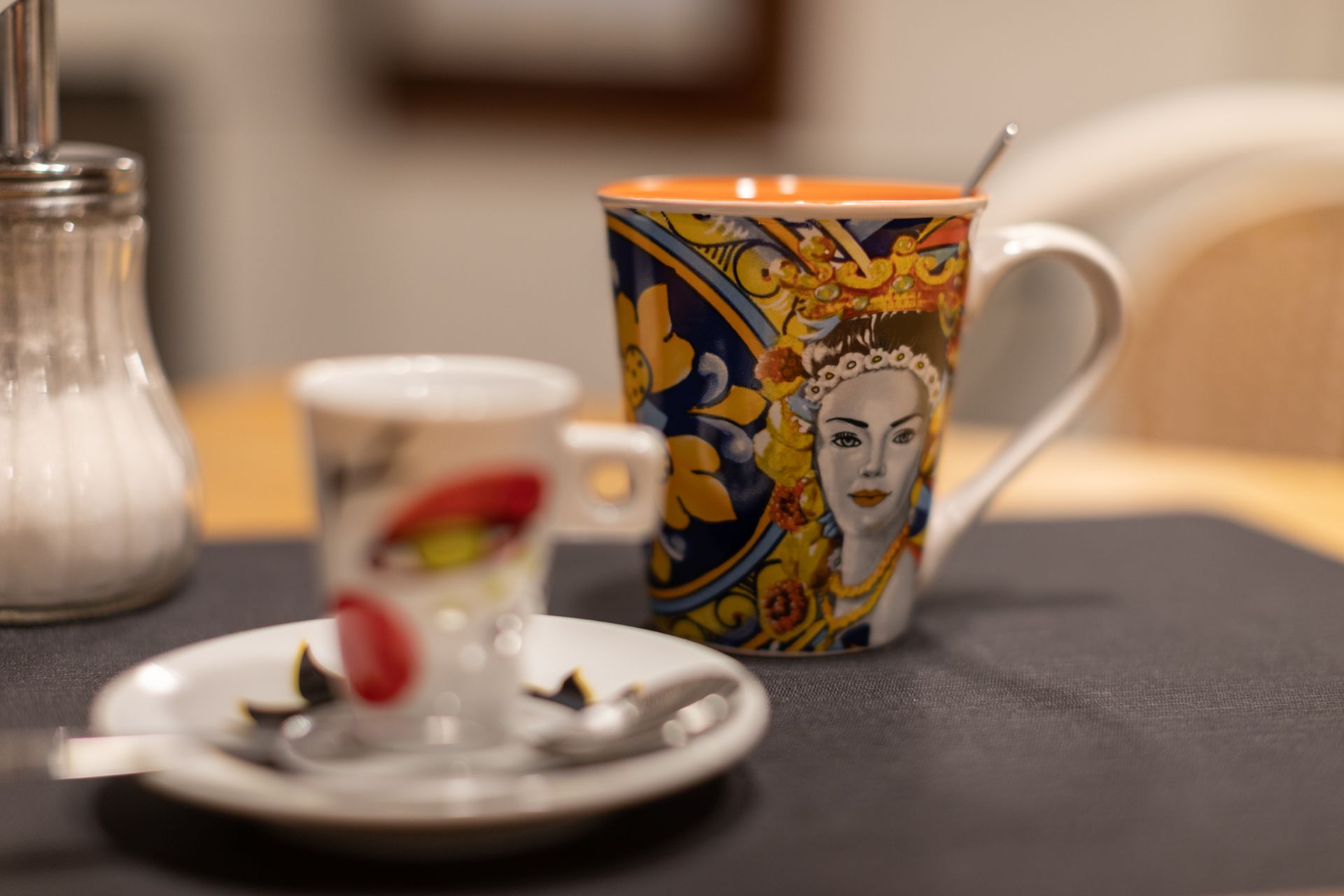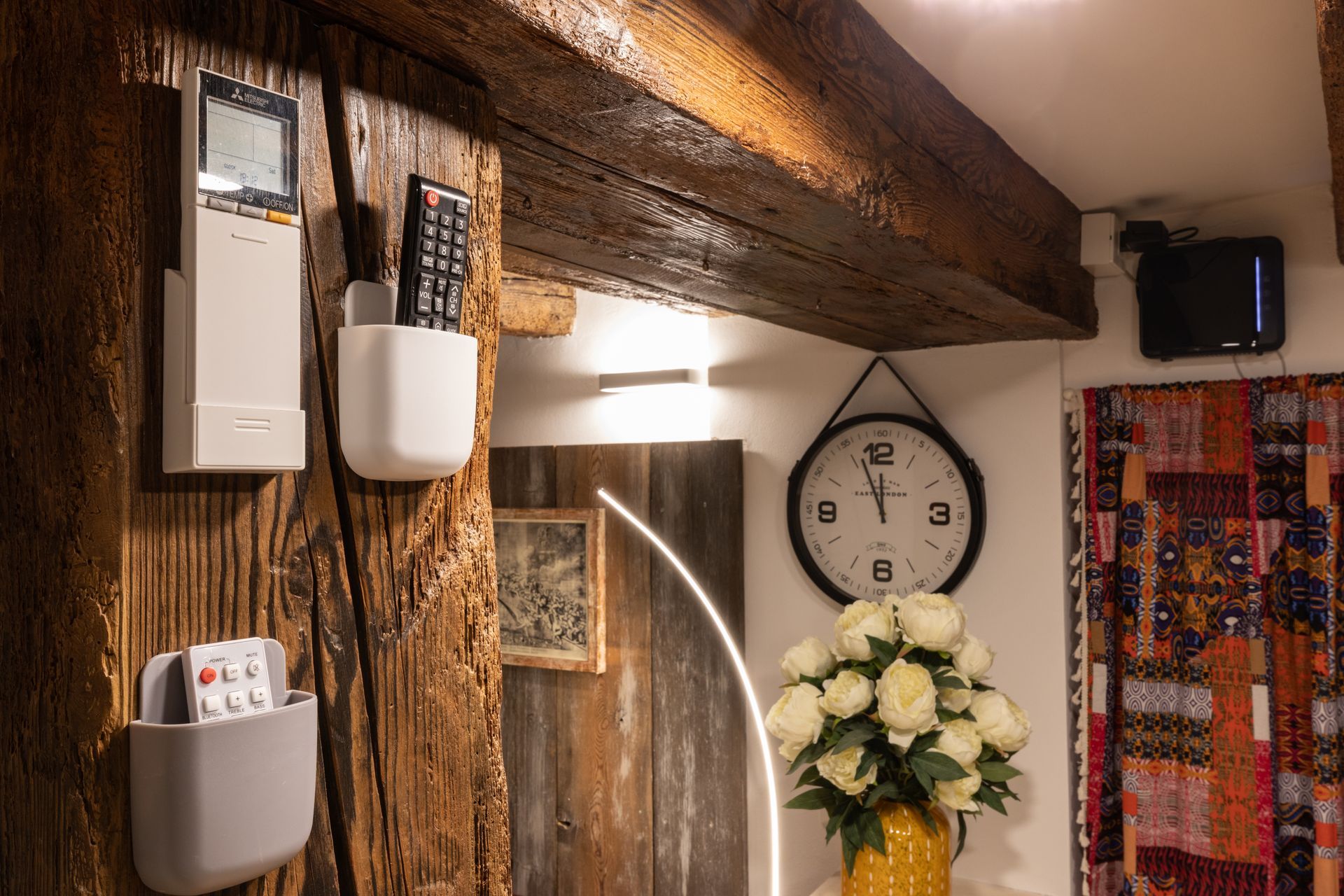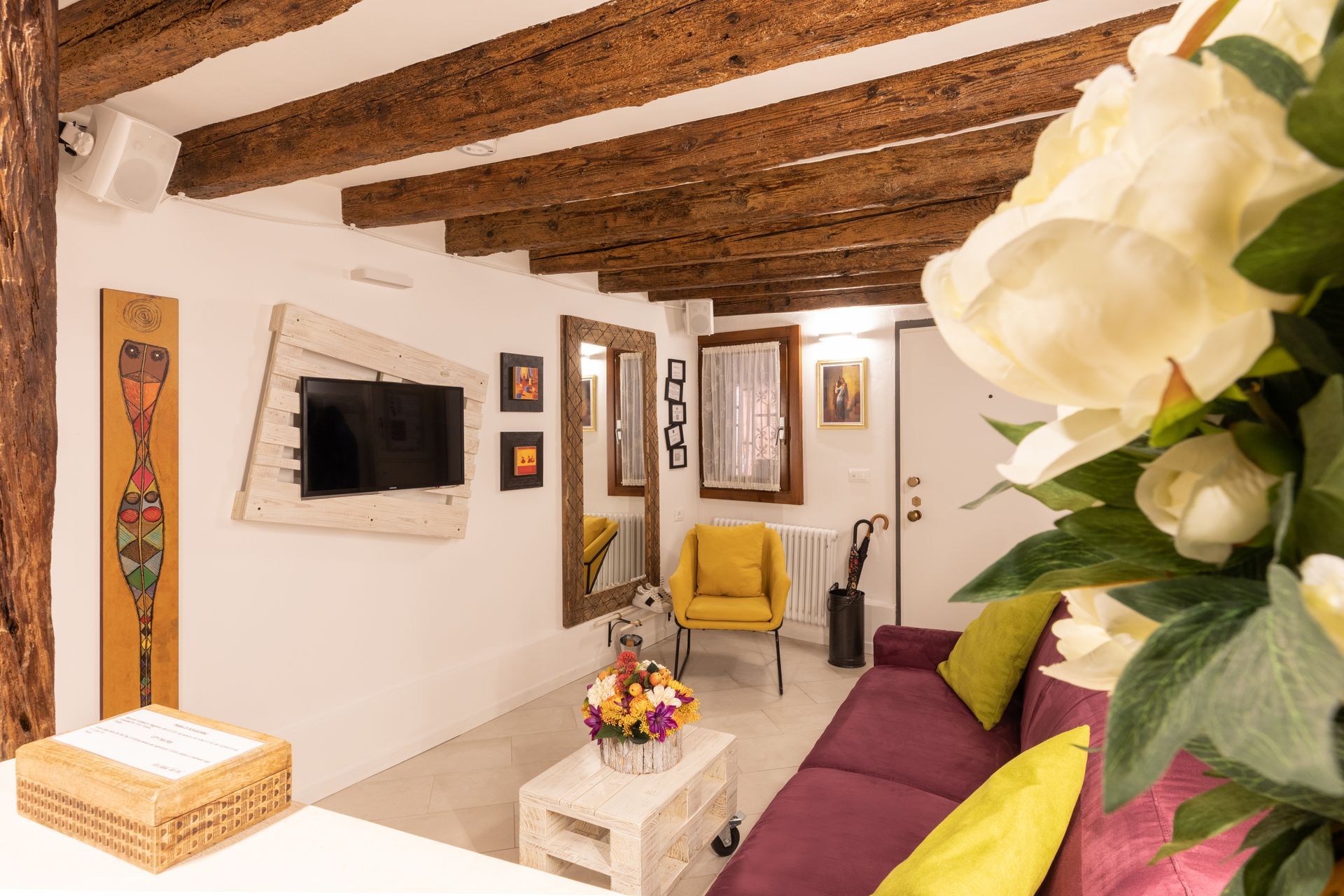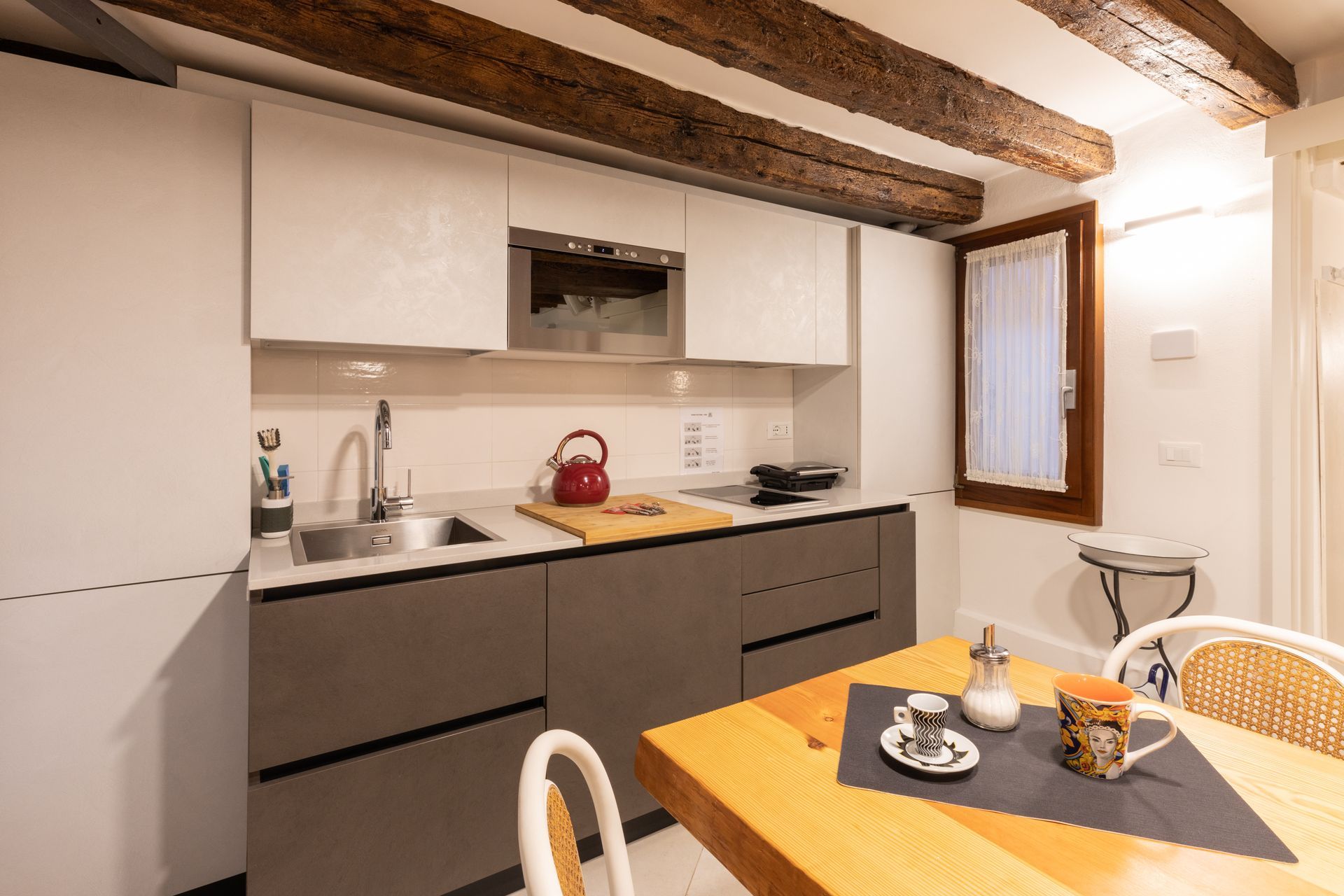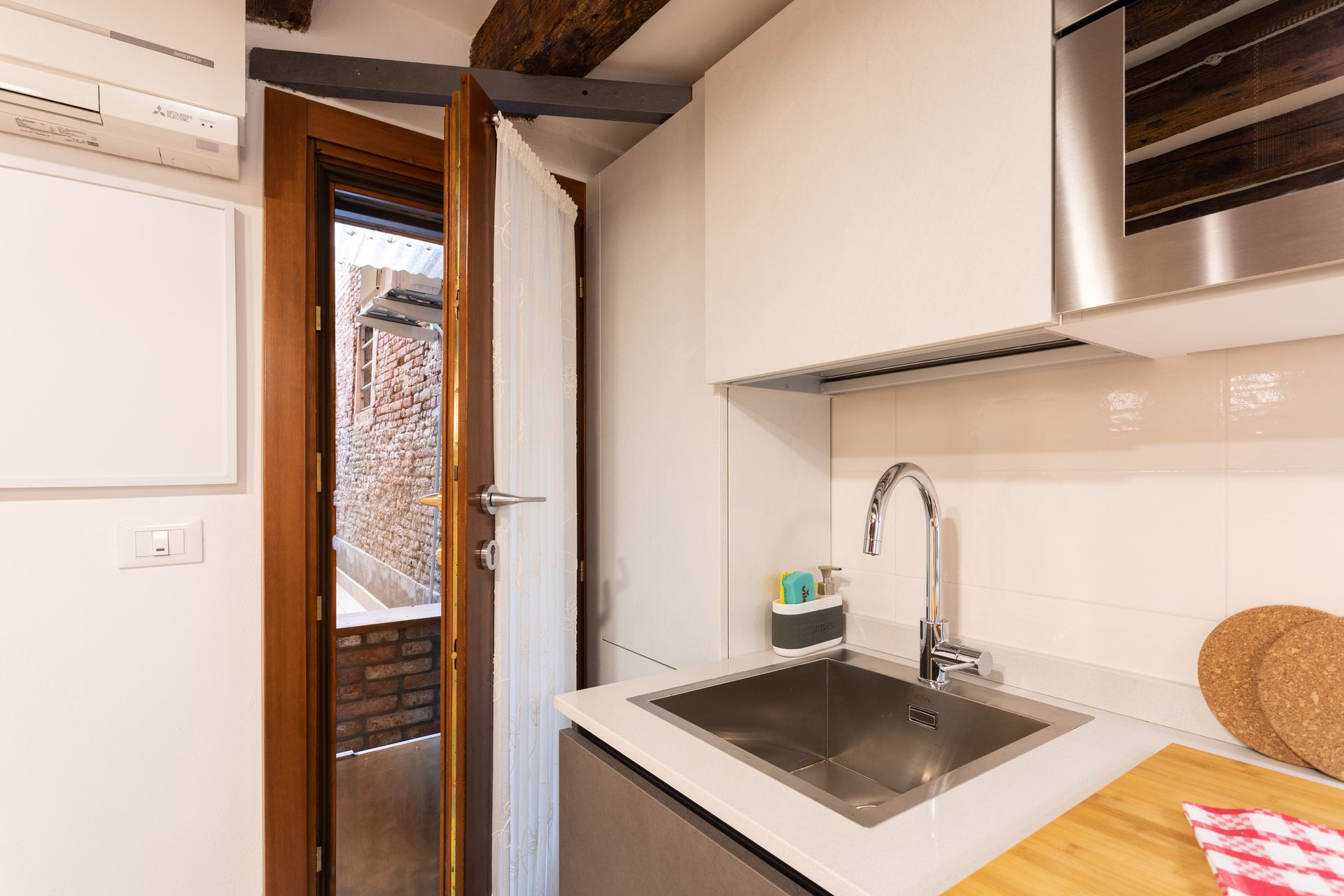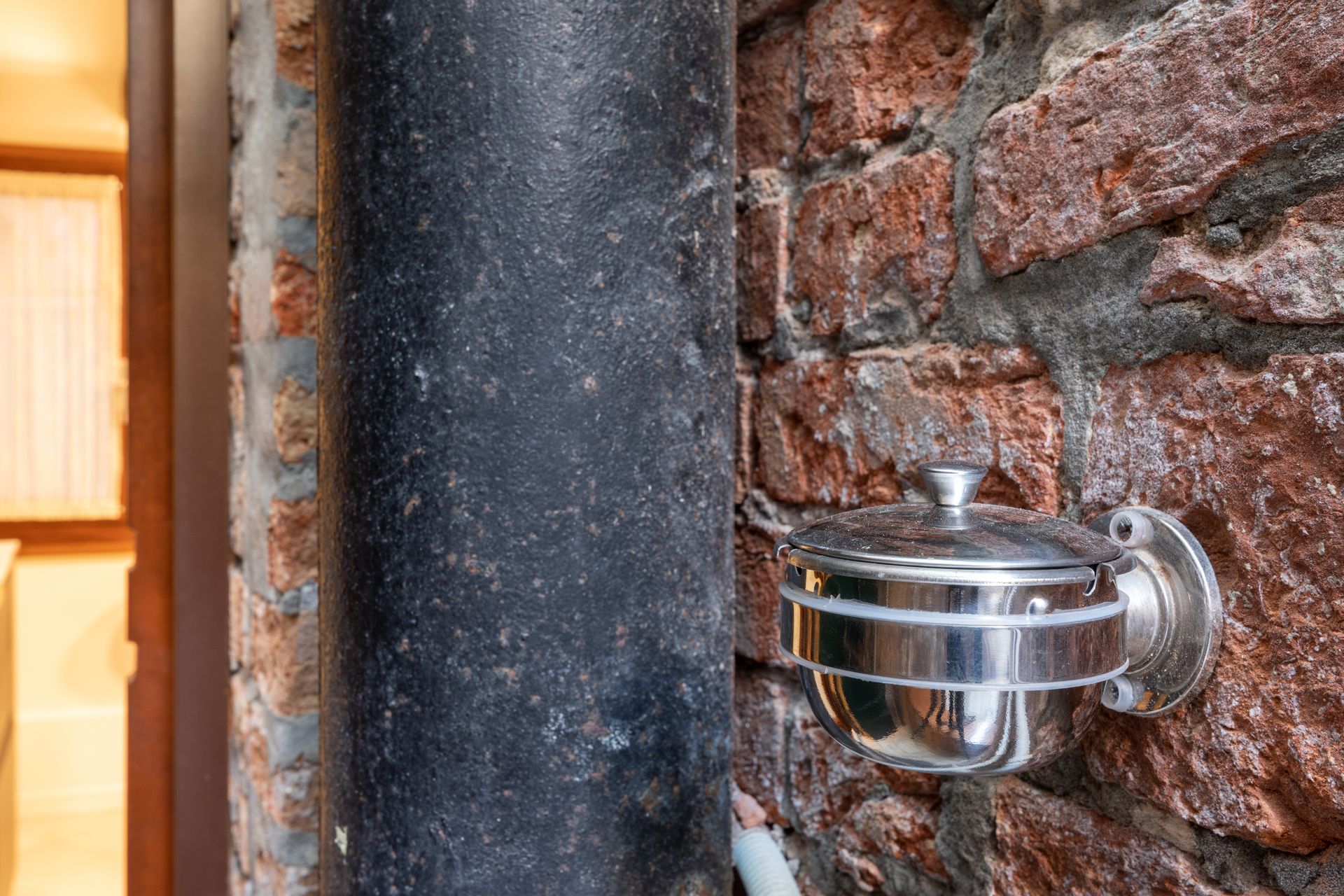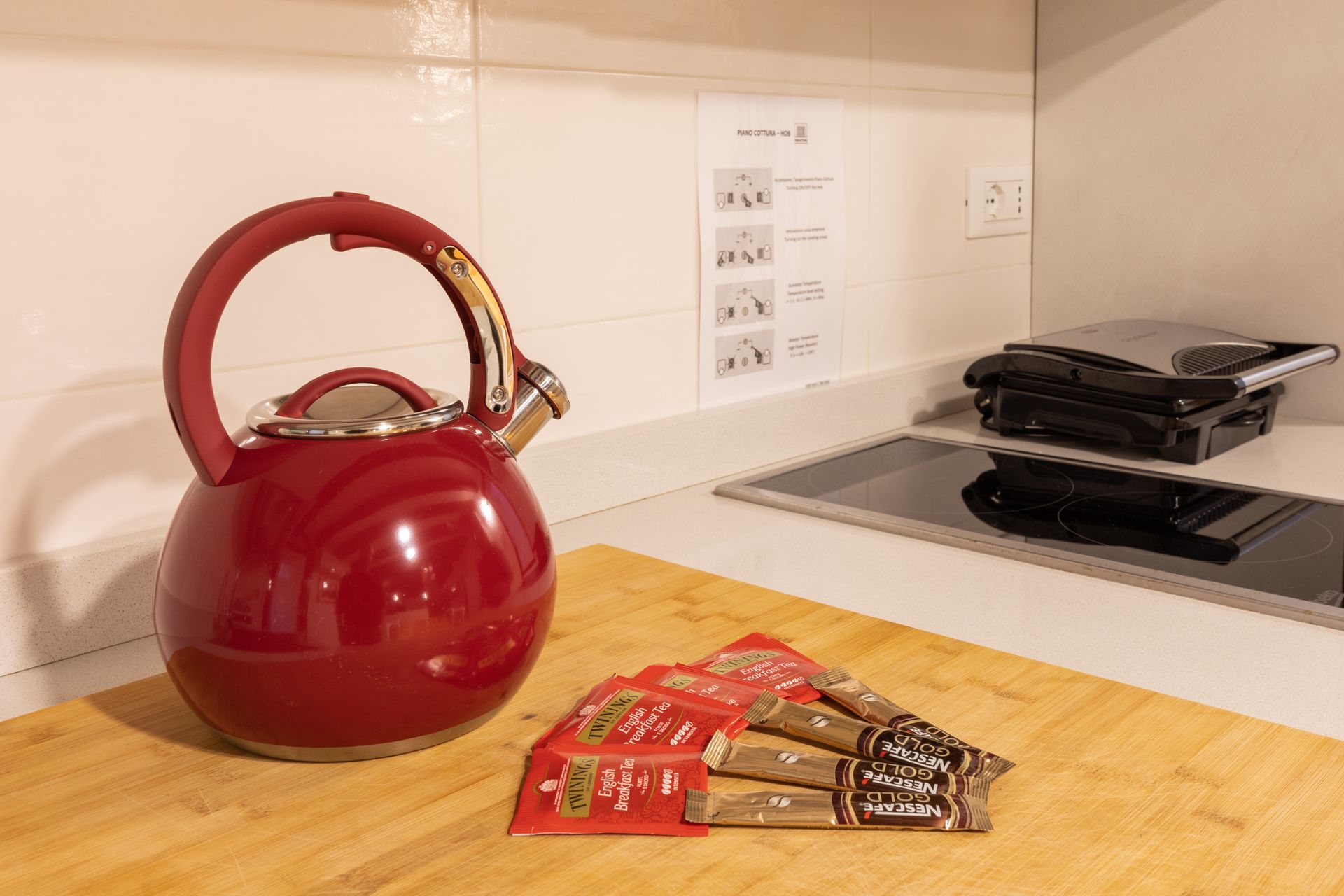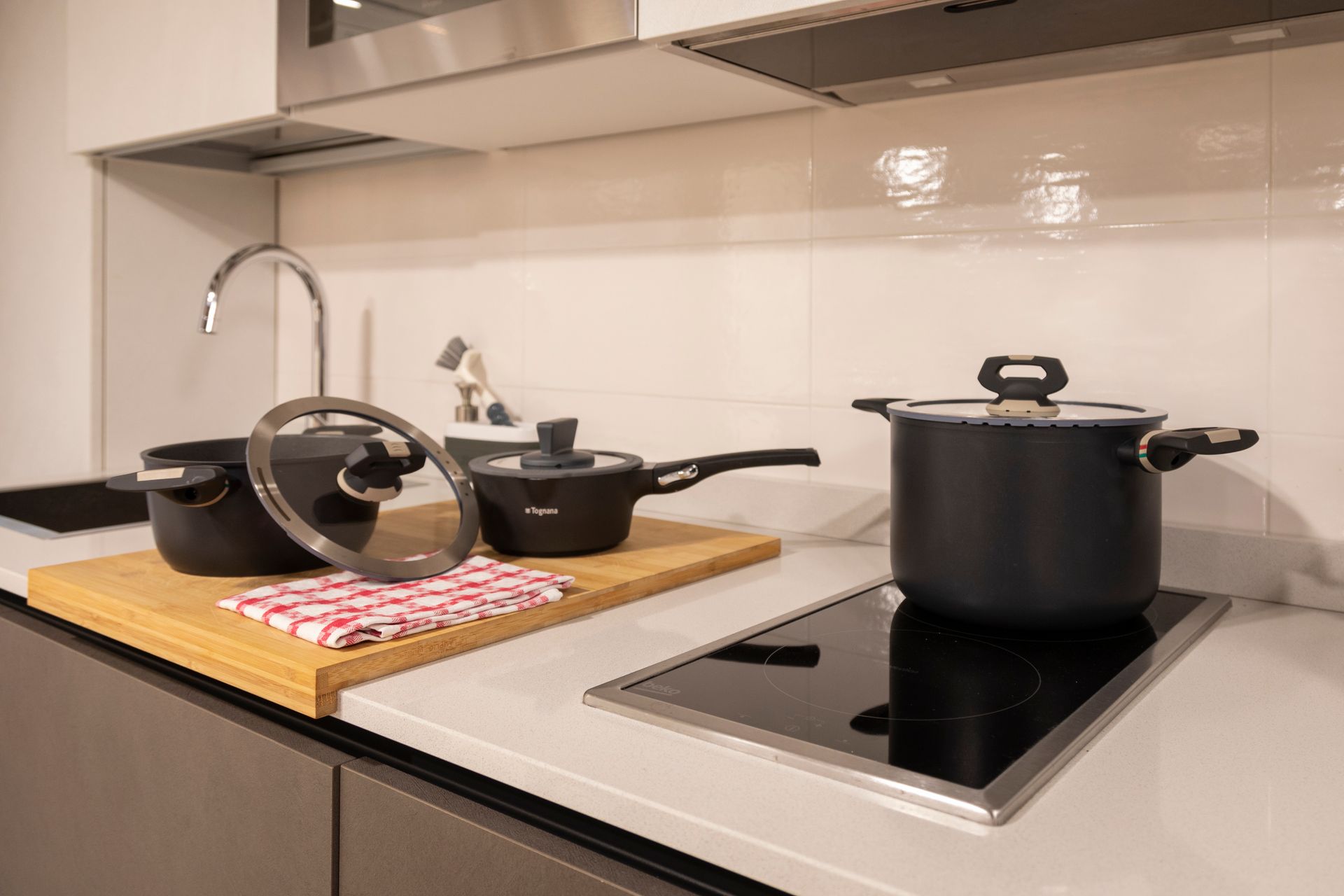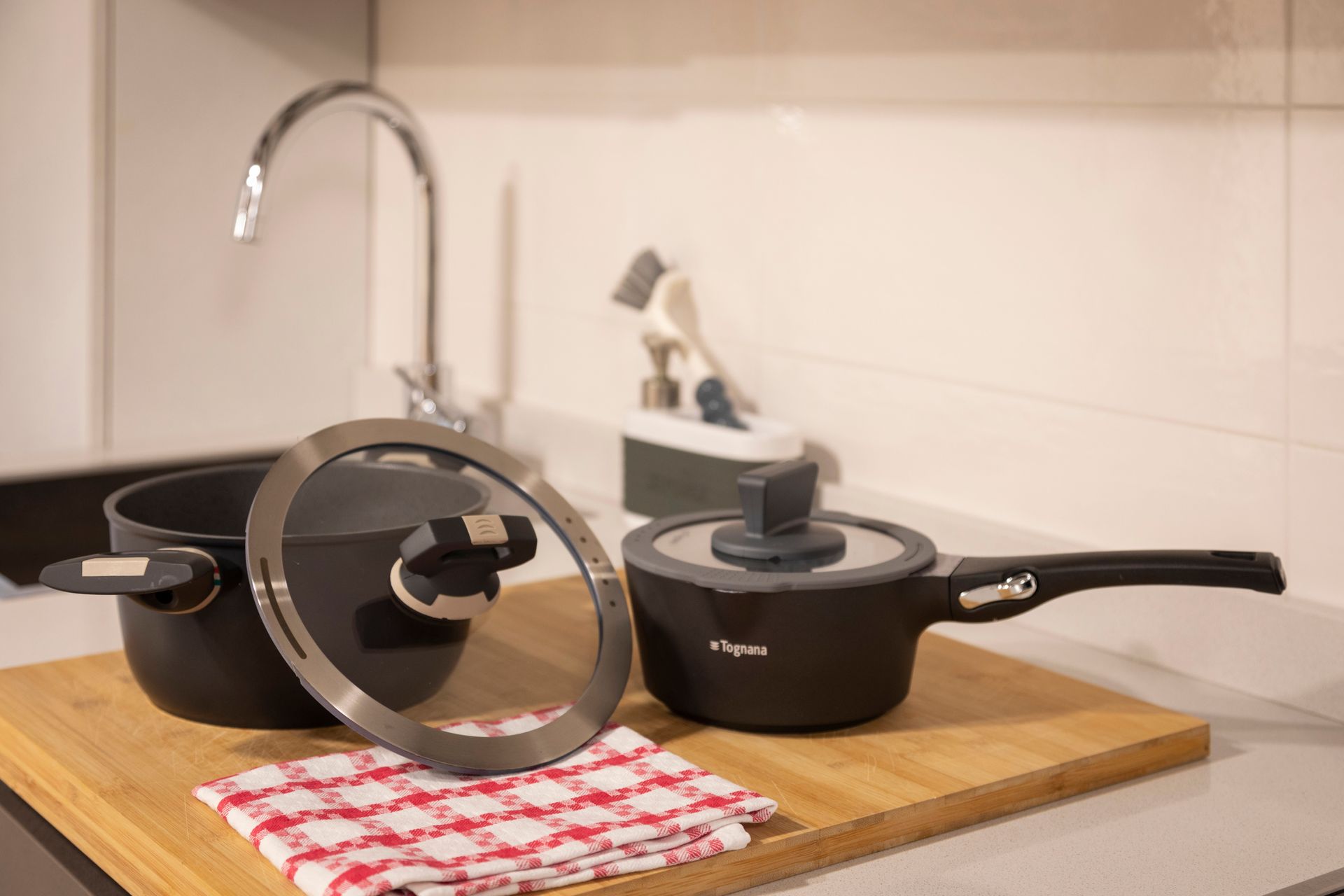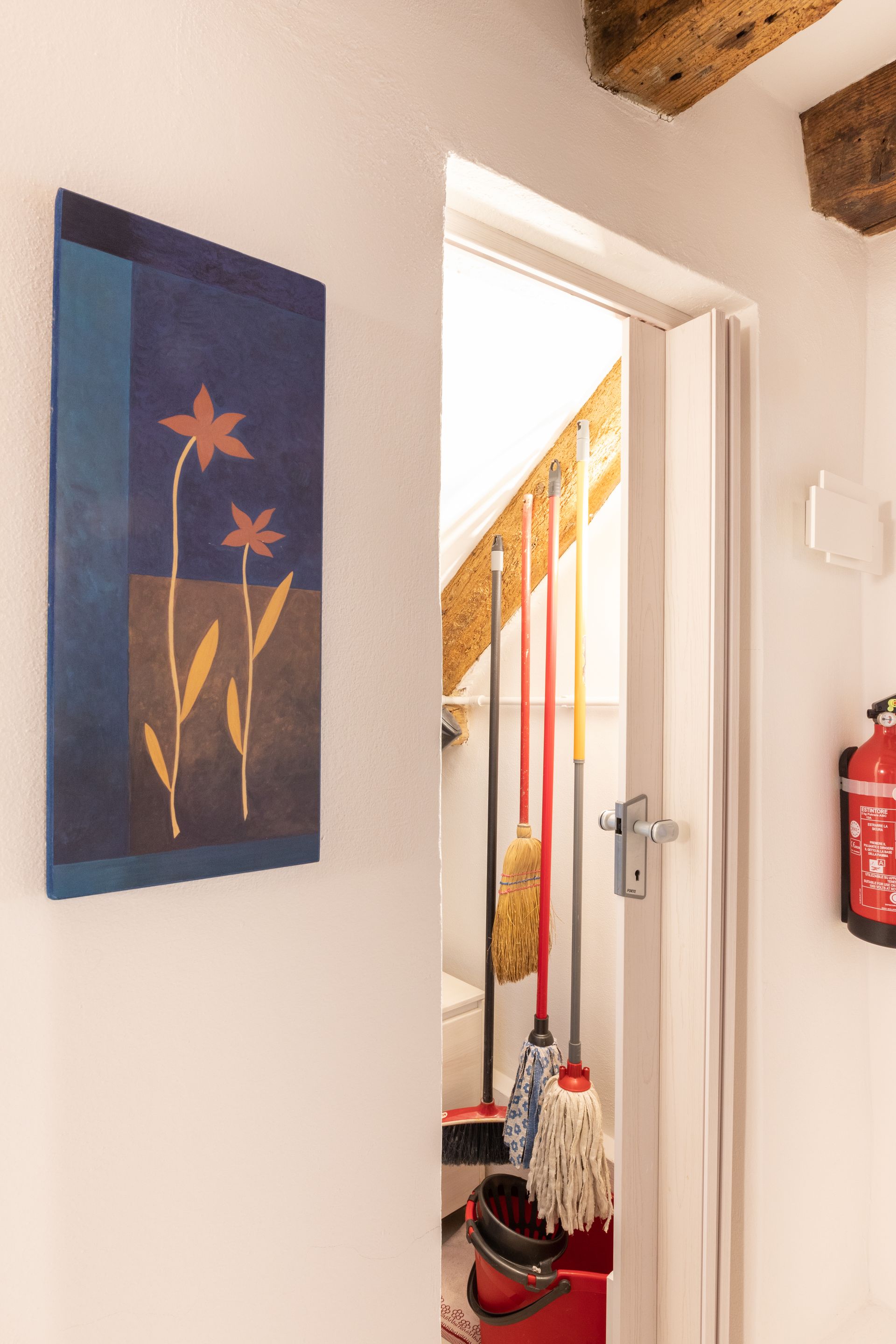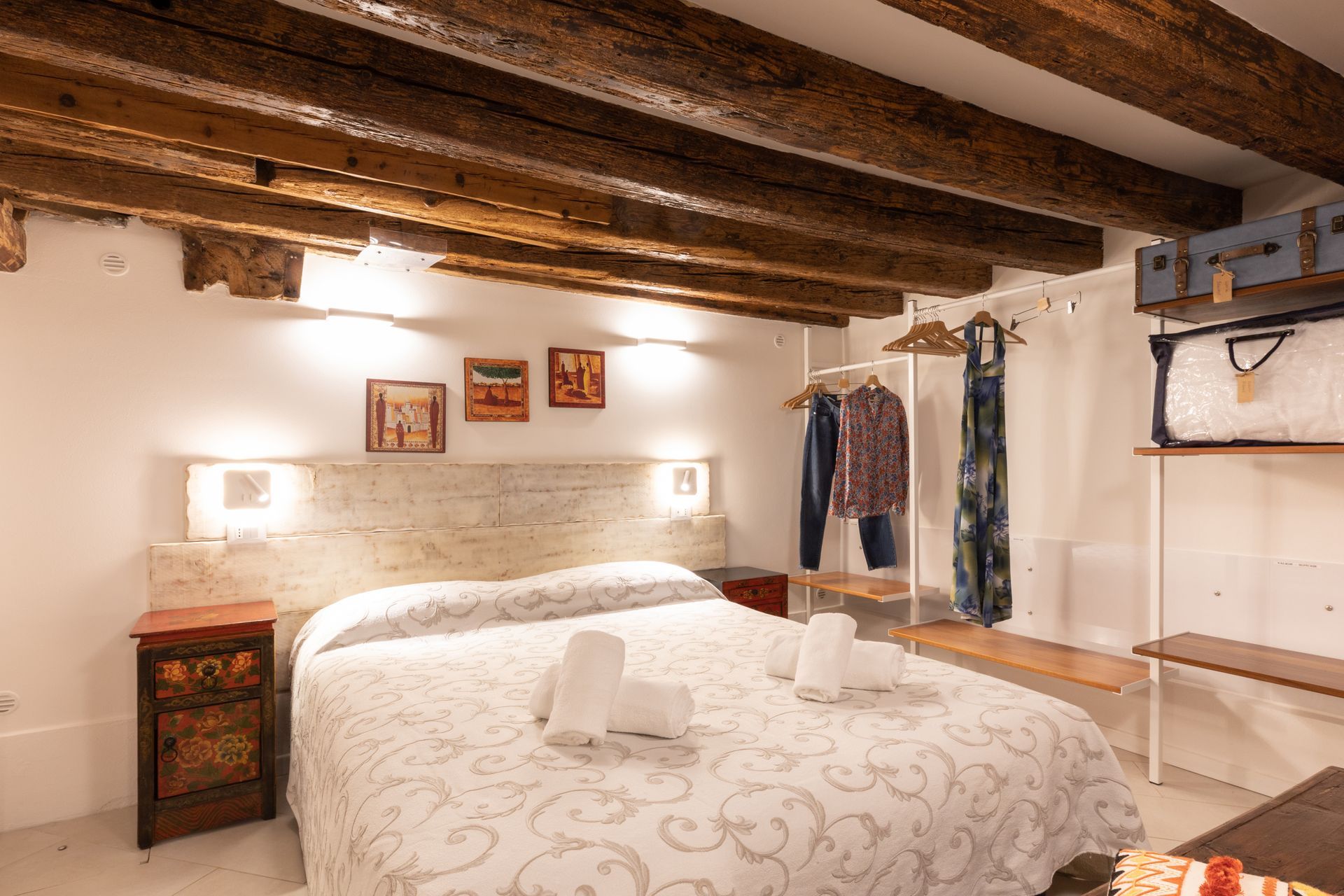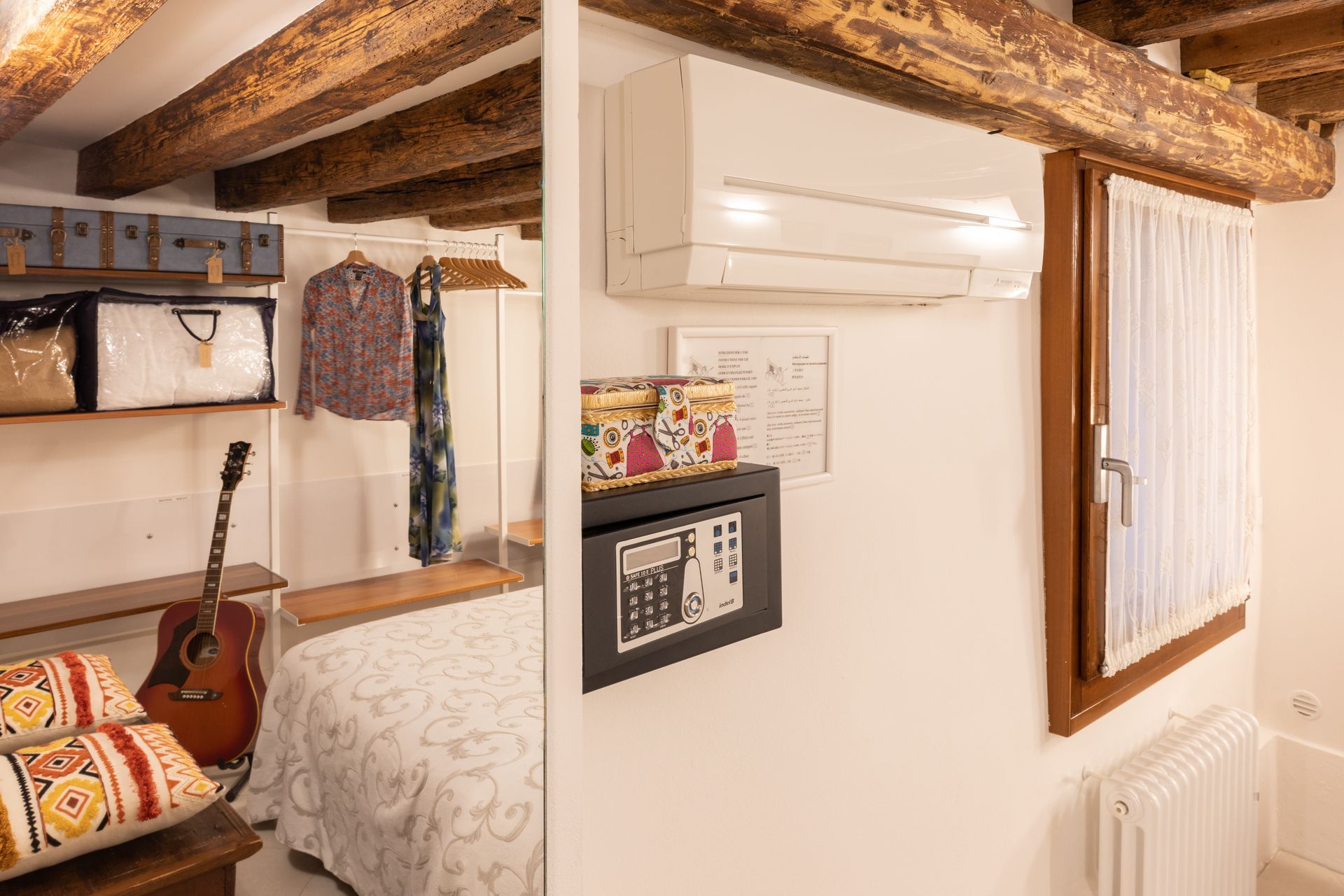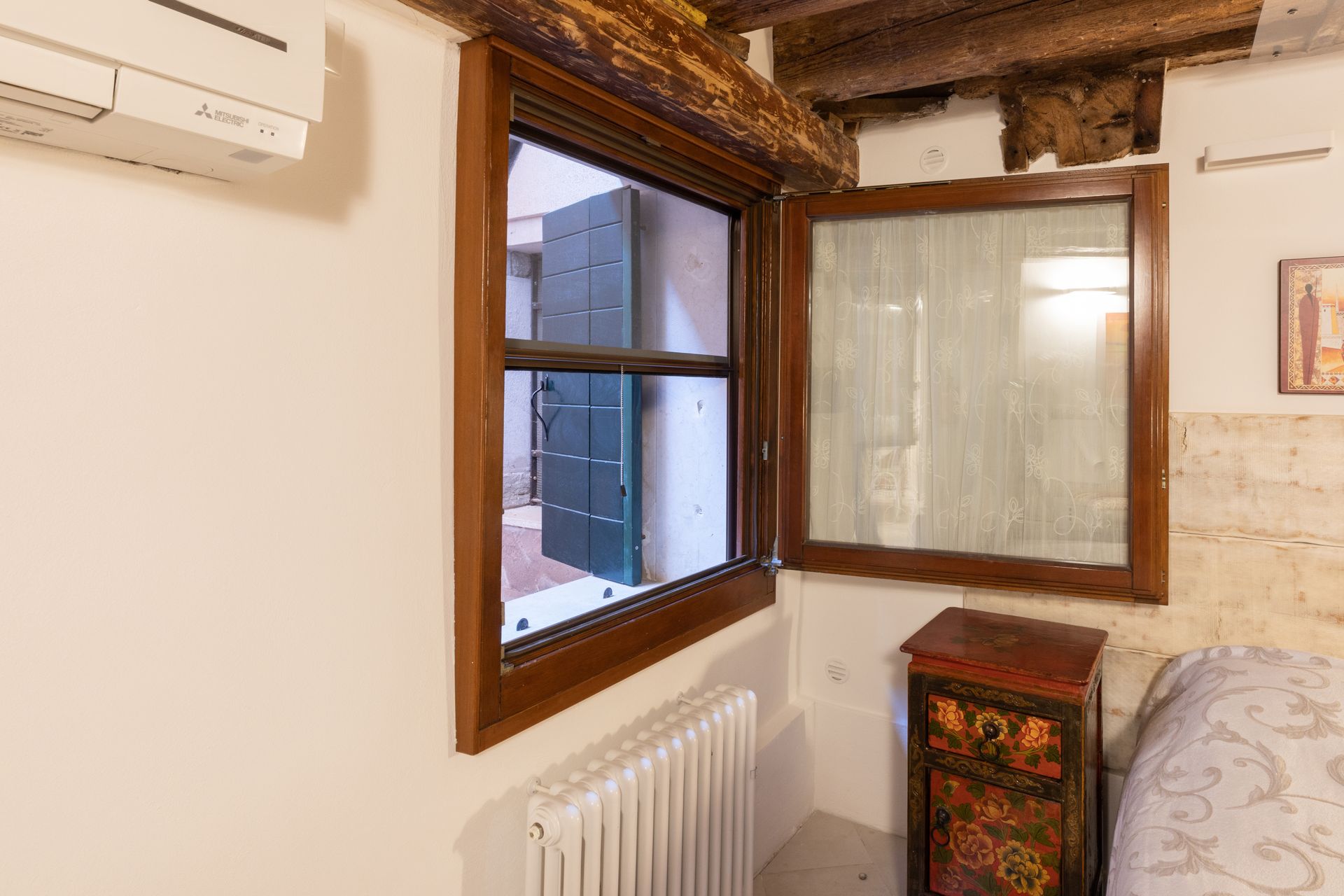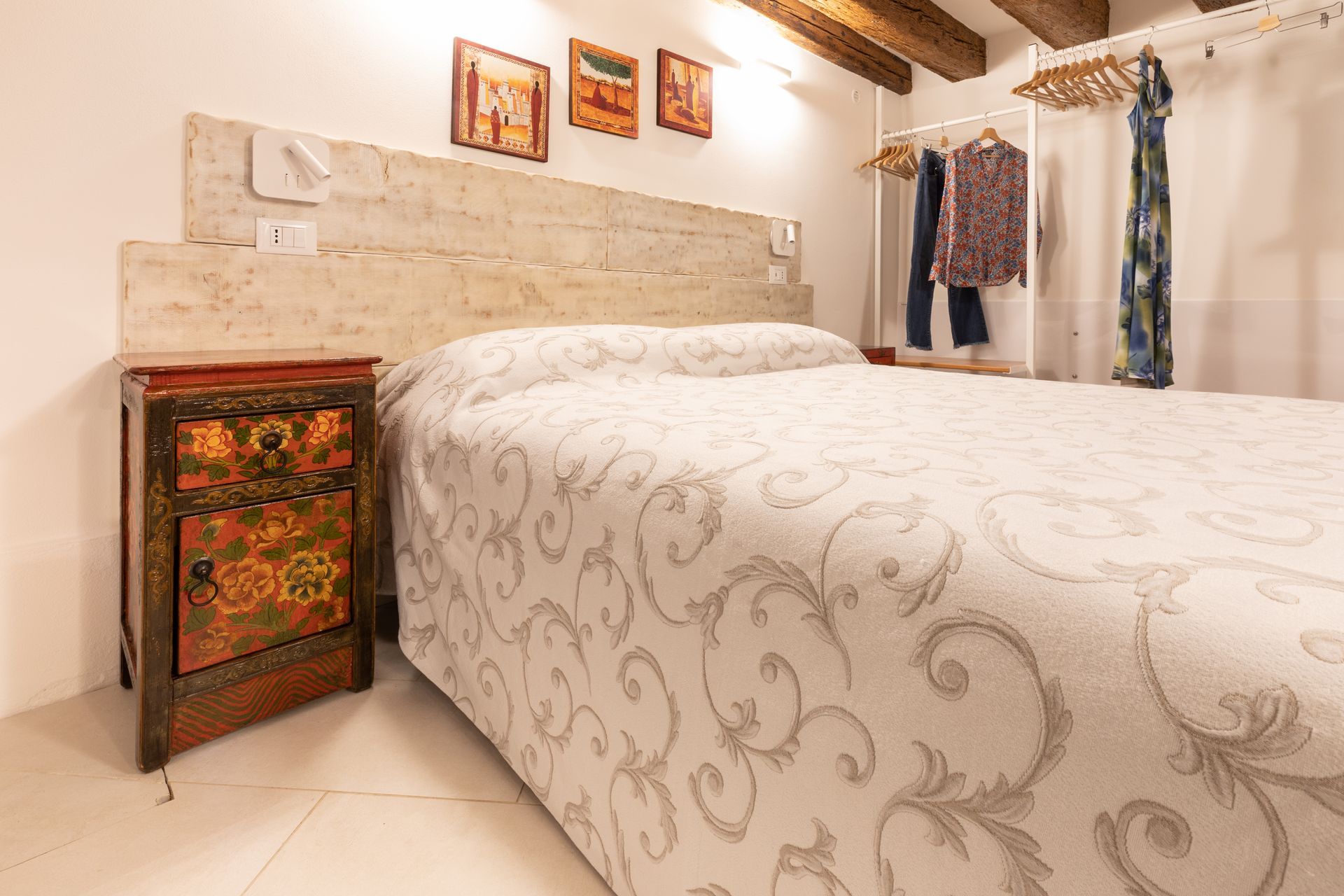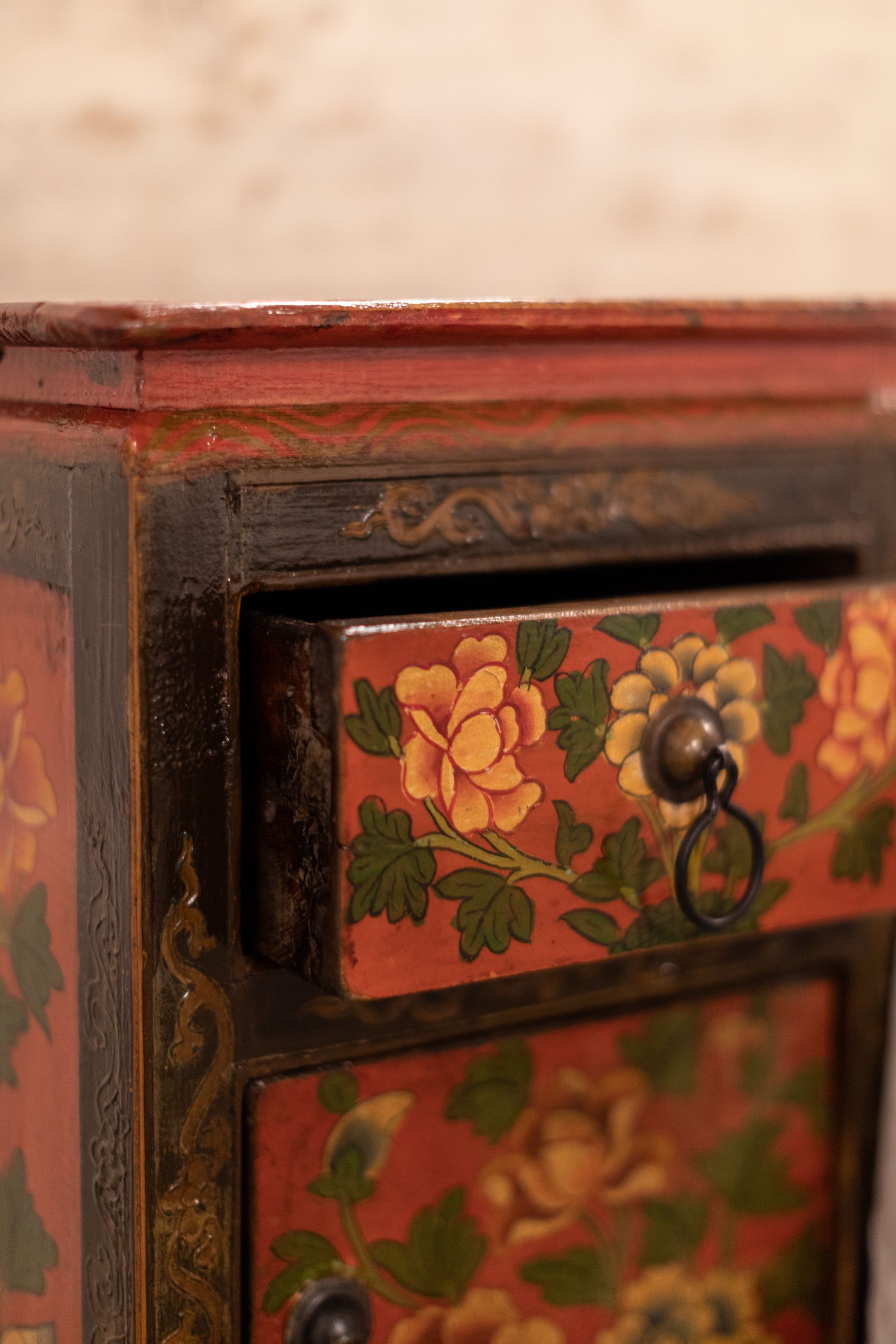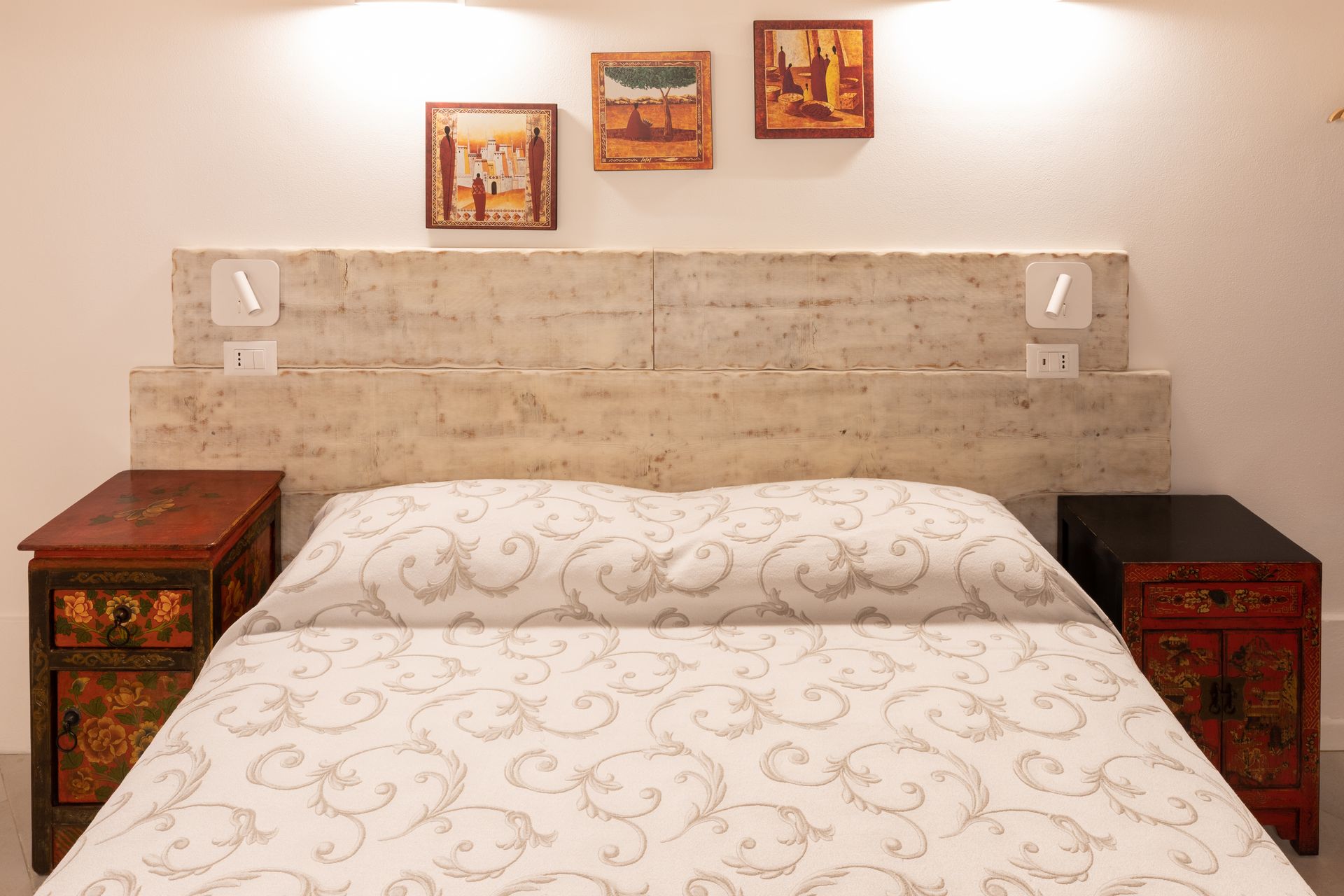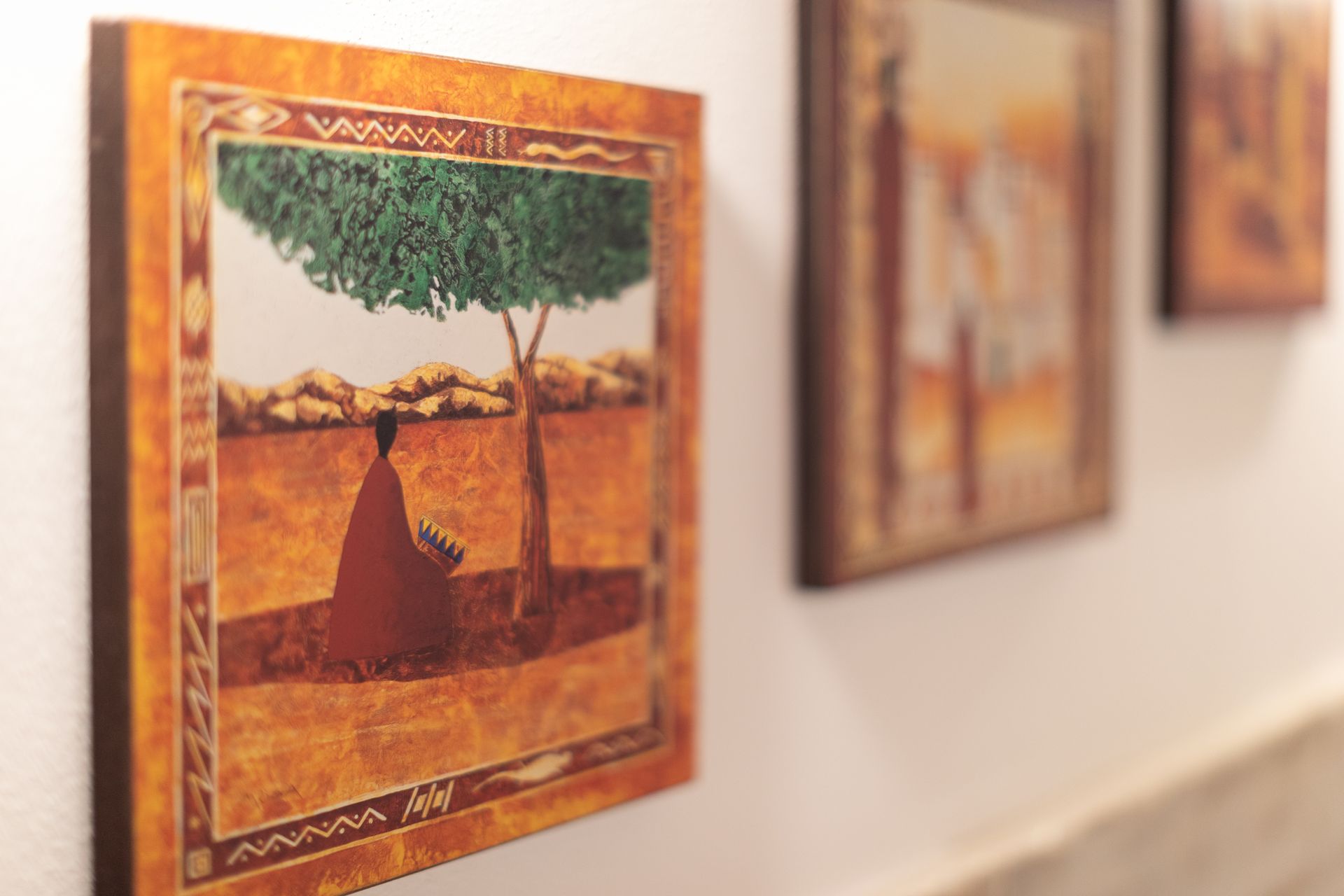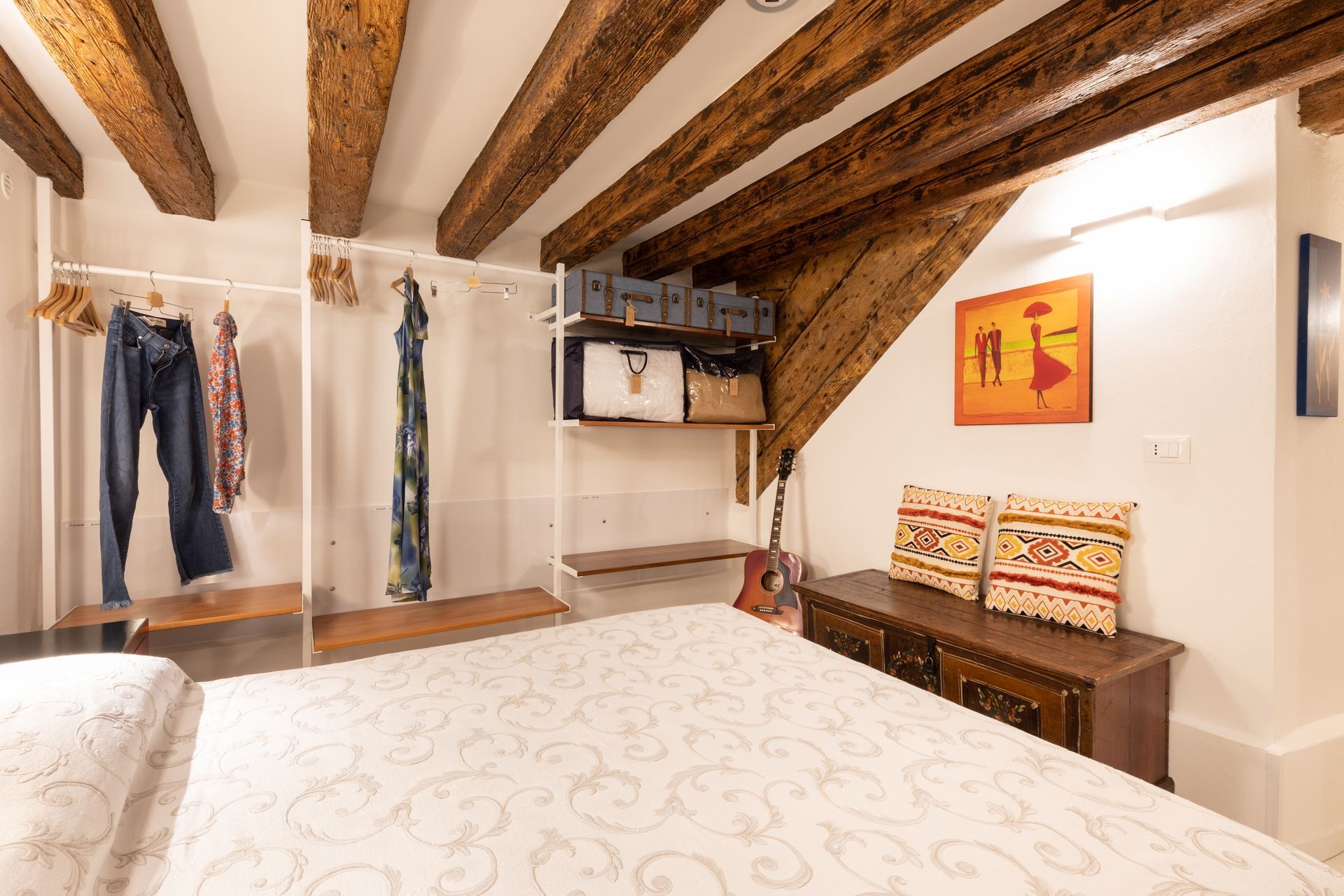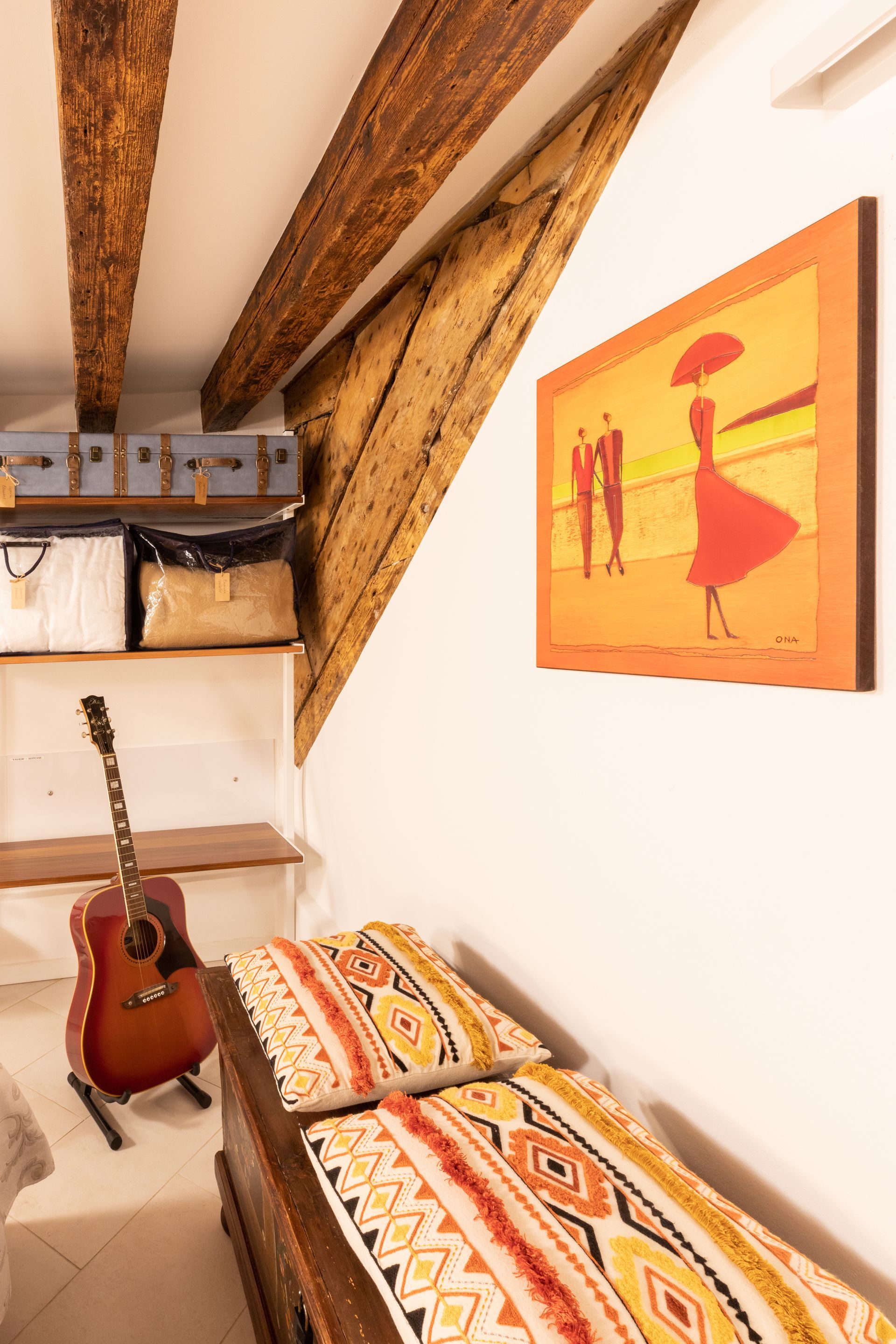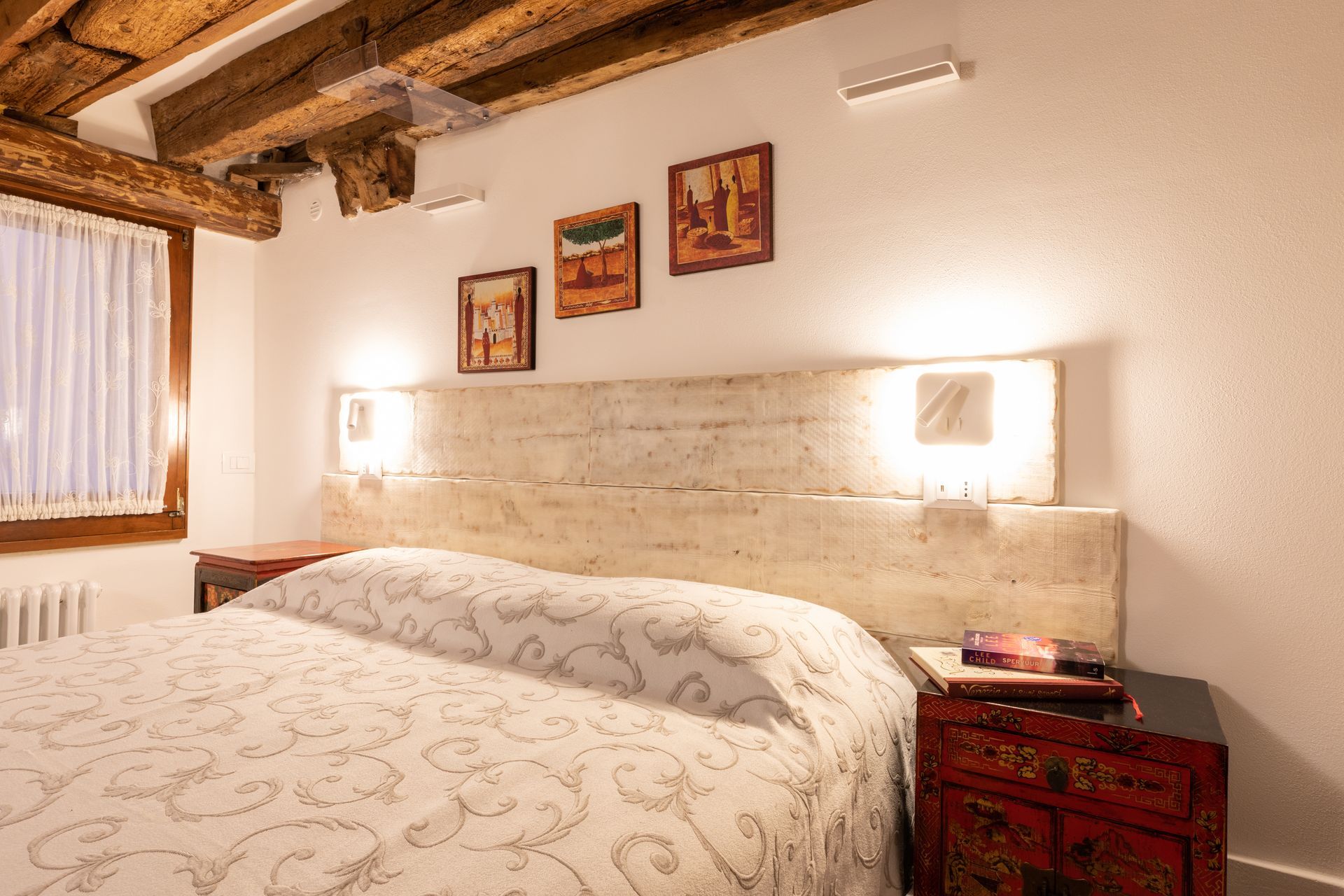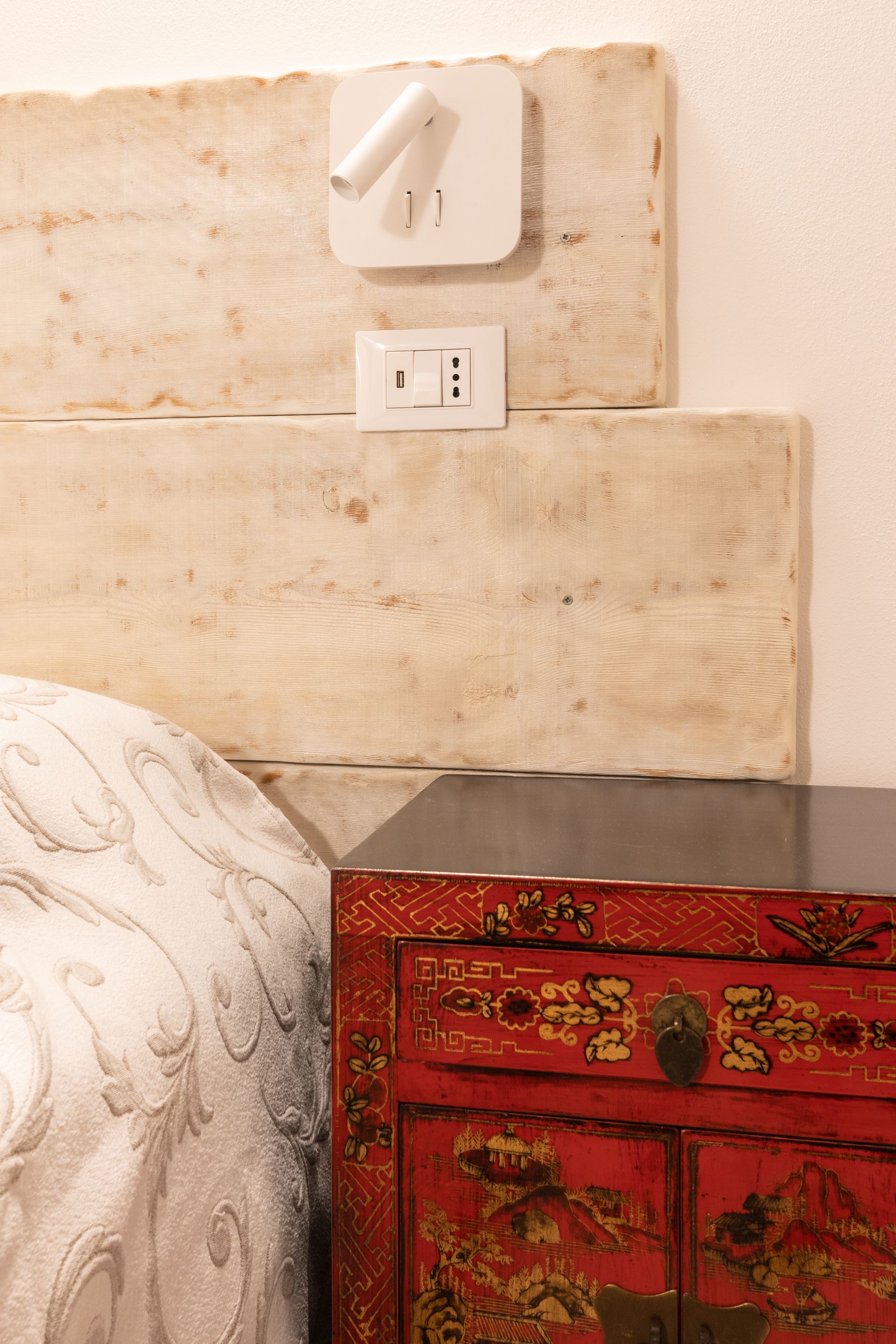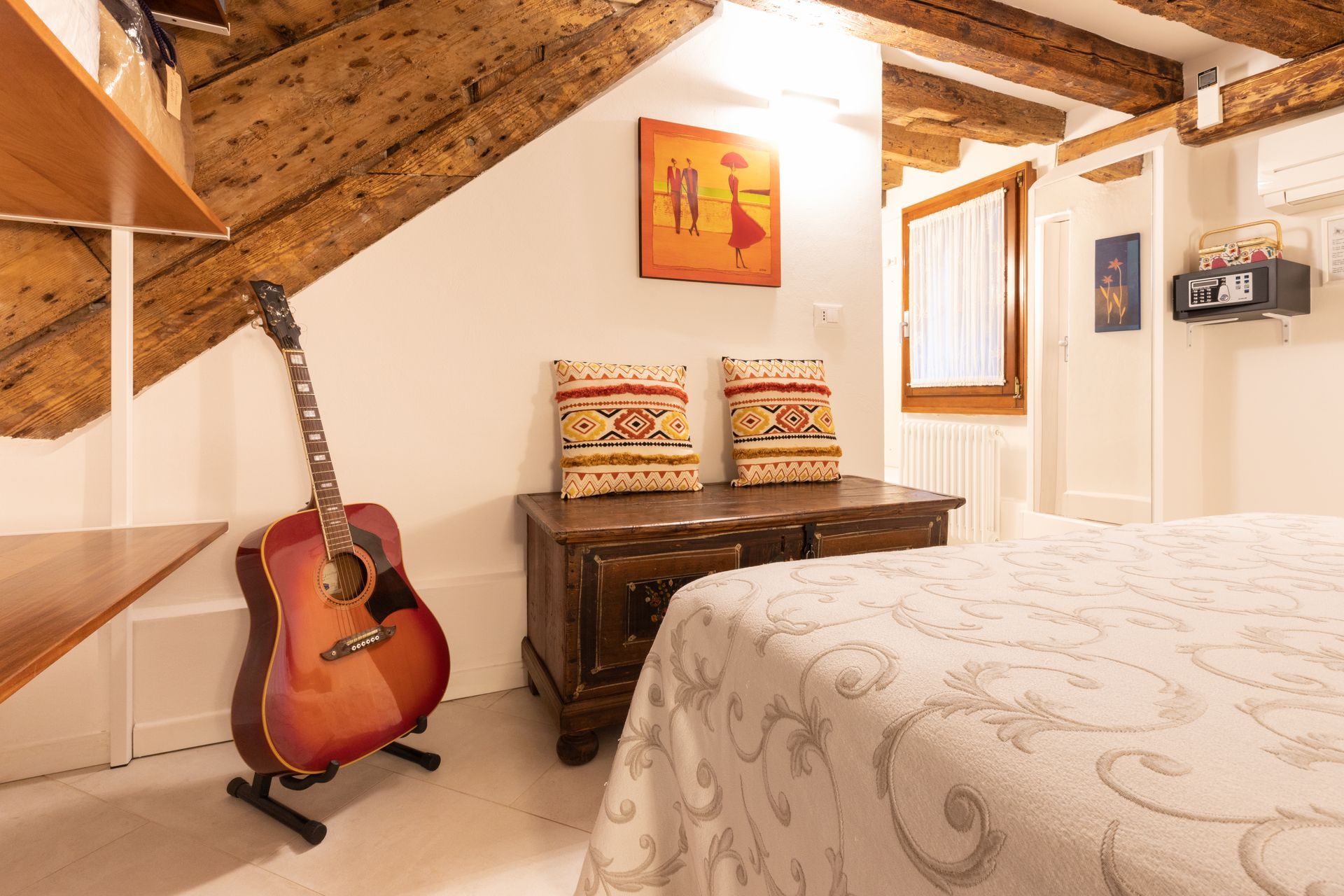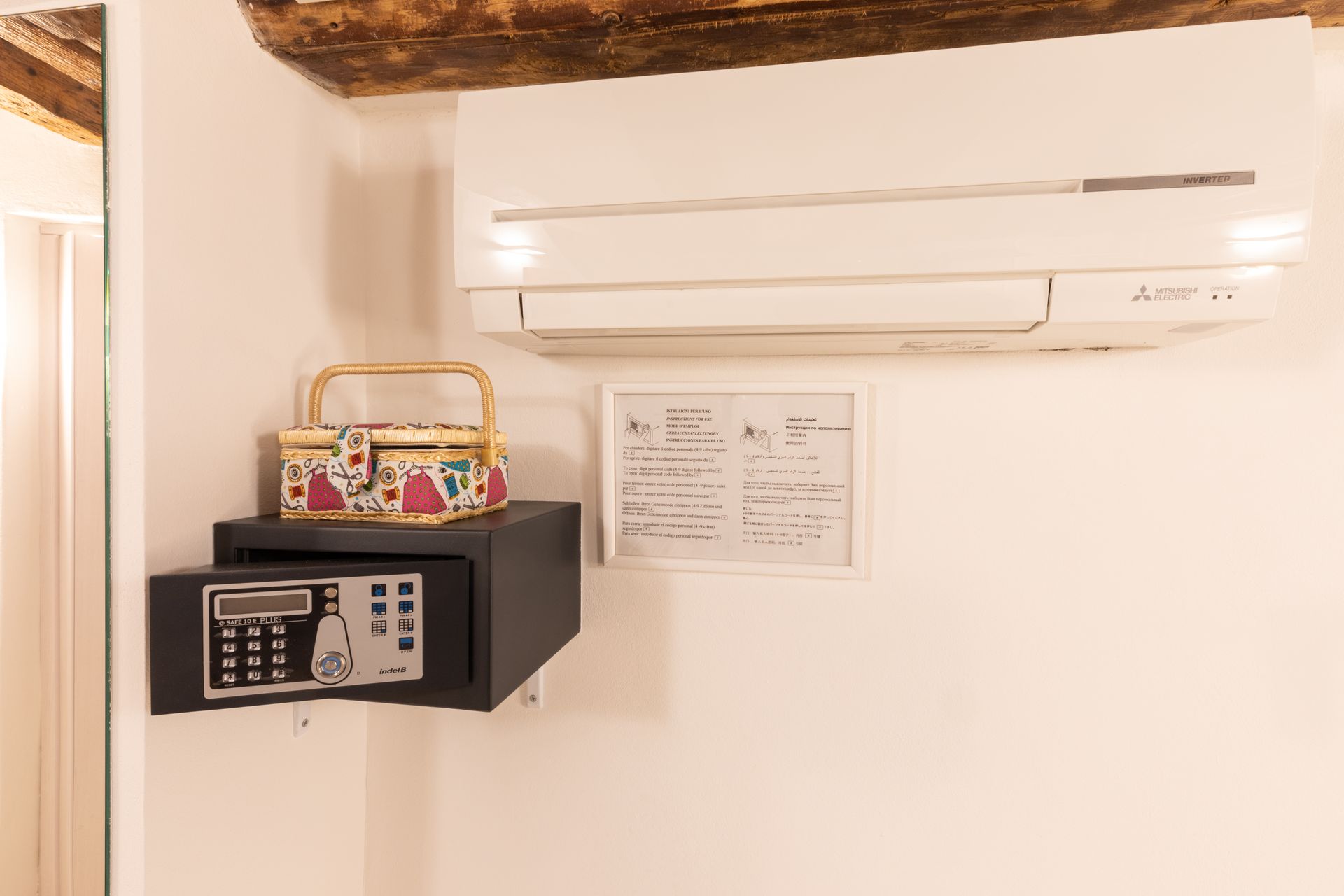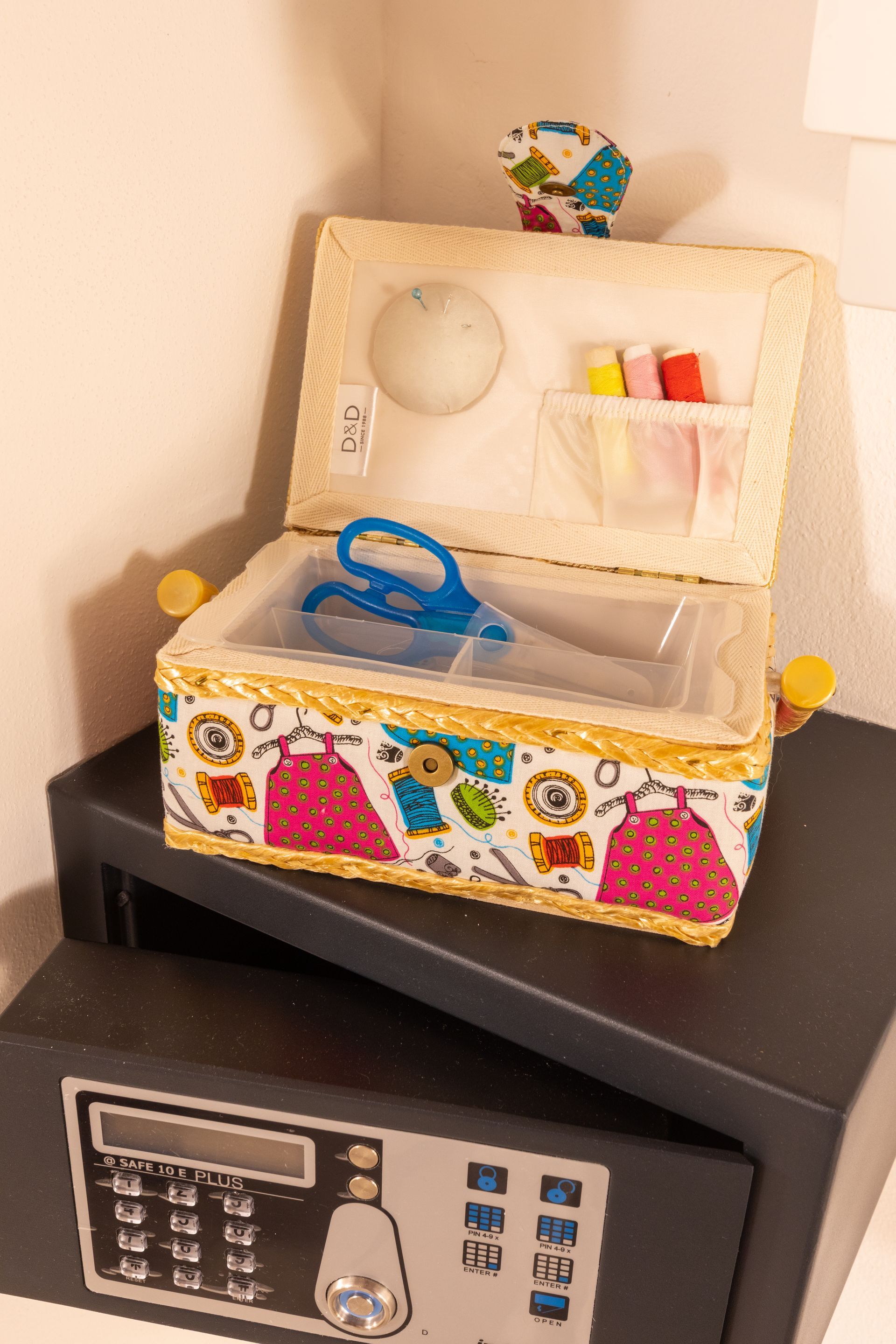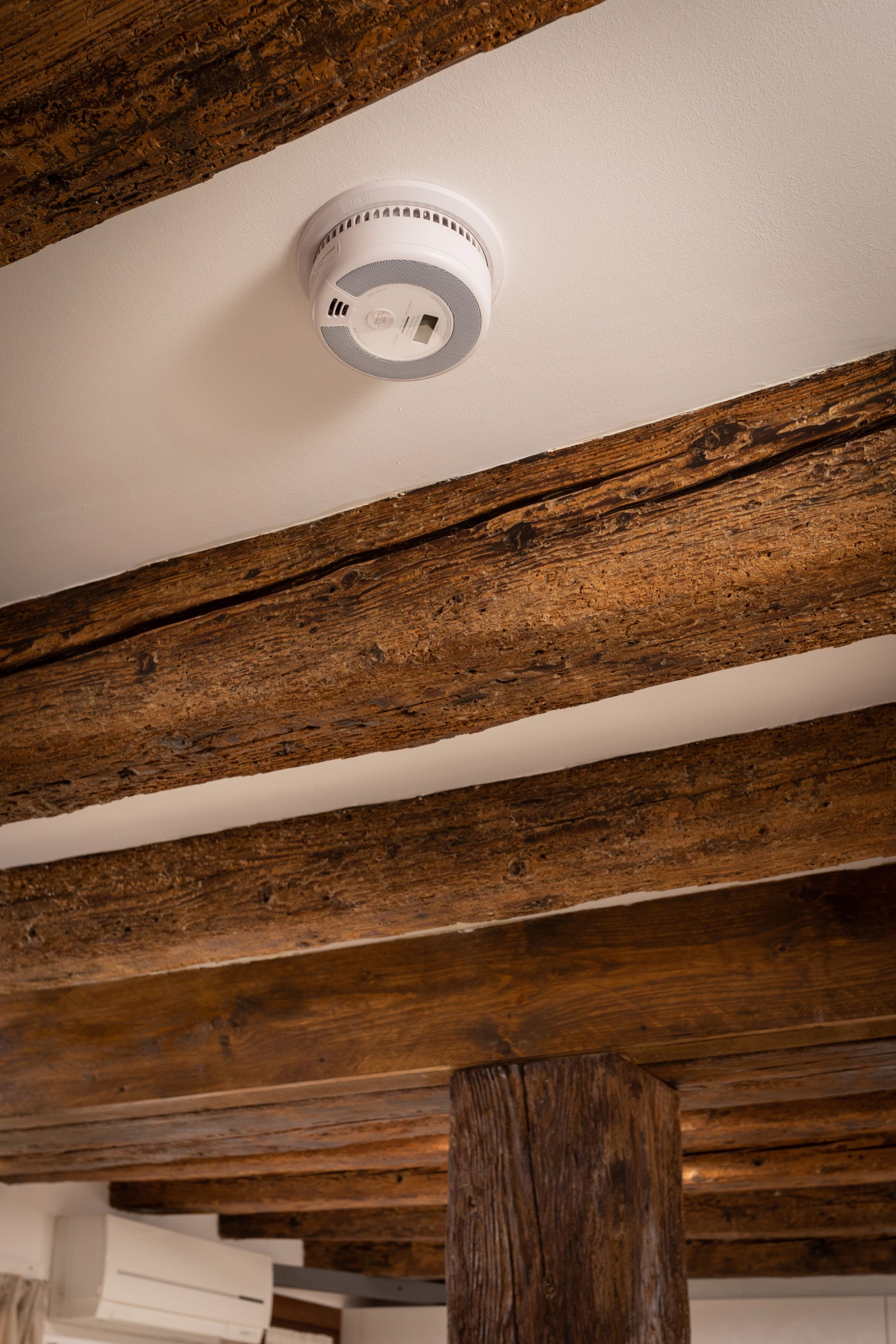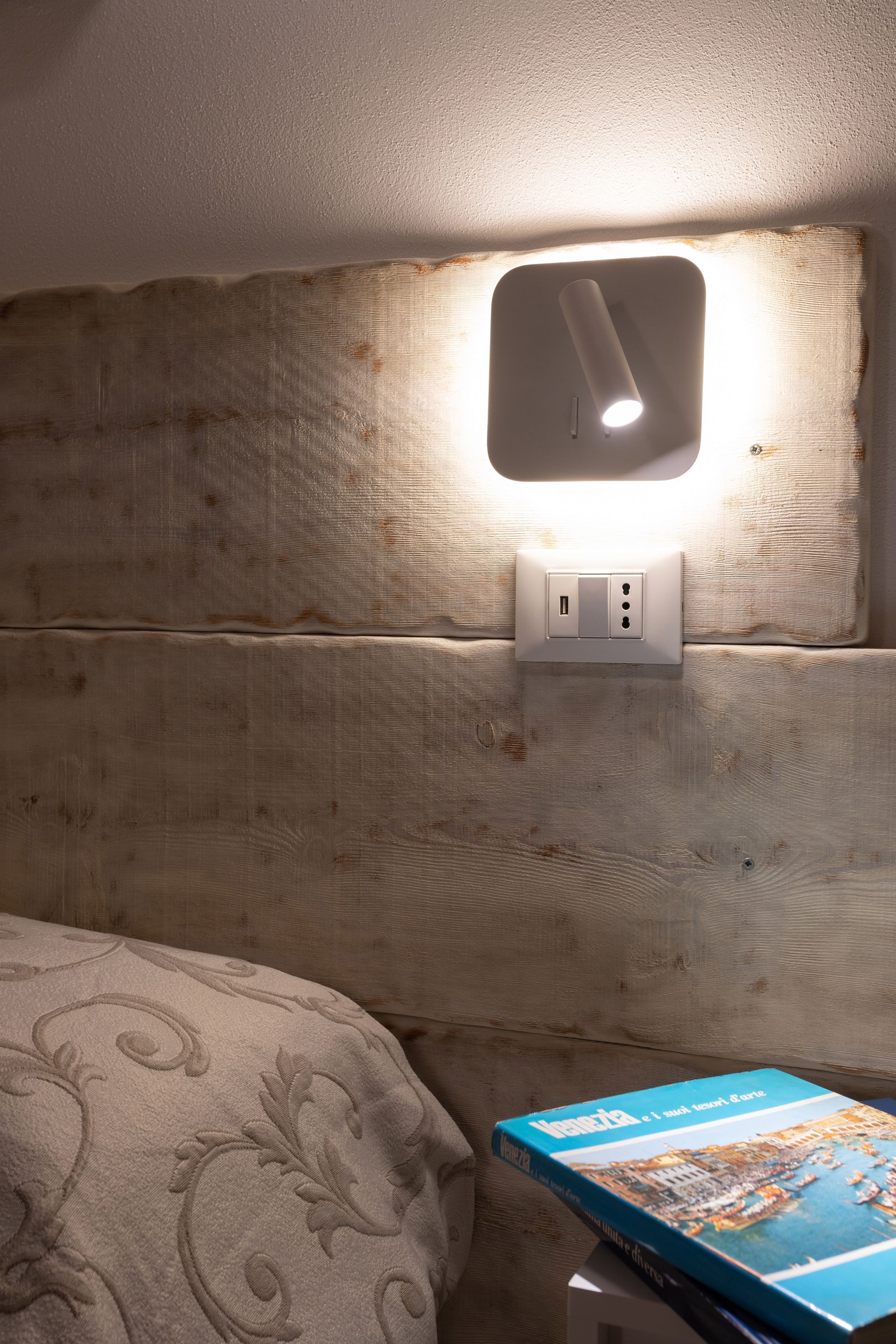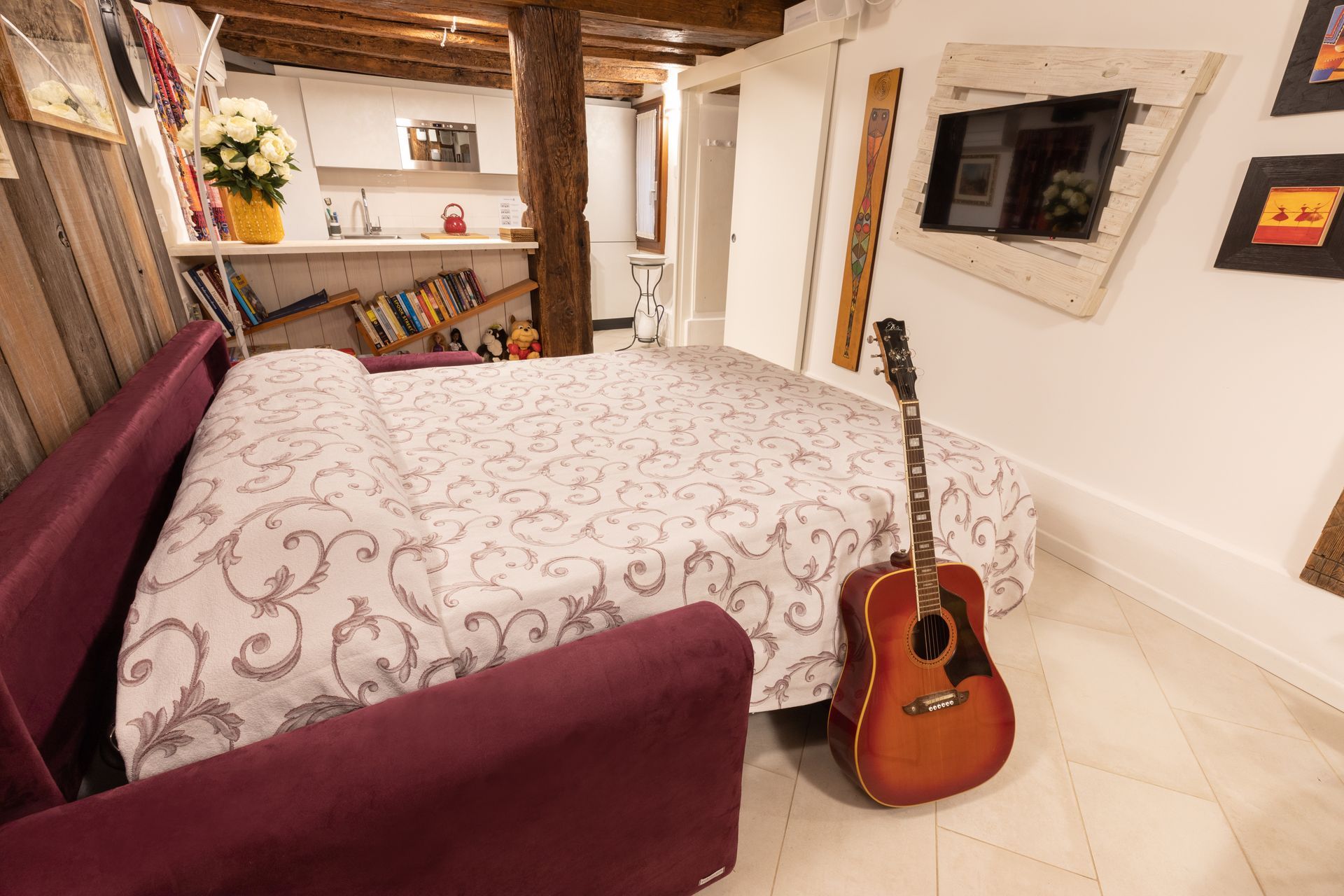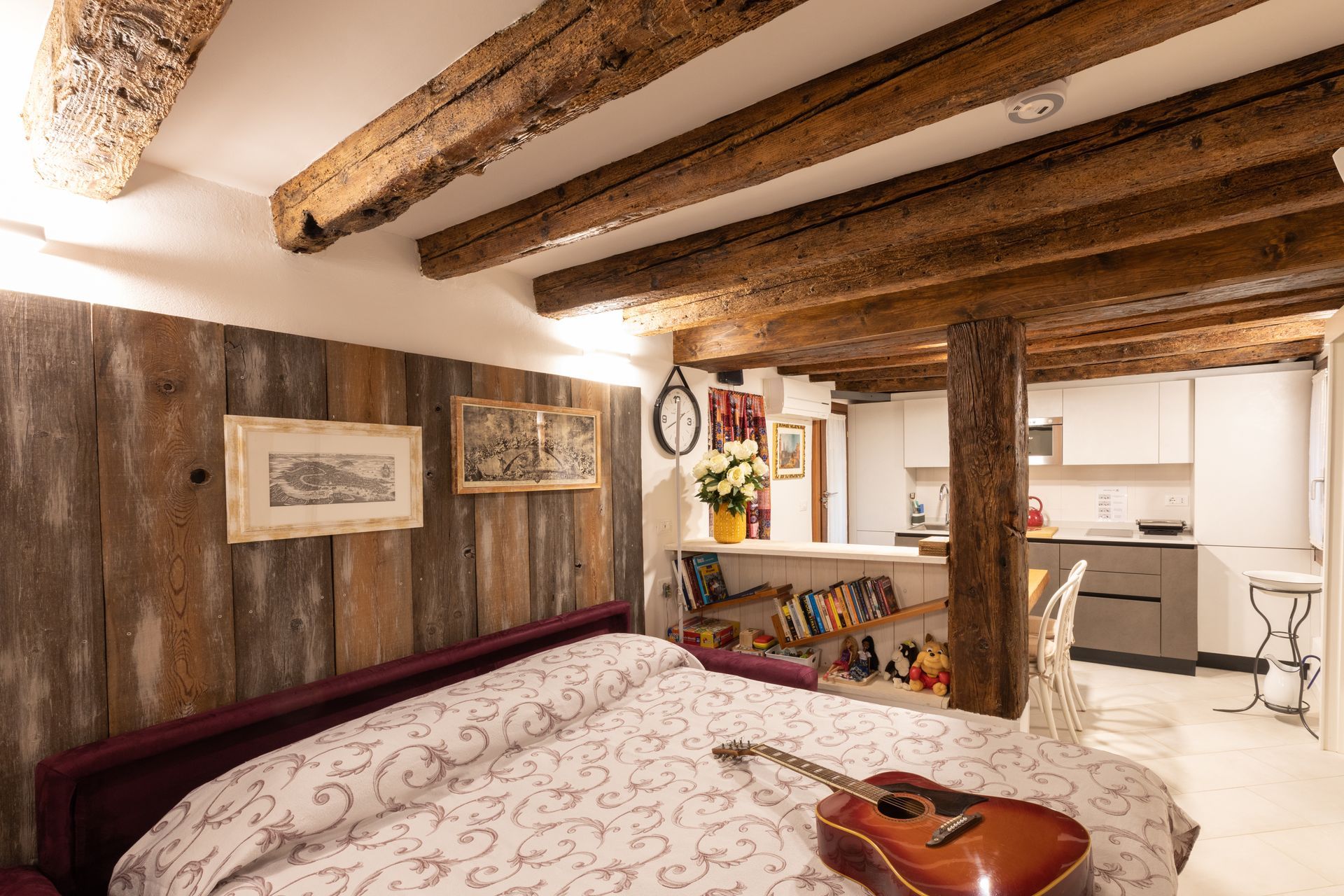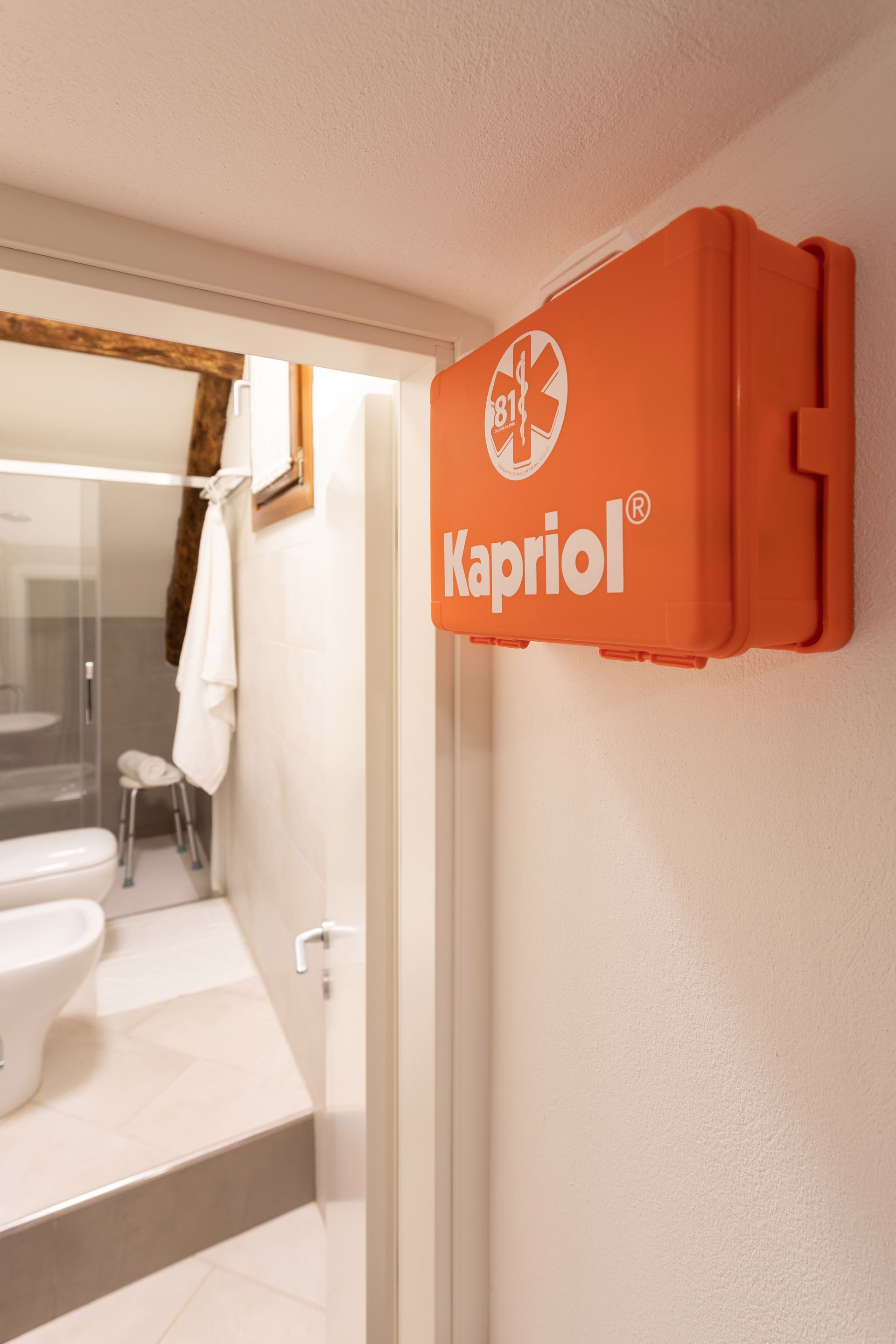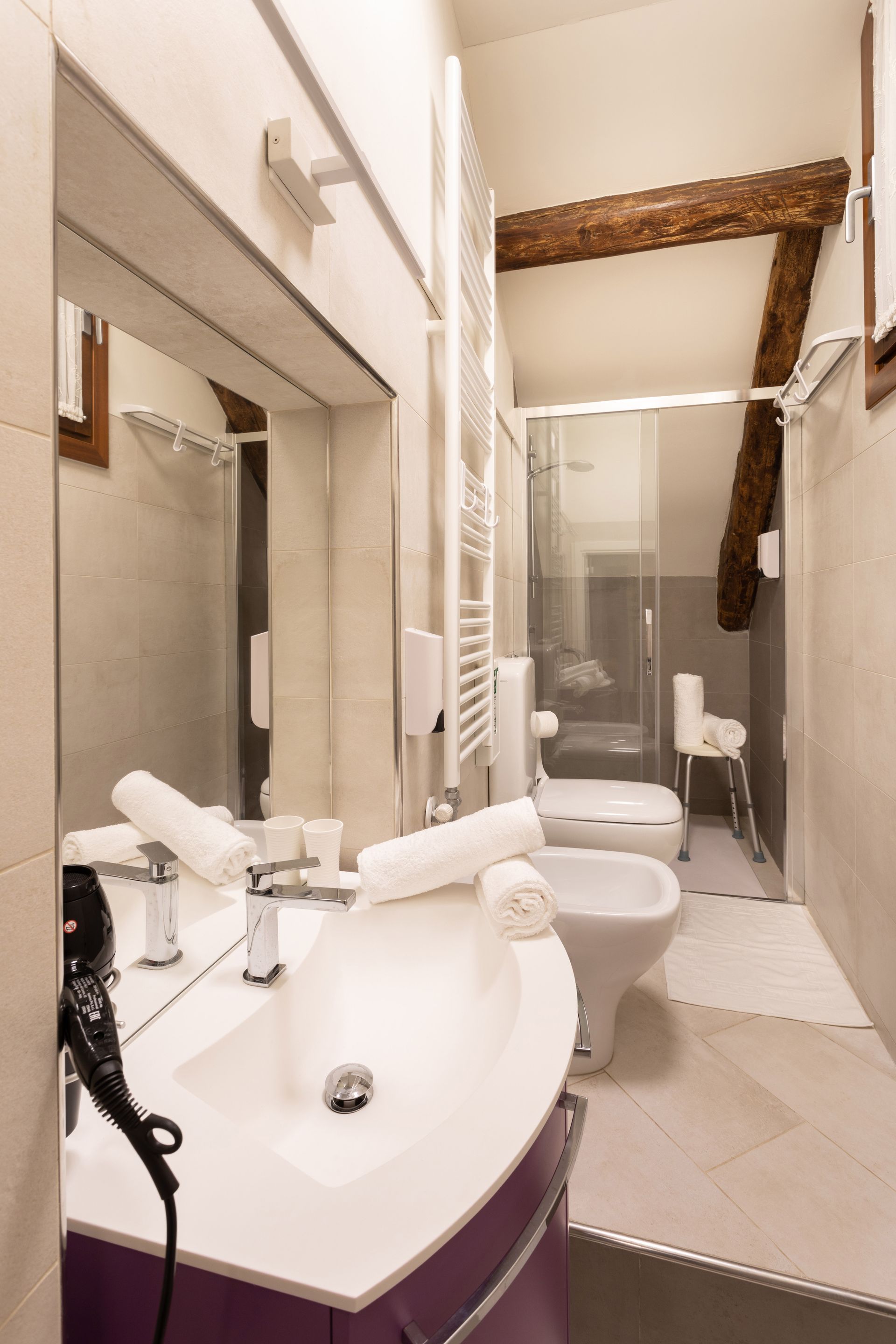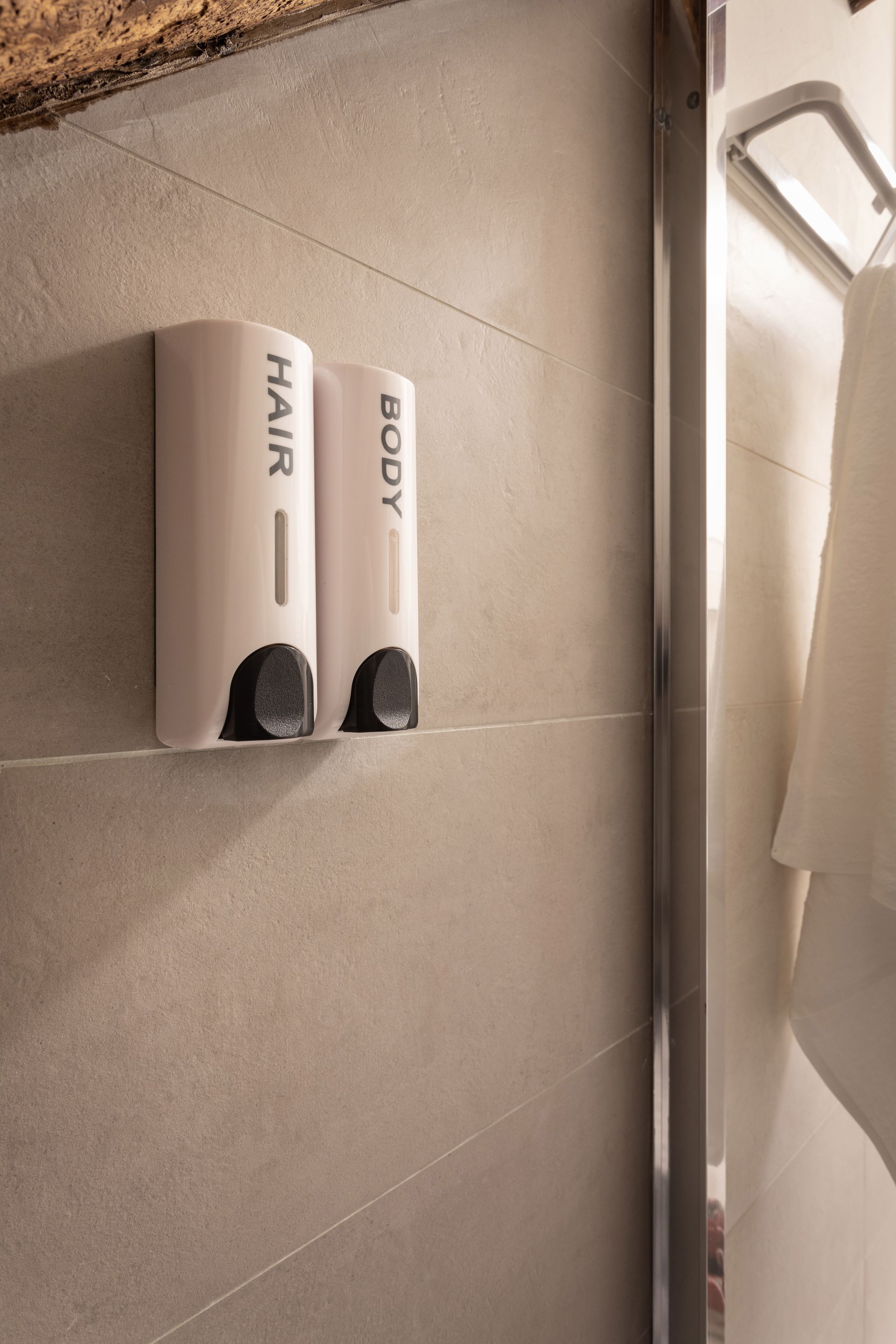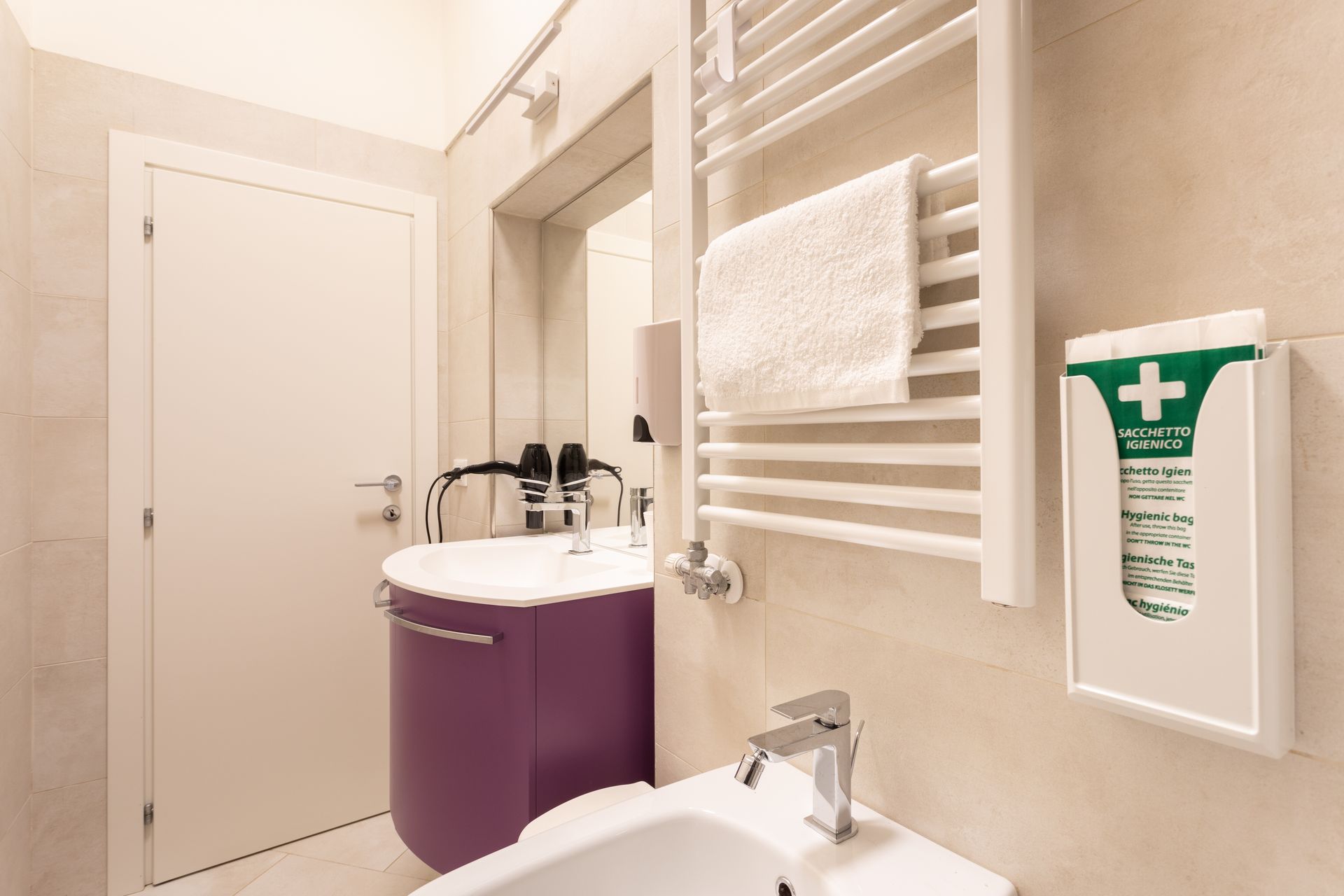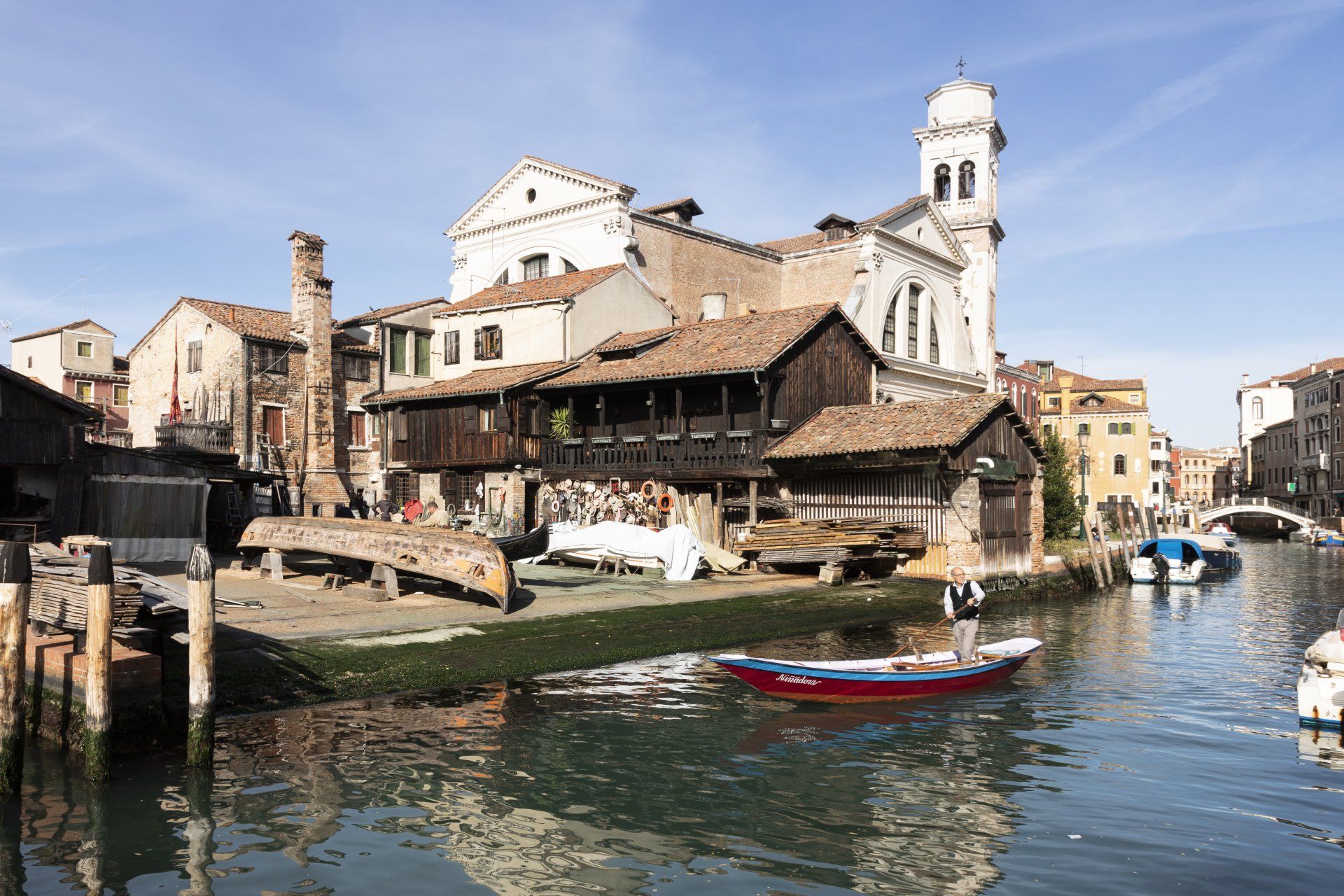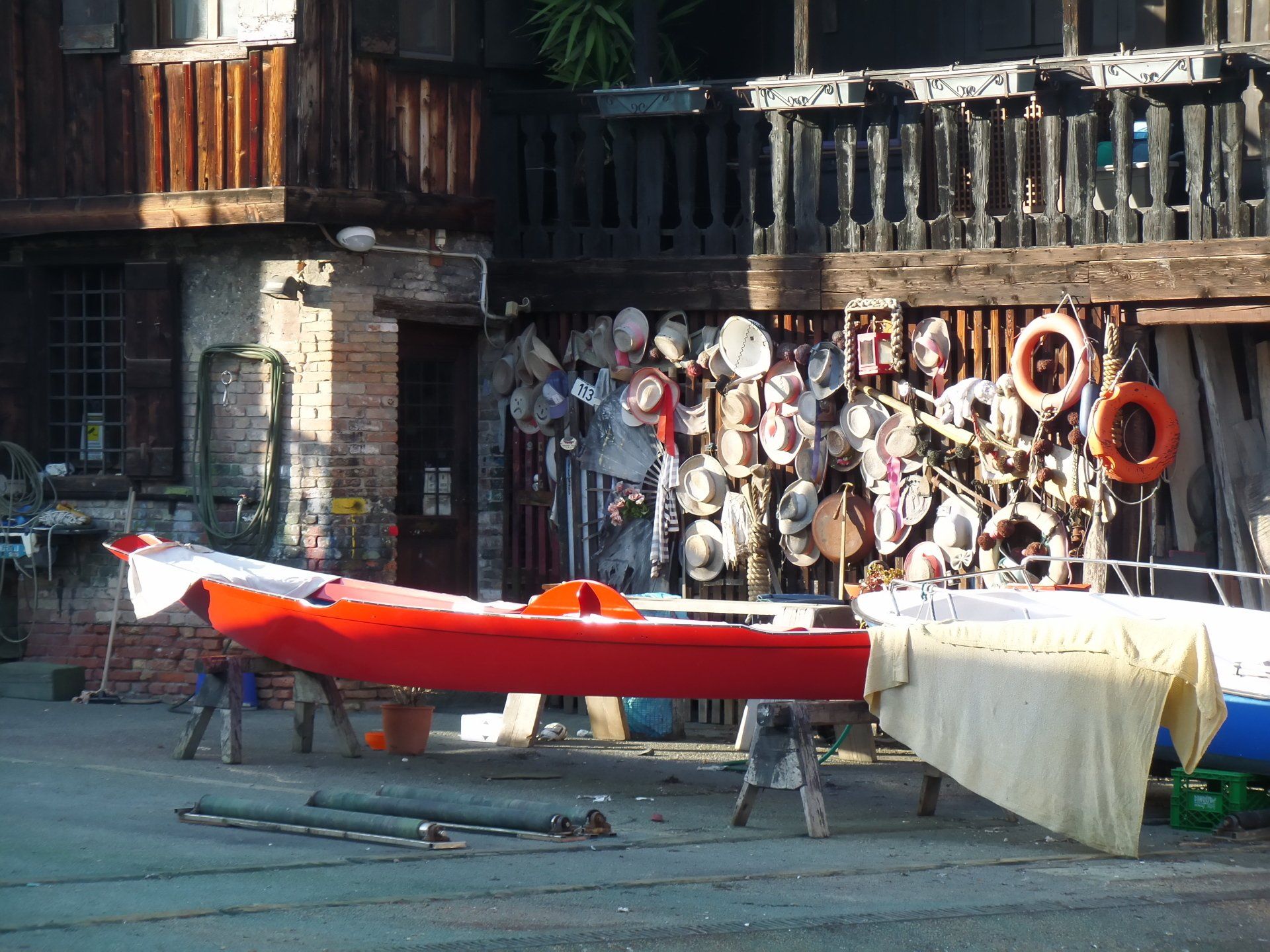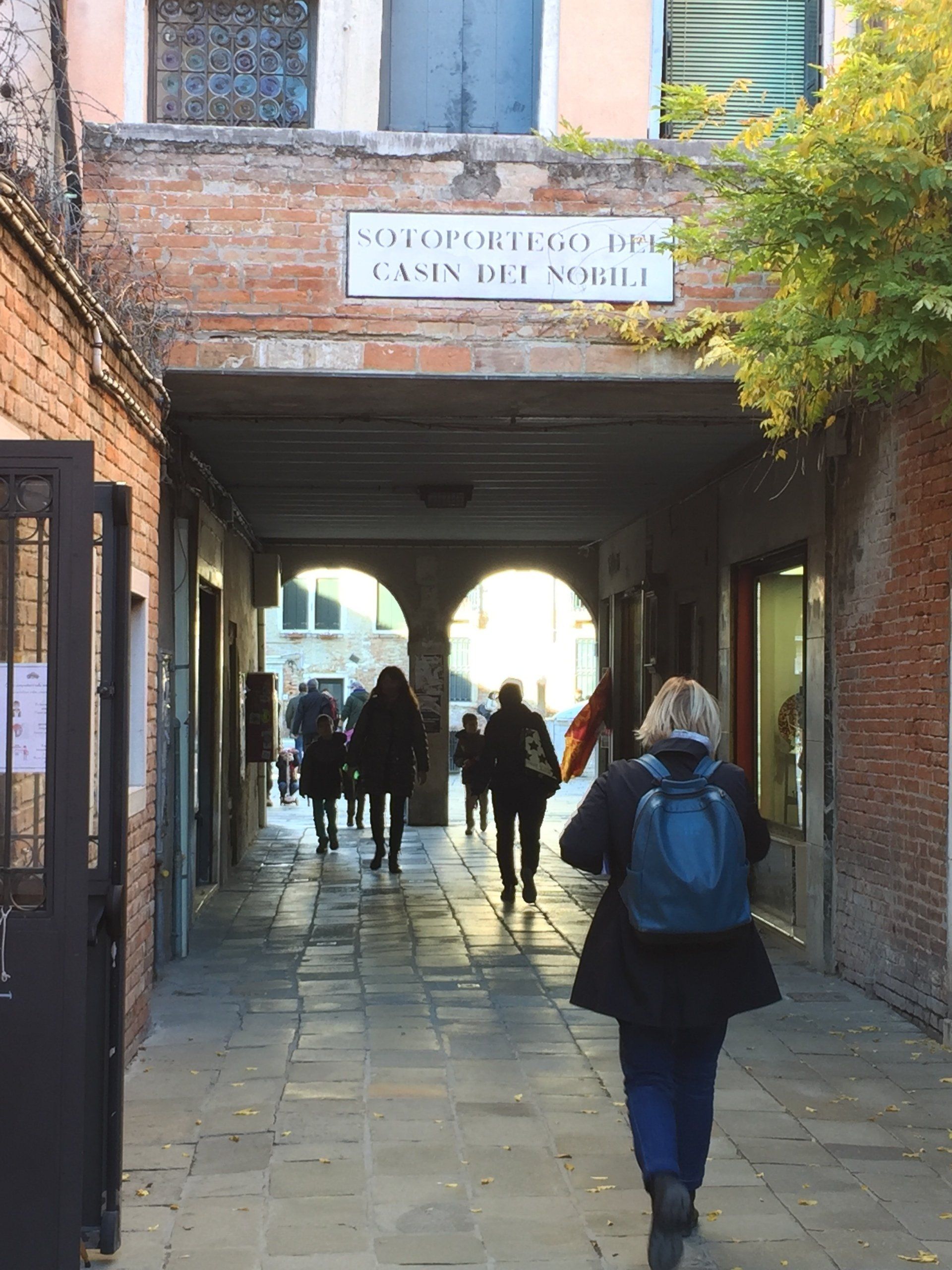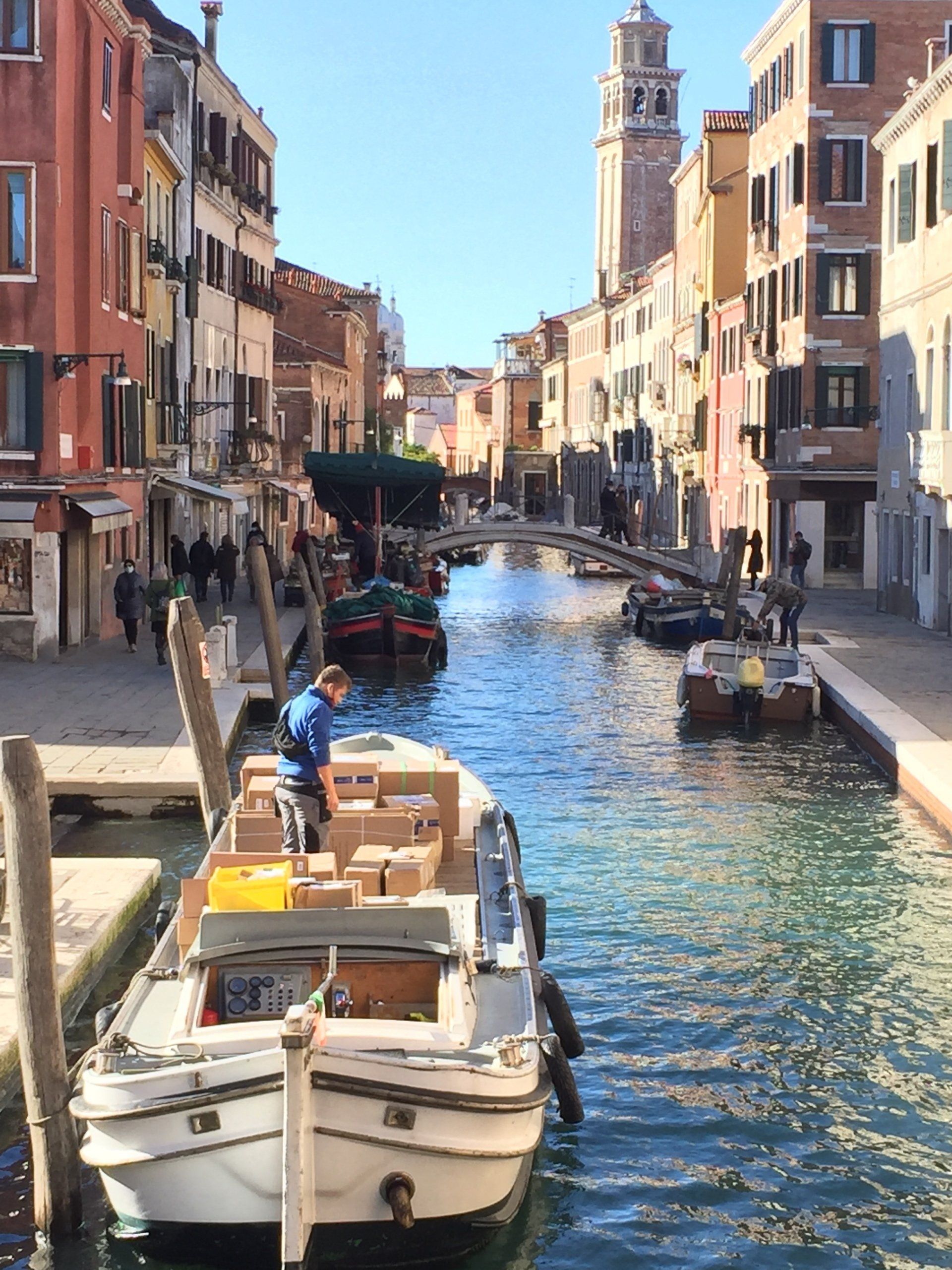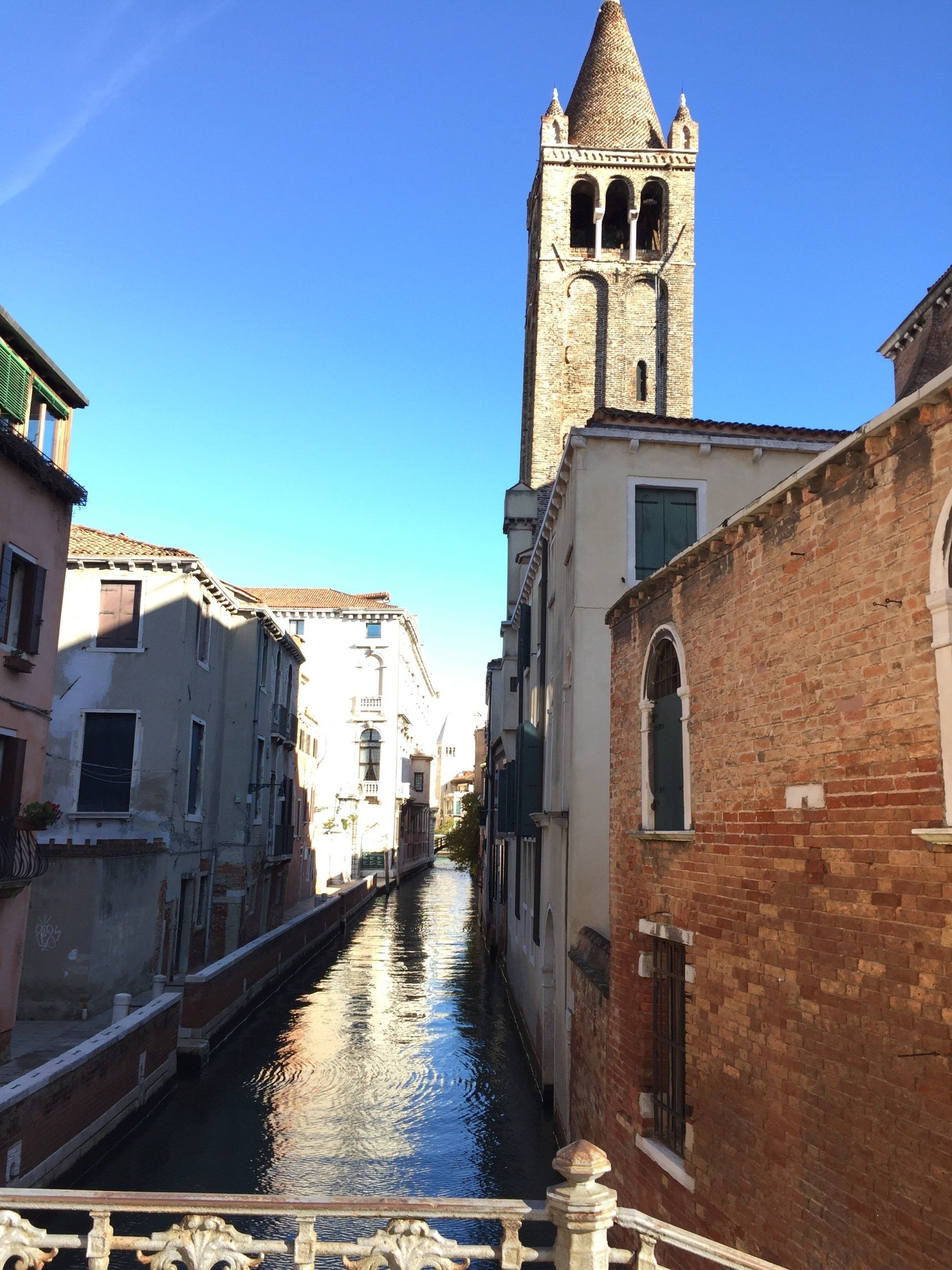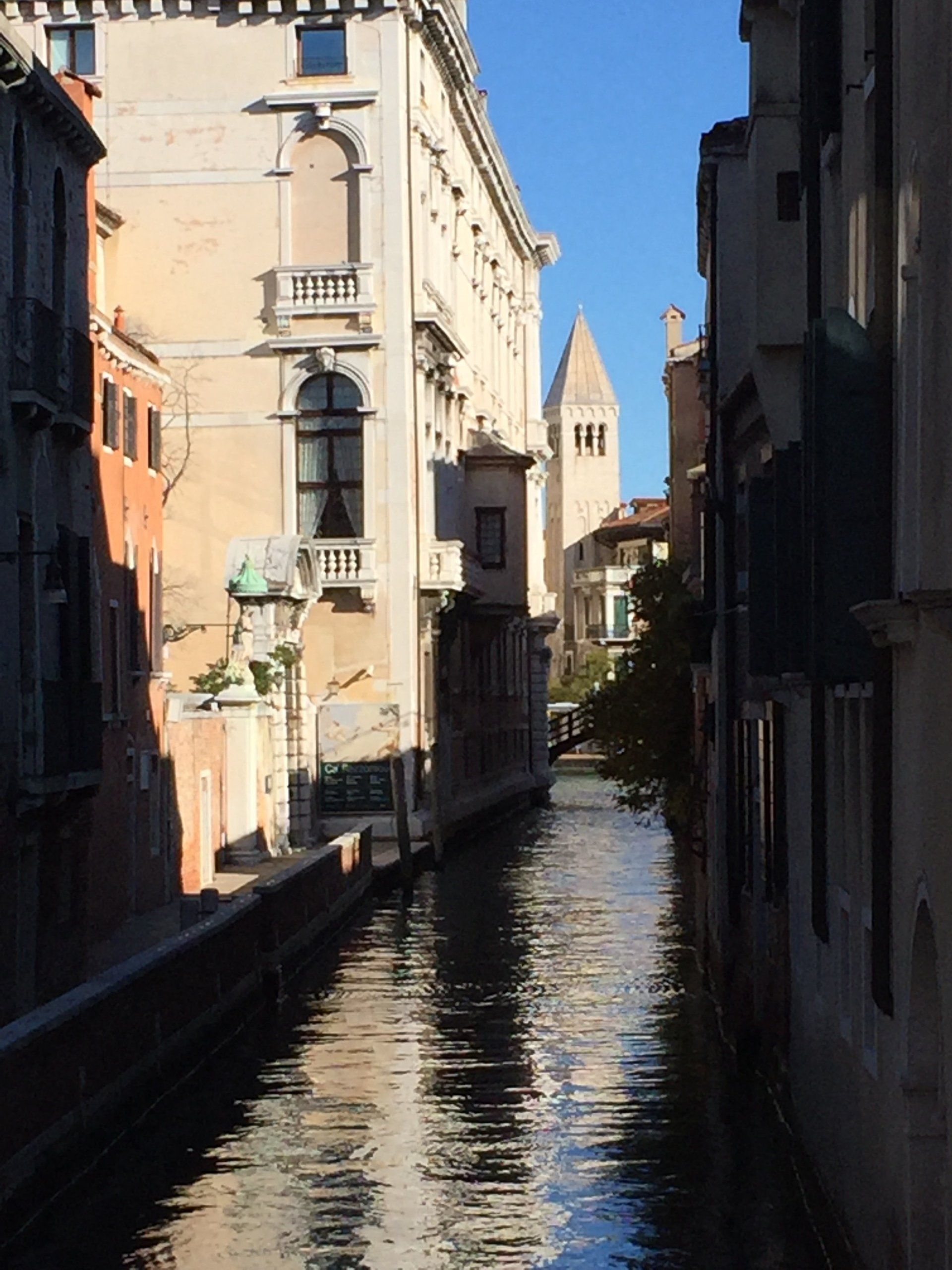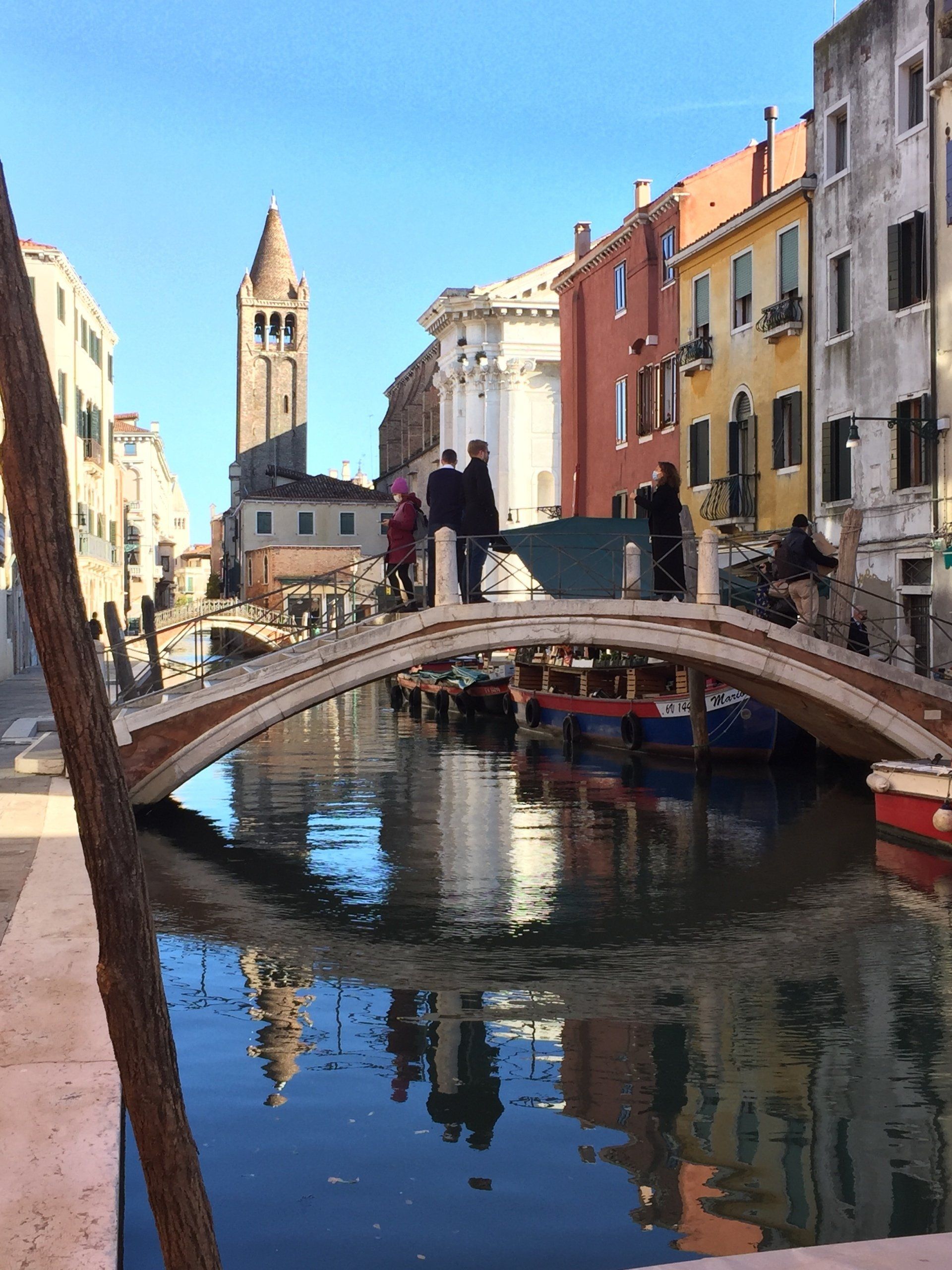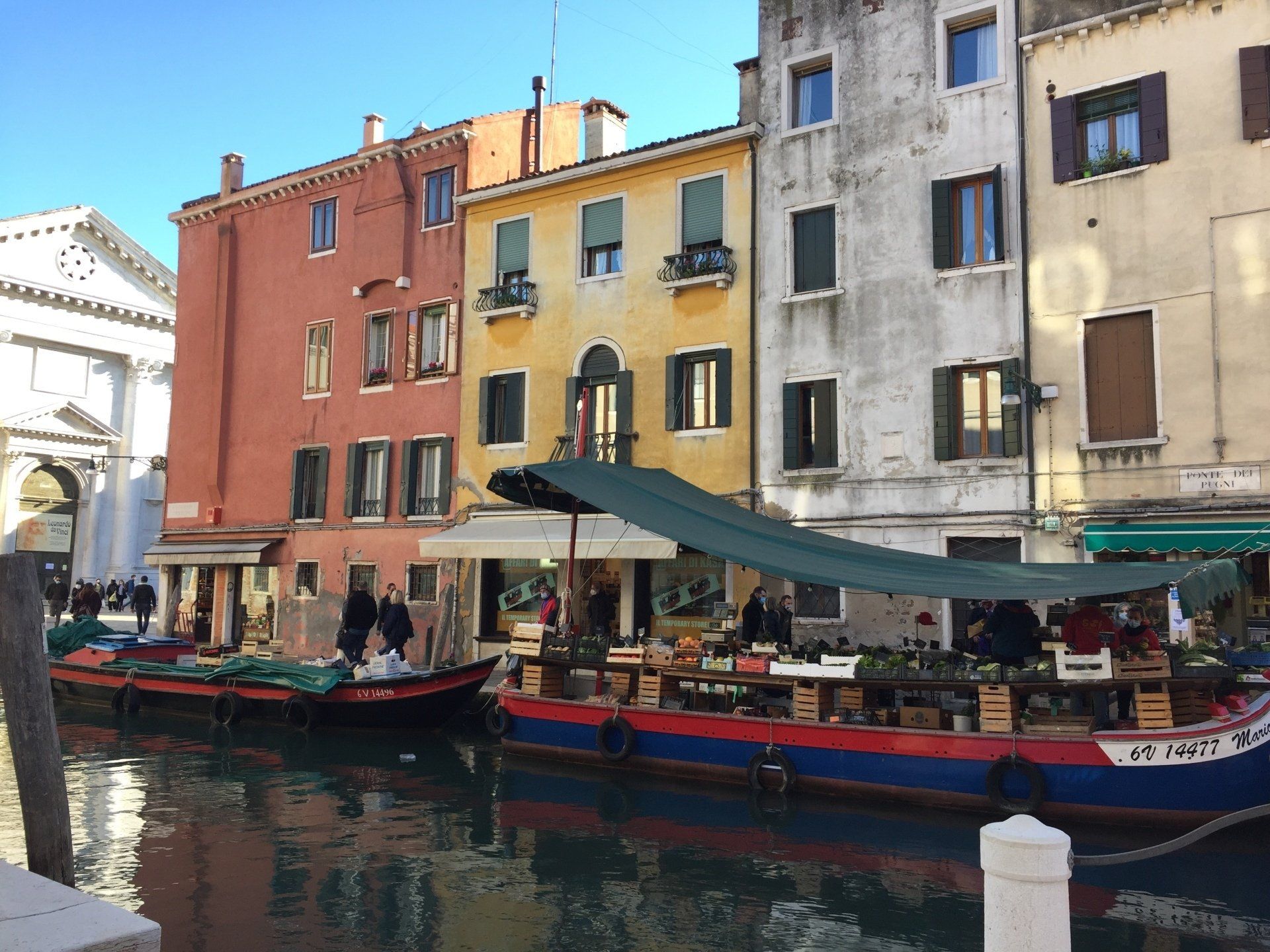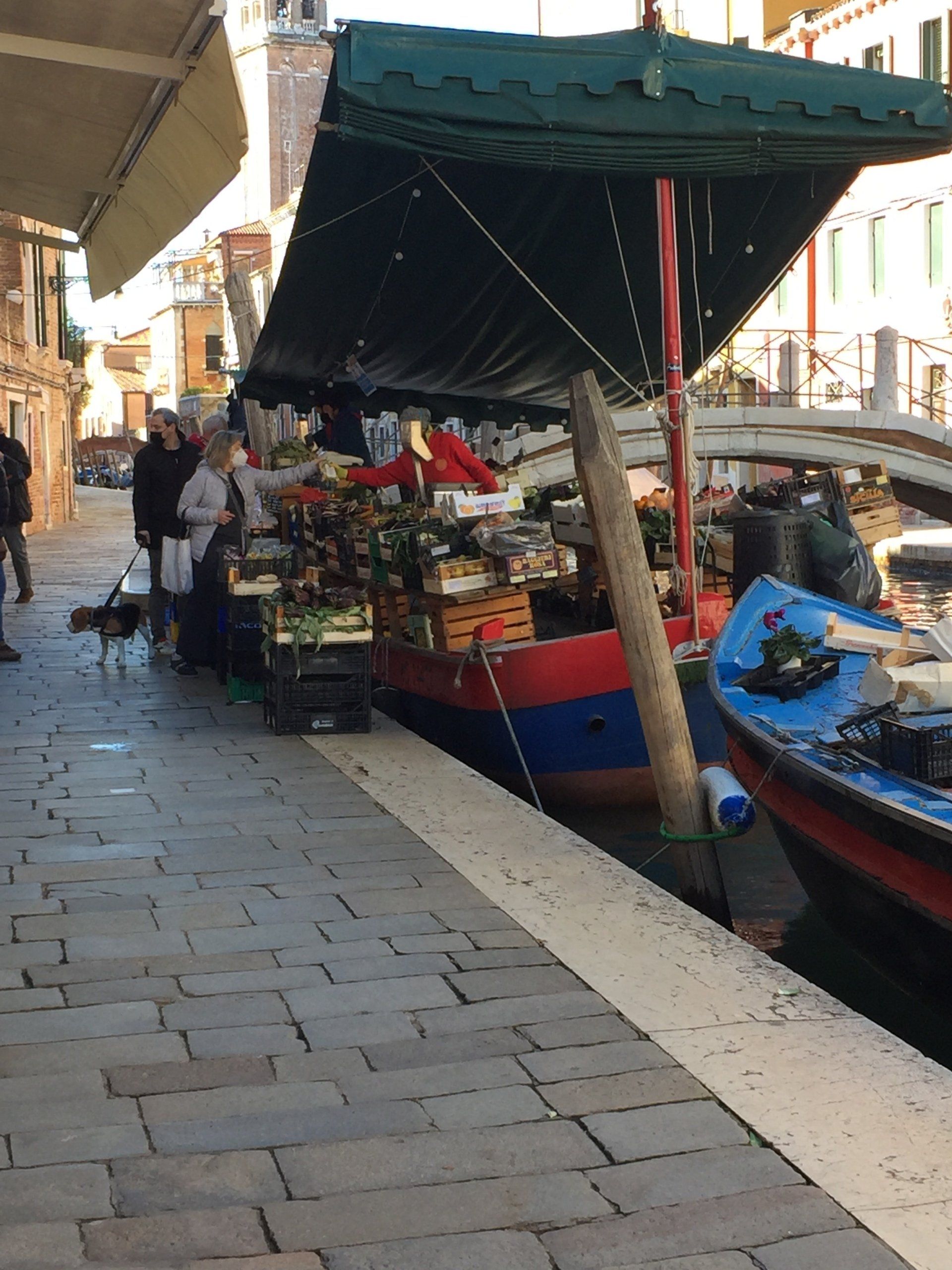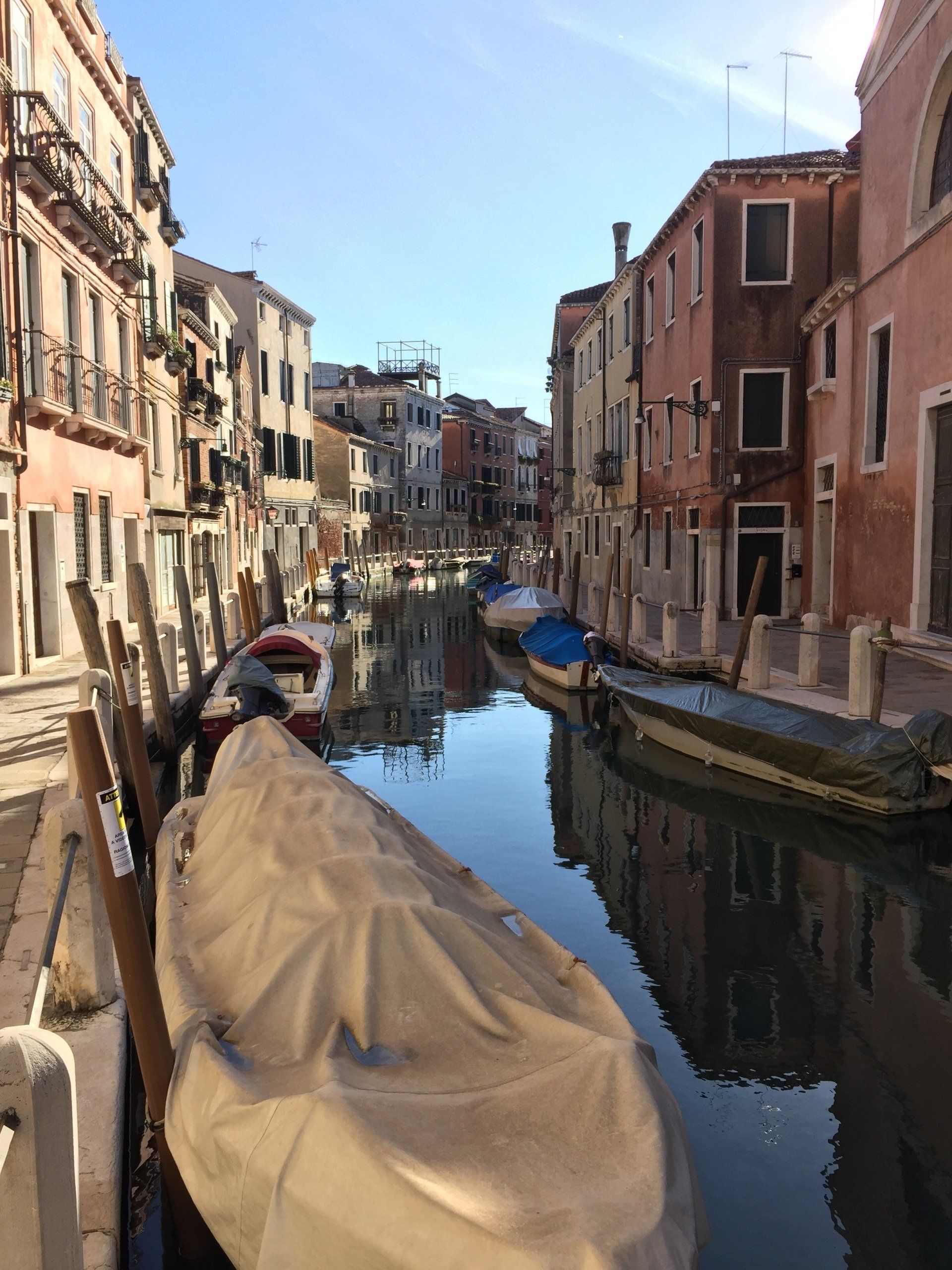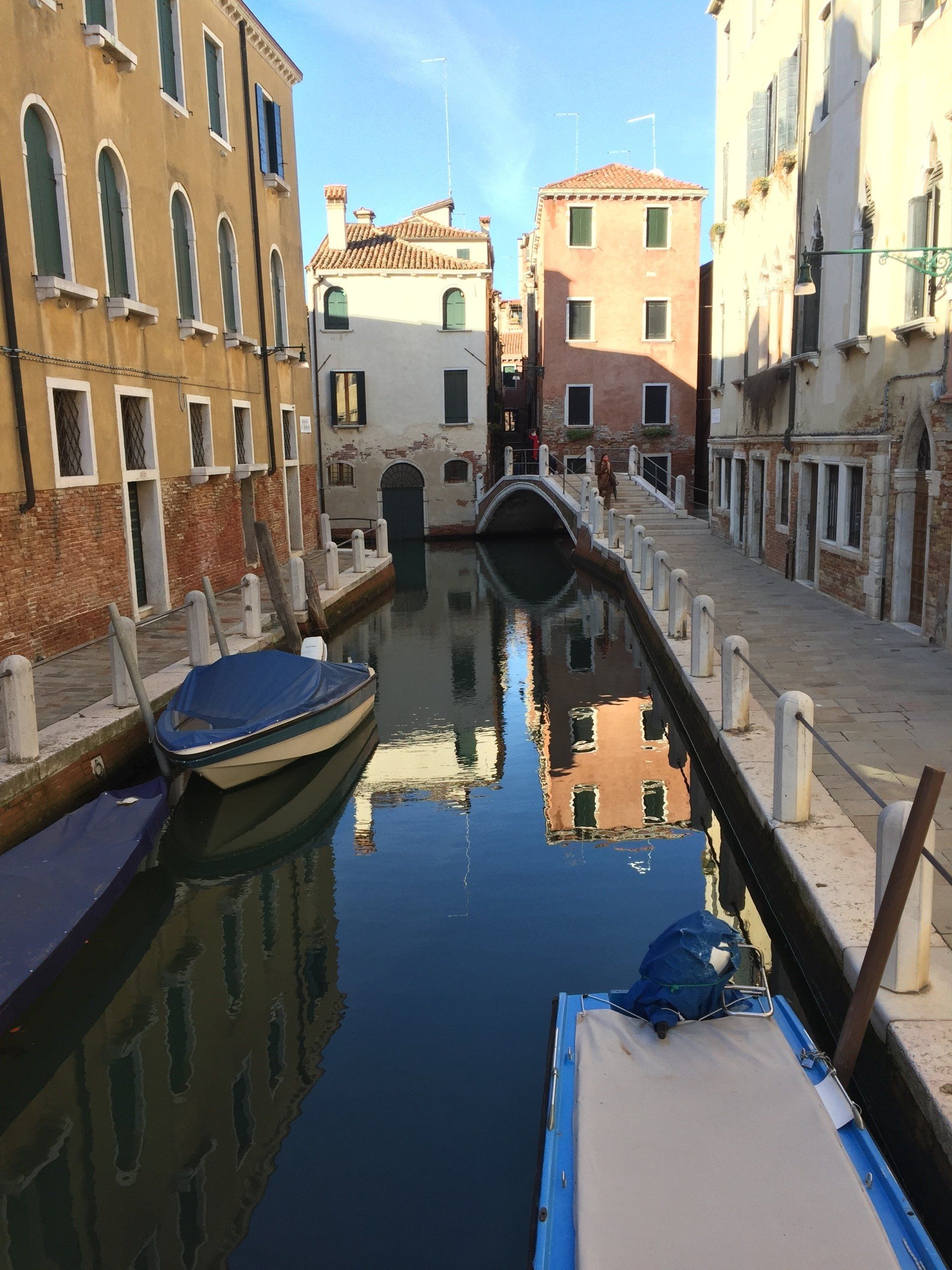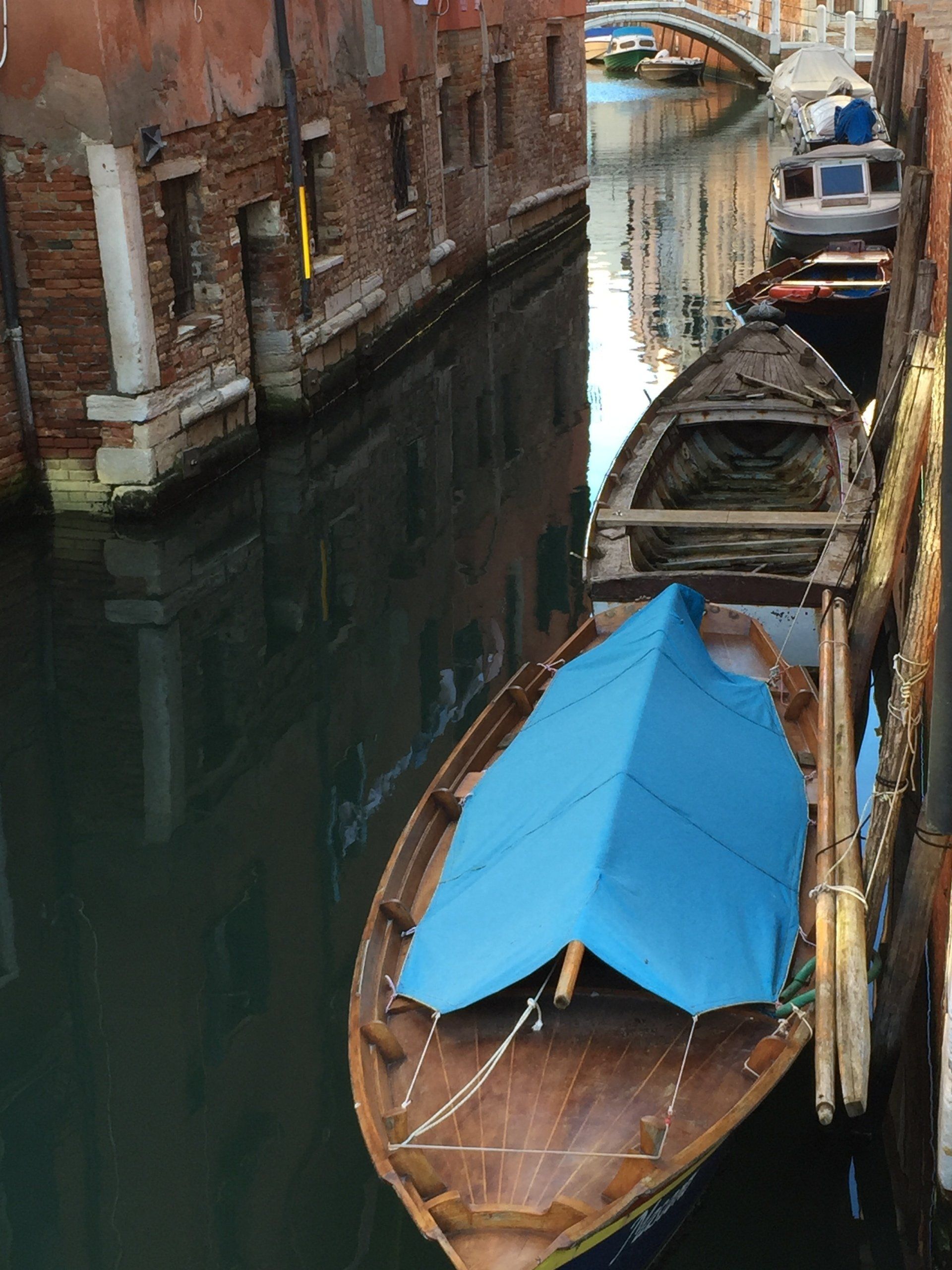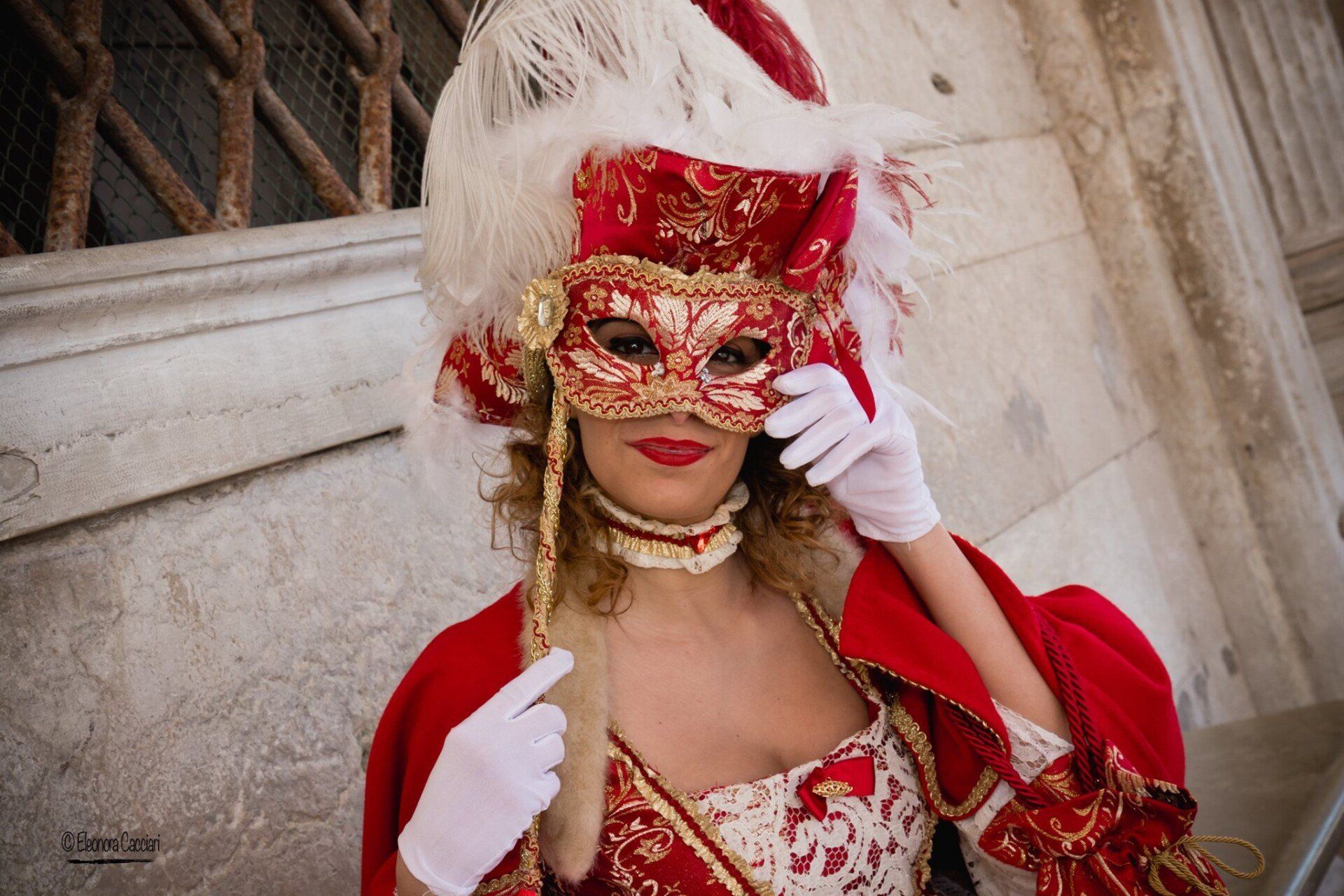The House in Venice
The “Ea casa de mì” apartment is located in Venice Dorsoduro 2725/a. The apartment can be reached on foot or by vaporetto from Piazzale Roma (bus and taxi station) or from the train station. The Ca' Rezzonico vaporetto stop is a two-minute walk away. From Campo San Barnaba continue along Calle Lunga San Barnaba for 30m, then turn left towards “Sotoportego del Tagiapiera”.
The property dates back to the 17th century, located on the ground floor with independent entrance, completely renovated in 2019 maintaining the original exposed wooden beams, with new furniture and floors, it has an area of 50m2 with ceilings just over two metres. The structure includes: entrance, kitchen, bedroom (with double bed 160x200), bathroom with window and shower with seat, bidet, living room with sofa bed (160x200) and two internal courtyards. The apartment is for 2 people with 4 beds, new and compliant electrical system.
Photo
Apartment amenities
- Books in multiple languagesBoard gamesAcoustic guitarDual-split air conditioningUSB wall socketsBluetooth stereo systemFull-HD smart TV, Free Netflix AccountWI-FI 2.4GHz/5GHz freeHeating and hot water
- Induction cookerMicrowave ovenFridge with freezerToasterKettleComplete kitchen kit
- HairdryerShampoo Body washSoapBath towelsToilet paperBed linenClothes airerIron and ironing board
- Safety deposit box First aid kit Smoke and CO2 detectors Fire extinguisher Entrance door with lock and combination Exterior security cameras
Rules
- Pets not allowed Smoking is prohibited inside, it is possible in the external courtyard It is forbidden to hold parties or gatherings It is forbidden to accommodate unregistered people Take care of the house
Services and distances
LOCALS
within a radius of 100 m
- 2 bakeries, 8 bars, 26 restaurants, 3 artisanal gelaterias, 5 pizzerias, 6 bakeries (typical taverns/bars), 3 pastry shops, 2 wine bars, 1 Jazz Club
SERVICES
within a radius of 100 m
- 2 hairdressers3 pharmacies1 laundry1 supermarket 1 book and record shopClothing, Masks..Antique books
PUBLIC TRANSPORT
- Ca' Rezzonico water bus stop 2min (Line 1)Bus/Car Piazzale Roma 20min walkTrain Central Station 25min walkPeople Mover 22min
DISTANCES
- Piazzale Roma 20min.Campo Santa Margherita 3minAccademia Bridge 7min.San Marco Square 15minRialto Bridge 20minLa Fenice Theater 14minPeggy Guggenheim 10minBasilica la Salute 13min
Historical notes
Dorsoduro was at the center of ancient Venice. This part of the city was one of the first to be built as it was located on a small island of compact soil on which houses and artisan workshops could be built. The "Sotoportego del Tagiapiera" street, where the “Ea casa de mì” apartment is located, was the access road to an artisan workshop where Istrian stone was worked. The small square in front of the apartment was used for the display of stone artefacts and, to the side, there was a docking area for transport boats; the apartment itself was part of this laboratory. To date, Dorsoduro and the area surrounding Campo San Barnaba are one of the liveliest areas of the city, with many services and historical monuments.
“Ea casa de mì” is a magical place, where you can peacefully experience the spirit of the most beautiful city in the world, there are no words that can fully describe Venice and its places, only living them in the heart of it leaves a unique and indelible memory. The slow rhythms and everyday life that flows all around are the starting point for an unforgettable holiday.
Position
Contacts
Historical and cultural insights by Carlo Battain
The apartment is located in an area of Venice of ancient foundation in the Dorsoduro district (an eloquent name, as in many cases in the city; it communicates the presence of substantial soils on which to build in the early marshy lagoon environment), located along important axes connecting roads between the Grand Canal and the decentralized Mendicoli area (or Mendigola, among the first to be colonized, prior to the Rivo Alto now Rialto; it must be considered that the formation of the urban fabric occurred gradually through propagation from different areas); this is the long street of San Barnaba between the stream of the same name and the parallel stream of Malpaga.
The calle and the stream take their name from the church of San Barnaba, whose foundation, together with the Gothic bell tower, dates back to the 9th century, entirely renovated between 1749 and 1776 by the architect Lorenzo Boschetti (also author of the unfinished Cà Venier dei Leoni on the Gande Canal, home of the Peggy Guggenheim Collection) pupil of Giorgio Massari, while the Malpaga river descends from the presence of a palace, now demolished, built in the 15th century. by the Captain General against the Turkish armies Fantino Michel, known as Malpaga (believed to be due to an affair linked to the construction of one of his palaces in Ragusa, present-day Dubrovnik in Croatia, in which he appears to have been a bad payer).
The Parish of San Barnaba is therefore very ancient and of considerable importance, included in the defensive system of the Dorsoduro area and the construction took place progressively along the described communication routes (Venice's road system is characterized by the coexistence of pedestrian and water paths). , appearing already outlined in the Gothic era towards the end of the 11th century, including the place where the apartment is located, the calli, under portico and campiello del Tagliapietra (name clearly handed down by the presence of a stonemason's workshop).
The apartment is part of a building typical of historic Venetian buildings, of historical foundation, constantly modified over time*; evidence of this are the construction materials visibly from different eras, the distribution and dimensional conformation of the spaces, the architectural structure with multiple added bodies, some even projecting onto the upper floors (partly clad in wood).
In the house the exposed beams of typical workmanship are evident, with the "notches" traced on the wooden body as markings for recognition during transport by river to the lagoon, a wooden wall covering of a staircase to the floor above left to seen in the bedroom, and, in the courtyards, the edges of the window holes in Istrian stone, the visible brick structure with obvious infilling of openings, which occurred in various periods.
Near the apartment we point out the Museum of the Eighteenth Century Venice in Cà Rezzonico and a short distance away the Accademia Galleries, among the most important in the city and which do not need a description. Along the long calle of San Barnaba there is the Querini palace of the Ugo and Olga Levi Foundation, home to art exhibitions and cultural events; on the foundations of the San Barnaba stream there is the Tito building, branch of the Bevilacqua la Masa Foundation for contemporary art. The Church of San Barnaba hosts the Leonardo da Vinci Exhibition.
From Campo di San Barnaba you can easily reach Campo di Santa Margherita, one of the largest in Venice, much frequented by students and home to youth nightlife, by crossing the famous Ponte dei Pugni, with its characteristic Istrian stone inserts in the shape of foot at the four corners, where the traditional fist fight took place (the bridge had no banks) between the two factions into which the popular classes were divided; the Castellani and the Nicolotti (the former belonged to the eastern area of the city, mostly employed in the Arsenal in the Castello district; the latter, dedicated above all to fishing, were concentrated in the opposite end, belonging to the aforementioned Parish of San Niccolò dei Mendicoli).
Continuing along Calle Lunga di San Barnaba you reach Calle dell'Avogaria, where the Teatro all'Avogaria is located in the lateral Zappa courtyard, a small cultural reality but with a prestigious history founded by Giovanni Poli, in whose memory the theater is named acting school, famous for the rediscovery of the great Venetian tradition (mainly the Commedia dell'Arte) and for the valorization of contemporary dramaturgy. After crossing the next bridge you reach the Church of San Sebastiano with a pictorial cycle by Paolo Veronese.
Also nearby, along the Fondamenta del Soccorso, the Armenian College of the Mechitarist Fathers is located in the sumptuous Palazzo Zenobio, built between the 17th and 18th centuries. in baroque forms by the architect Antonio Gaspari, a pupil of Baldassarre Longhena, a cultural center or venue for events (in 1984 Madonna filmed some filming there for the video clip Like a Virgin); in the monumental garden there is the neoclassical Loggia, a valuable work by the architect Tommaso Temanza, which houses the offices and library of the Study and Documentation Center of Armenian Culture.
Equally nearby is the Church of Santa Maria Assunta dei Carmini, built between the 12th and 13th centuries. with a valuable architecture with a particular projecting side portal, rich in precious works by Cima da Conegliano, Lotto, Palma il Giovane, Ricci, Jacopo Tintoretto, Giovanni Scalfarotto and Giovanni Buora and the adjacent Scuola Grande of the Archconfraternity of Santa Maria del Carmelo with the famous cycle of canvases by Giambattista Tiepolo.
Having mentioned it and being not far away, the very ancient Church of San Nicolò dei Mendicoli, at the western end of the Dorsoduro district, whose foundation dates back to the 8th century, deserves a note. but completely remodeled several times in the 12th century. together with the bell tower; according to tradition it took the name of Mendicoli or Mendigoli due to the extreme poverty of the inhabitants of the area, mostly fishermen (the fantasy-horror film In Venice... a shocking red December by Nicolas Roeg was filmed here in 1973 with Julie Christie and Donald Sutherland).
From the apartment you can easily reach, past the Accademia Galleries, all the main and universally known destinations of the part of the Dorsoduro district called Punta della Salute or Dogana; Palazzo Loredan, exhibition venue of the Giorgio Cini Foundation, the Peggy Guggenheim Collection already mentioned, the exhibition spaces of the Pinault Collection at Punta della Dogana, a contemporary art center of international importance associated with Palazzo Grassi, both renovated by the architect Tadao Ando and finally the seventeenth-century, grandiose Basilica della Salute, built by the architect Baldassarre Longhena as a vote of the Serenissima Republic for the cessation of a very serious plague.
A mention cannot be missed of the nearby large Fondamenta delle Zattere, overlooking the Giudecca canal, which takes its name as a landing point for the river transport of salt and wood flowing into the lagoon; very sunny as it faces south, it is a traditional destination for walks in every season and full of places overlooking the water (one of the best known is the Gelateria da Nico which offers the famous Gianduiotto).
The location of the apartment is therefore extremely favorable for a Venetian stay, fully inserted into the fabric of city life, an optimal starting point for any visit itinerary; easily reachable by public water transport (Actv landing Cà Rezzonico, located at the beginning of calle Lunga San Barnaba) and close to the access area from the railway or car from Piazzale Roma.



